The Quest to Find—and Save—the World's Most Famous Shipwreck
By lucas reilly | jan 9, 2019.
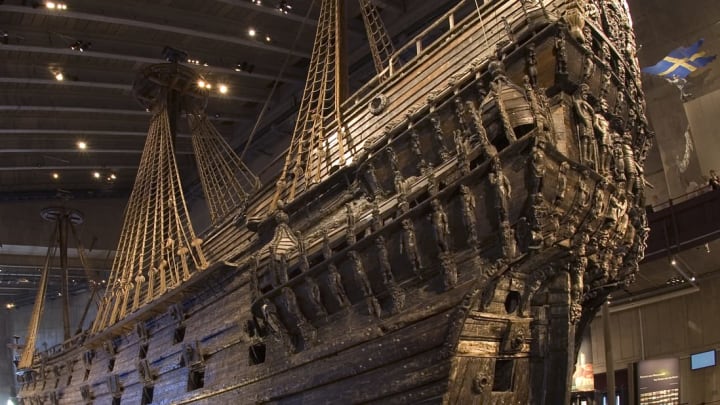
Anders Franzén lived for shipwrecks . An engineer and expert on the naval warfare of the 16th and 17th centuries, he was especially obsessed with the old Swedish men-of-war that had once menaced the Baltic Sea.
When he wasn’t busy at his day job with the Swedish Naval Administration, he’d spend hours combing through archives in search of maps and documents, hoping they might reveal the location of Sweden’s great sunken warships. And when he learned that one wreck might still be trapped, undiscovered, not far from his home in Stockholm, he was hungry to find it.
For five years, Franzén spent his spare time searching for the shipwreck. He had little luck. Trawling the waterways around Stockholm—what locals call the ström —with a grappling hook, Franzén's “booty consisted mainly of rusty iron cookers, ladies’ bicycles, Christmas trees, and dead cats,” he’d later recall.
But on August 25, 1956, Franzén's grappling iron hooked something 100 feet below. And whatever it was, it was big.
Franzén gently lowered a core sampler—a tool used by oceanographers to get soil samples from the bottom of bodies of water—and retrieved a dark and soggy chunk of black oak. The following month, Franzén's friend Per Edvin Fälting dived into the ström and see what was down there.
Fälting had to work blind. Just 30 yards below the surface, the brackish waters were pitch black. The diver ran his hands over the mysterious object and tried to get a feel for what it might be.
“I can feel something big,” Fälting said to Franzén over a diver’s telephone, “the side of a ship. Here’s one gun port and here’s another.”
There was a pause.
“There are two rows,” Fälting said. “It must be the Vasa .”
The Vasa was the greatest warship to never go to war. Named after the Swedish royal family—the House of Vasa—the vessel was commissioned by King Gustavus II Adolphus in 1625 and was earmarked to become his navy’s flagship. Gustavus had big dreams for the Vasa : He wanted the most lethal warship in the Baltic Sea, one that was as beautiful as it was deadly.
For three years carpenters, sailmakers, painters, woodcarvers, ropemakers, and hundreds of other artisans and craftsmen rushed to build the king’s vessel. The Vasa would be a floridly crafted masterpiece with at least 700 delicately carved sculptures, figurines, and ornaments: Angels, devils, lions, emperors, warriors, musicians, mermaids, ghastly faces, heavenly facades—all painstakingly crafted from oak, pine, and lime wood.
The boat’s exterior would be a palpable rainbow (gilded in gold leaf for extra measure). “The hundreds of sculptures clinging and clambering about the Vasa were an orgy of pink naked flesh, of steel-blue armor, of sanguine reds, poisonous greens, and marine blues,” writes Erling Matz in The Vasa Catalog . As Lars-Åke Kvarning writes in Scientific American , these ornaments had many purposes: “To encourage friends, intimidate enemies, assert claims, and impress the world with this picture of power and glory.”
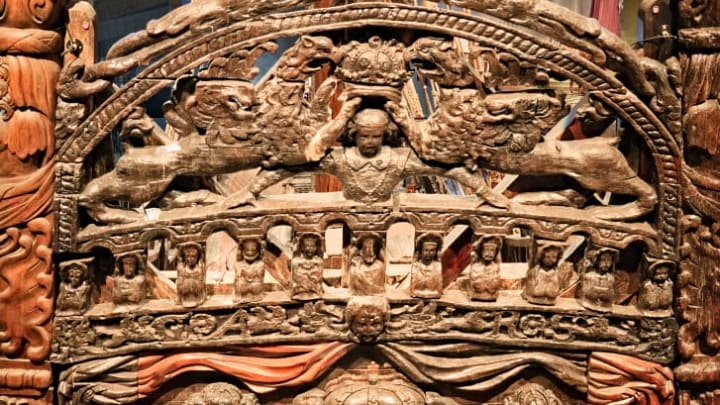
The ship itself was constructed from 1000 oak trees and had three decks, including a stack of two gundecks, which would hold 64 cannons. The design was unprecedented in its size and complexity.
King Gustavus, famous for his military prowess, demanded it. At the time, he controlled “Finland, Estonia, and [Latvia], and he had just won the small part of Russia that touches the Gulf of Finland,” Kvarning writes. “By thus excluding the czar from the Baltic, he had nearly made [the Baltic] sea into a Swedish lake.” He was also juggling multiple wars and was anxious to get his hands on a new warship that would help preserve his dominance. He told the builders to make haste.
It was a foolish decision. In the early 17th century, constructing a functional ship was a matter of trial and error. (And according to Matz, there was a lot of error: In the 1620s, of the 15 naval ships Sweden lost, only two sank in the heat of battle.) There were no calculations to do or construction drawings to make. A new design was usually partially modeled on its predecessors—but the Vasa had none. The shipbuilders had to basically eyeball it. Worse yet, the Vasa ’s master shipbuilder died mid-way through construction.
Baffled by the ship’s giant dimensions, the Vasa ’s architects were never able to confidently determine how much ballast the vessel needed. They filled the hull with approximately 121 tons of stone but believed it needed much more. But the king, who had personally approved the ship’s dimensions, effectively forbade any alterations—and anyway, adding more ballast would have brought the lowest gundeck dangerously close to the waterline.
When the nearly completed Vasa began floating in port, the ship’s skipper, Söfring Hansson, decided to test the boat’s stability. He asked a herd of 30 men to run back and forth across the deck; after just three runs, the ship began to teeter precariously. Some of the ship’s officers wanted to inform the king that the boat was on the verge of capsizing, but Gustavus wasn’t in town. The problem was ignored.
On August 10, 1628, crowds gathered at Stockholm’s waterfront to see the Vasa off. After attending a church service, the sailors—along with many women and children, who were invited to join the maiden voyage—boarded the boat. Four of the 10 sails were unfurled and, guided by a light breeze, the vessel lurched into Stockholm's ström just before 4 p.m. The crowd cheered.
And then it began to scream.
A slight gust caused the glimmering ship to tilt to its left. The Vasa briefly righted itself, only to return to its awkward, portside lean. The captain immediately demanded that all the gunports be closed, but it was too late—water had breached the openings. As one surviving crewmember recalled, “By the time I came up from the lower deck, the water had risen so high that the staircase had come loose and it was only with great difficulty that I climbed out.”
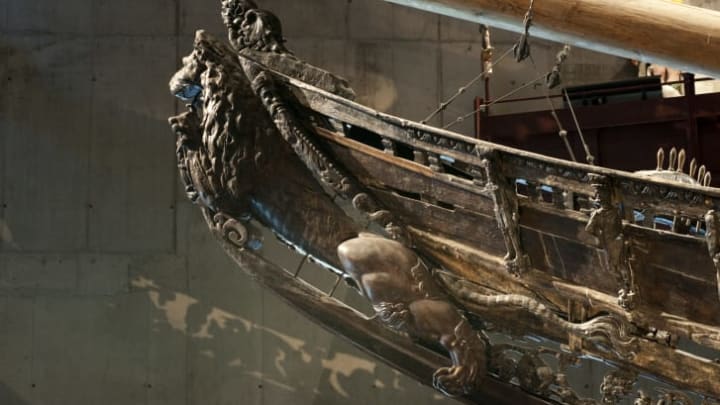
Dozens of men, women, and children began jumping from the ship. Stockholm’s waters became peppered with helpless, flailing bodies. Sailors clambered up the ship’s sinking masts. Within minutes, the Vasa was underwater and 30 people were dead.
The world’s meanest warship had been felled by a gentle gust of wind. It had traveled barely 4000 feet.
Hearing that his prized warship was submerged, Gustavus—who was away in Prussia warring against Poland-Lithuania—demanded an inquest to find and punish the people responsible. The captain and a few shipbuilders were tossed into captivity and an investigation ensued. Some investigators claimed the cannons hadn’t been tied down and had rolled to one side, causing the boat to heel over. (Not true.) Others claimed the captain had been negligent. (He wasn’t.)
The truth was, the Vasa was just top-heavy: If anybody deserved blame, it was the man who demanded such clumsy dimensions—the king. But to implicate an infallible man who ruled by divine right was to implicate God himself. Like the Vasa , the case quickly sank from public view.
There is a secret swirling in Stockholm’s harbor: The water there is too brackish and deoxygenated to support the wood-munching shipworm Teredo navalis . In salty seas, this flat little bivalve will gorge itself on wooden piers, hulls, and shipwrecks—slowly destroying all signs of man’s handiwork.
But not in the Baltic. Wooden shipwrecks remain preserved in remarkable condition. (This is especially true in Stockholm, where, according to the Vasa Museum, “Centuries of raw sewage dumped into the harbor have created a dead zone at the bottom, where even bacteria cannot live.”)
Days after the Vasa sank, Sweden’s Council of the Realm sent a British man down to salvage the wreck, but the mission failed. In 1663, a Swede named Albrecht von Treileben plunged into the chilly ström under the protection of a diving bell and managed to retrieve more than 50 of the ship’s expensive bronze cannons.
After that, the Vasa ’s location was forgotten for 300 years. The closest thing to a salvage mission came in 1920, when two brothers requested permission from the Swedish government to find the ship and turn the vessel’s oak into Art Deco furniture. (The request was denied.)
Franzén, on the other hand, was determined to keep the Vasa in one piece. Problem was: Nobody knew how. Nobody had ever attempted to raise a shipwreck so big or so old.
Crackpot ideas swirled. “One idea was to freeze the Vasa in an immense block of ice and let her float to the surface,” Matz writes. “The idea was then to tow the iceberg to a suitable position and let it melt in the sun, whereupon the Vasa would emerge.” There was even talk of lifting the ship by filling the empty hull with ping pong balls.
Thankfully, Franzén’s discovery generated so much interest in the Swedish media that the navy offered to supply boats and train divers, while the Neptune Salvaging Company generously offered to return the ship to the surface pro bono . Divers would use water jets to dig tunnels beneath the shipwreck. Heavy cables would be piped through these passages, creating a basket that could help lift the ship.
In 1957, the first divers plunged into the ström . Working in complete darkness, they carefully began the dangerous work of hollowing out six tunnels, ignoring the fact that tons of ballast could, at any moment, collapse onto their heads. It was a deadly workplace. “Girders, plans, and other paraphernalia meant that the air pipes and lines could easily get stuck,” Matz writes, “And they did.” (It didn’t help that, as the divers dug, they discovered at least 17 skeletons.)
After two relatively uneventful years, the tunnels were completed. The wires were piped through and strung to two pontoons (cheerfully named Oden and Frigg), which gently lifted the wreck 8 feet off the seabed. Starting in August 1959, crews slowly moved the Vasa to shallower waters and set her back down. They would repeat this motion—lift, move, lower—at least 18 times. After each successful drop, the crews would shorten the wires, ensuring the boat would inch closer to the surface with the next lift.
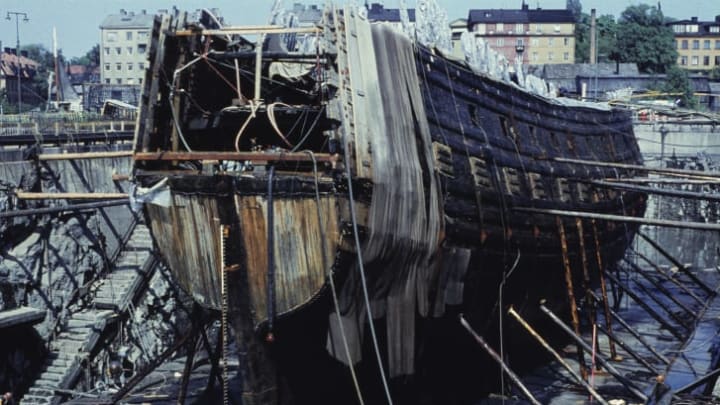
But before the Vasa was allowed to surface, the hull had to be made watertight. The iron bolts that once held the ship together had rusted away, and the salvage crew had to patch and fill those cavities while still submerged. (They also installed new watertight hatches on each port.) This underwater handiwork took two years.
Finally, on April 24, 1961, three giant bilge pumps began purging water from the ship’s interior and the Vasa was, once again, kissed by sunshine. Within two weeks, the Vasa was not only above the surface—it was floating.
For years, the Vasa was housed in a misty, cave-like warehouse. It was there, in the Wasavarvet , that the ship took a rigorous shower in preservatives.
The Vasa 's wood contained approximately 800 tons of water—and it all needed to be removed. Researchers, however, couldn’t simply let the ship sit out and dry, because the waterlogged wood would shrink and split. To prevent cracking, preservationists had to spray the Vasa with a mixture of water and polyethylene glycol (25 minutes on, 20 minutes off) for 24 hours. This process, which came to involve 500 automated spray nozzles, lasted 17 years.
Slowly, water dripped from the Vasa and strings of excess polyethylene glycol trickled down, hardening to form stalactites resembling fine white candles. When the PEG-shower had finished, the humidity in the storage facility had to be gradually cranked down over the course of 10 years.
By that point, archaeologists—who had to be vaccinated against diseases such as jaundice and typhus before touching the boat—had already sifted through tons of mud and sludge in search of artifacts. By spraying down the Vasa ’s decks with garden hoses, they had uncovered more than 30,000 items, including clothes, personal effects, barrels of meat, candlesticks, coins, and a piece of glassware containing a 66-proof alcohol. (“I can testify, from personal experience, that the liquor was good,” Kvarning wrote.) Divers also combed the ship’s watery gravesite to recover thousands more objects.
Of these, every wooden artifact was dunked into a vat of polyethylene glycol solution. Dozens of cast-iron cannonballs—which had rusted so much that they now weighed as much as a Styrofoam balls—were dried in hydrogen heated to more than 1900°F. Six of the Vasa’s crumbling sails, which could only be cleaned while submerged in liquid, were dried in a mixture of alcohol and the solvent xylene. (They took more than a decade to conserve.)
Meanwhile, the Vasa’s sterncastle—the elaborate perch protruding from the ship’s rear—had fallen into shambles. “[W]orkers had to identify and locate many thousands of structural components, ranging from heavy beams to tiny bits of wood—a gigantic jigsaw puzzle to be assembled without benefit of blueprints,” Kvarning writes.
Otherwise, the whole of the Vasa remained in fantastic condition. The fine ornamentations, although missing their brilliant colors, were still magnificent in their details.
Today, there’s still a lot of work to be done. In 2000, the humidity in Stockholm was so high that the presence of soggy museum visitors caused sulfur buried in the ship’s wood to produce corrosive acids. The ship is also shapeshifting. To monitor wood deformation, geodetic measuring devices are being used to map slight changes in the ship’s shape (which is currently settling 1 millimeter every year [ PDF ]). To combat a potential breakdown, carpenters have built a replica of the Vasa ’s hull, which is undergoing a battery of stress tests that will hopefully teach preservationists how to improve the ship’s stability.
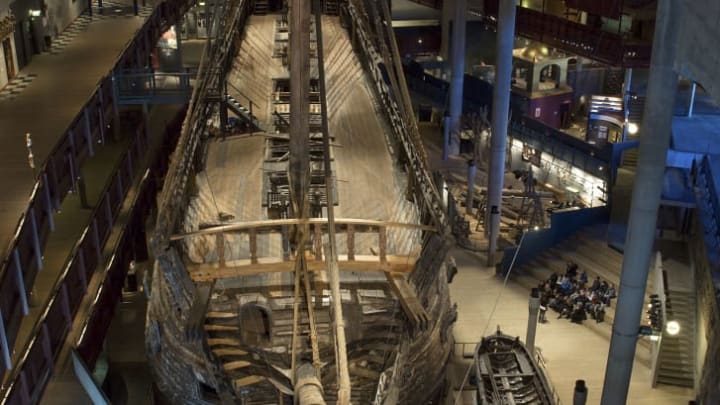
That hard work, however, has already paid off. Today, the Vasa Museum is the most popular cultural institution in all of Scandinavia. Home to the world’s only preserved 17th-century ship, the place is more than a vital time capsule—it’s an homage to an ongoing rescue mission more than 300 years in the making.
Amazon bestsellers to upgrade your cleaning routine, bras and more — starting at $7
- TODAY Plaza
- Share this —

- Watch Full Episodes
- Read With Jenna
- Inspirational
- Relationships
- TODAY Table
- Newsletters
- Start TODAY
- Shop TODAY Awards
- Citi Music Series
- Listen All Day
Follow today
More Brands
- On The Show

Revisiting the world's most famous shipwreck
It’s been nearly 100 years since the Titanic sank to the bottom of the Atlantic. Still, the maritime disaster that took more than 1,500 lives continues to fascinate. Recently Robert Ballard, the man who discovered the ship's final resting place nearly 20 years ago, returned to the site to determine what effect fame has had on the storied ship. National Geographic followed Ballard back to the famous ship in a television special called “Titanic Revealed.” His journey is also chronicled in a new book, “Return to Titanic: A New Look at the World's Most Famous Lost Ship.” Ballard was invited on the “Today” show to talk about the book and his visit to the wreck site. Here’s an excerpt:
Titanic is many things to many people. To some it embodies the overstuffed opulence of the Edwardian era. Poetic souls find the best and worst of human nature in its final hours. Others view its fate as a cautionary tale about the folly of arrogance.
In the years since I led the team that discovered Titanic in 1985, I have watched it play new parts on the world stage. Graveyard. Time capsule. Celluloid star.
Now Titanic has assumed its most crucial role. The magnificent ship rests at a crossroads of history, and the choice of its path will affect undersea exploration for decades to come. On one side of the debate are those who argue that the best route to preserve such wrecks is to retrieve any artifacts that have aesthetic, historic, or sentimental value. They send submersibles to the ocean floor and salvage what they find there. On the other side are those who see Titanic as a wondrous museum to be appreciated without being violated.
Without apology, I can count myself among the latter.
Titanic, nearly 13,000 feet below the surface of the North Atlantic, isn’t going anywhere. Left alone, it will remain a perfect window of life — and death — in 1912. But as deep-sea technology becomes more widespread, the risk to Titanic and other precious shipwrecks grows ever greater. Damaged and picked over, Titanic is less of a ship now than two decades ago. Witnessing what has happened to the stately queen saddens those who wish to preserve her. When I consider the darkest possible future for Titanic, I think of the loss to tomorrow’s generations.
My mind then turns to Gettysburg.
My family traveled to Williamsburg, Virginia, from England in 1635. Family members soon went their separate ways. One branch of Ballards stayed in Virginia’s plantation country, but the patriarch started a new branch in New England. During the Civil War, the descendants of the Virginia Ballards and the descendants of the New England Ballards met at the Battle of Gettysburg in 1863. Both branches counted their own among the 51,000 who died during the bloodiest battle ever fought in the Western Hemisphere.
Perhaps Ballards, Northern and Southern, literally killed one another.
The grounds of Gettysburg National Military Park are well-preserved, thanks to an 1895 act of Congress that established it as a memorial. I have walked the land, contemplating the sacrifices made by my ancestors. Next to a clump of birch trees I came upon a sign marking the farthest advance of Pickett’s Charge, which sent 12,000 Confederate troops into the withering fire of Union lines and began the South’s long fall.
When I saw that sign, I cried. The realization that I stood where history turned, where thousands died in acts of courage, honor, and devotion, opened the gates of emotion. I was there on the very spot, as my ancestors had been in their final moments, and I was transformed by the experience.
So it was with Titanic. I had not planned to cry when I visited it either, but I did. A sense of the continuity of history overwhelmed me.
In 1986, one year after watching Titanic magically appear in the video monitors of the research vessel Knorr, I returned with a science team and explored the wreckage in Alvin, a three-man submersible. At the end of our eighth dive, we left a memorial plaque on the stern, where so many of the ship’s passengers died. As we ascended, I focused a camera on the plaque. Higher and higher we rose, and yet the image of the plaque stayed centered in the video screen. The polished metal gleamed against the darkened, rusty, silt-covered poop deck. I realized then that tears were pouring from my eyes.
To witness the Titanic in those silent depths, to feel so close to tragedy, was just like visiting Gettysburg. Each scene represented a dark moment in history. Each still speaks to us over the gulf of years. The loss of Titanic resonates with our modern world whenever we feel a loss of innocence. The death of John F. Kennedy. The shocking destruction of the space shuttles Challenger and Columbia. The terrorist attacks of September 11, 2001. Such events shake our optimism, our confidence, and our belief that human beings control their destiny. Yet we would not want a world without Titanic or Gettysburg. Saving them, and all their rich meaning, guarantees that voices of history will speak to our grandchildren.
Ensuring Titanic’s preservation was at the heart of the expedition I undertook in the summer of 2004. I wanted to document the damage of the last 18 years, demonstrate a better way to appreciate Titanic, and beat the drum of public opinion to give the ship the same kind of protection that has shielded other national and international treasures. I wanted to make Titanic a test case for dealing with the thousands of shipwrecks still lying unexplored in international waters.
That was a tall order, but one I relished. The mission of a lifetime began with a return to Titanic.
Excerpted from “Return to Titanic: A New Look at the World's Most Famous Ship,” by Robert D. Ballard and Michael Sweeney. Copyright © 2004 by Robert D. Ballard and Michael Sweeney. Published by National Geographic. All rights reserved. No part of this excerpt can be used without permission of the publisher.
Watch CBS News
Titanic: Visiting the most famous shipwreck in the world
By David Pogue
November 27, 2022 / 10:14 AM EST / CBS News
Editor's note: The U.S. Coast Guard launched a search and rescue operation after OceanGate's submersible and crew of 5 lost contact on Sunday, June 18. Read the latest on that here . Our earlier story is below.
Maybe you've heard the story of the Titanic. I think there was a movie about it? For the most part, the only people who've ever seen the Titanic since the night of April 15, 1912, when it sunk beneath the North Atlantic, have been scientists. Until now.
Stockton Rush is CEO of OceanGate, a company that offers dives to the Titanic in a one-of-a-kind, carbon-fiber submersible, for $250,000 per person. "It's a very unusual business," he said. "It's its own category. It's a new type of travel."
Correspondent David Pogue asked, "Who are the typical clientele for these missions?"
"We have clients that are Titanic enthusiasts, which we refer to as Titaniacs," Rush replied. "We've had people who have mortgaged their home to come and do the trip. And we have people who don't think twice about a trip of this cost. We had one gentleman who had won the lottery."
And this summer, Rush invited "CBS Sunday Morning" to come along.
We departed from St. Johns, Newfoundland, Canada, the easternmost tip of North America, about 400 miles from the Titanic site, aboard a chartered oil-rig servicing ship. During our two-day journey into the North Atlantic, we got to know our fellow adventurers. They included everyone from Indian industry mogul Shrenik Baldota ("They call me the wild monk," he said, "because I look like a monk, I'm very calm, but I have these extreme interests that I do"), to bank executive Renata Rojas ("I'm trying to fulfill a dream; I've been wanting to go to Titanic and see with my own eyes since before they found it").
Rojas has been saving up to see the Titanic for 30 years. "Dreams don't have a price," she said. "Some people want a Ferrari. Some people buy a house. I wanted to go to Titanic."
But the star of the show is the Titan: Stockton Rush's custom-built submersible, made of five-inch-thick carbon fiber, capped on each end by a dome of titanium.

If all went well, I would be spending about 12 hours sealed inside on a dive to the Titanic. Not gonna lie; I was a little nervous, especially given the paperwork, which read, "This experimental vessel has not been approved or certified by any regulatory body, and could result in physical injury, emotional trauma, or death." Where do I sign?
This is not your grandfather's submersible; inside, the sub has about as much room as a minivan. It has one button. "That's it," said Rush. "It should be like an elevator, you know? It shouldn't take a lot of skill."
The Titan is the only five-person sub in the world that can reach Titanic's depth, 2.4 miles below the sea. It's also the only one with a toilet (sort of).
And yet, I couldn't help noticing how many pieces of this sub seemed improvised, with off-the-shelf components. Piloting the craft is run with a video game controller.
Pogue said, "It seems like this submersible has some elements of MacGyver jerry-riggedness. I mean, you're putting construction pipes as ballast."
"I don't know if I'd use that description of it," Rush said. "But, there are certain things that you want to be buttoned down. The pressure vessel is not MacGyver at all, because that's where we worked with Boeing and NASA and the University of Washington. Everything else can fail, your thrusters can go, your lights can go. You're still going to be safe."
But when expedition manager Kyle Bingham studied the forecast for our Titanic dive, he concluded the waves would be too big to launch the sub. Our Titanic adventure would have to wait. But Stockton Rush offered our CBS crew a consolation dive to the Continental Shelf, 80 miles way. Apparently, there's a lot of sheer cliffs underwater to see, shark breeding grounds. They say it's really cool!
The crew closes the hatch, from the outside, with 17 bolts. There's no other way out.
Here's how the launch is supposed to go: The sub is attached to a huge floating platform. Motorboats drag it down the big orange ramp into the sea. The platform submerges to about 30 feet, where the water is much calmer than on the surface. Divers detach the sub from the platform … and away you go!

Our dive in the OceanGate submersible had made it down only 37 feet when floats came off the platform. And that wasn't supposed to happen. The mission was scrubbed.
I was crushed. My diving adventures were over.
Renata Rojas said, "Every expedition has its challenges, all of them. I have not been in one expedition where things haven't had to be adjusted, adapted, changed or cancelled at the end of the day. You're at the mercy of the weather."
Rojas speaks from painful experience. Over the years, she's been booked on three Titanic expeditions. All three were canceled. "You just cry a lot," she said, "and just keep the dream alive, because it's something that I have to do."
Our expedition had to wait out two more days of rough seas.
Fortunately, there's a lot to do in the North Atlantic, from dancing to channeling your inner Leonardo DiCaprio. ("I'm the king of the surface vessel!") There's sea life, ship tours, and atmospheric effects, like a sundog.
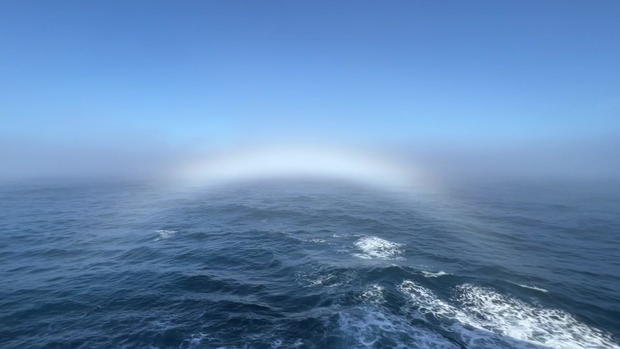
You can also hang out with scientists. Researchers like deep-sea biologist Steve Ross and ocean archaeologist Rod Mather join every expedition. In effect, the passengers are funding their science.
I asked, "How scientific is this this expedition?"
"I don't do show science," Ross said. "Our job is to do real and important and valid work."
"While you're down there, will you look for this giant heart-shaped diamond on a chain?"
"I think that's not there," Mather replied.
On our sixth day at sea, the weather cleared. The dive was a go!
Titan reported arriving "on bottom," sitting at 3,742 meters. But that was the last of the good news.
There's no GPS underwater, so the surface ship is supposed to guide the sub to the shipwreck by sending text messages. Rush recalled, "I said, 'Do you know where we are?' '100 meters to the bow, then 470 to the bow. If you are lost, so are we!'"

But on this dive, communications somehow broke down. The sub never found the wreck.
"We were lost," said Shrenik Baldota. "We were lost for two-and-a-half hours."
Rush said he'll offer those passengers a free do-over next year. And that's just one cost of doing this business.
I asked, "Are you making money on this operation?"
"Ahhh, no. So, not yet," he replied. "People might say, 'Hey, that's a lot of money, $250,000.' But we went through over a million dollars of gas."
It was our last day at sea. There was one last chance to reach the Titanic. And this time good weather and good fortune were aligned. An anchor was spotted.
"Oh my God. There's the bow, guys! Do you guys see it?"
And there it was. The famous bow, emerging from the darkness.

The ship's wheel pedestal, and memorial plaques from old expeditions.

The bollards that once secured the ship in port.
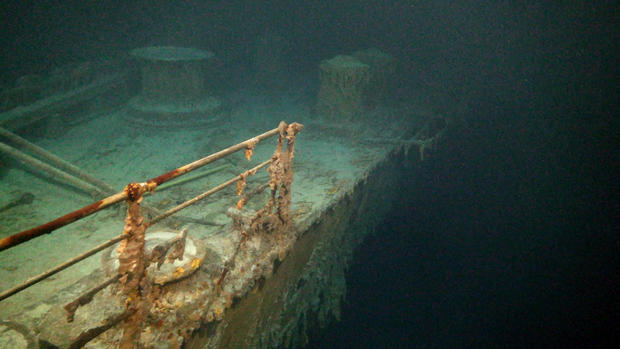
And the davits that lowered the lifeboats.
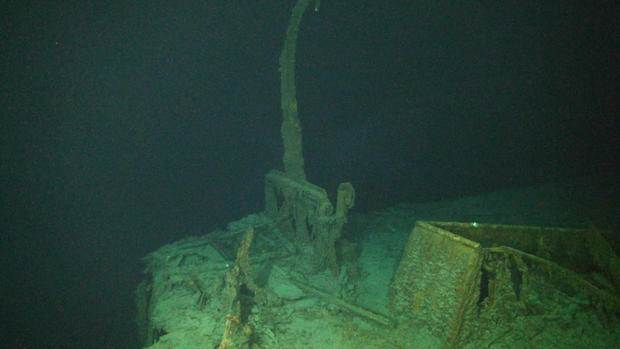
The hole where a huge smokestack once stood.

And the skylight over the radio room that sent out distress signals.

Now, Titanic tourism has its detractors. But these expeditions don't disturb the wreck or retrieve artifacts, and Stockton Rush said that they're valuable to history: "At some point, there will be no Titanic. It will be eaten by the bacteria. It will be an artificial reef that doesn't look like the Titanic."
Renata Rojas would agree. After 30 years of trying, she finally got to see the most famous shipwreck in the world.
Stockton Rush plans to return to the wreck next summer. Until then, the Titanic will once again be alone.
For more info:
Story produced by Anthony Laudato. Editor: Joseph Frandino.
See also:
- Titanic: A tragedy very much alive ("Sunday Morning")
- The Titanic is vanishing. An expedition will monitor the ship's decay "before it all disappears"
- Cameron on Titanic: "Death in slow motion" ("CBS This Morning")
- RMS Titanic
More from CBS News

Steve Martin: Comic, banjo player, and now documentary film subject

Husband of U.S. journalist detained in Russia: "I'm not going to give up"

Fareed Zakaria decries the "anti-Americanism" in America's politics today

Girl rescued after 16 hours under mud amid deadly storms in Brazil
The Quest to Find—and Save—the World’s Most Famous Shipwreck
In 1628, the ‘vasa’ sank on its maiden voyage. for the next 300 years, it sat in a watery grave—until one man sparked a monumental effort to salvage it..
- Lucas Reilly
Read when you’ve got time to spare.
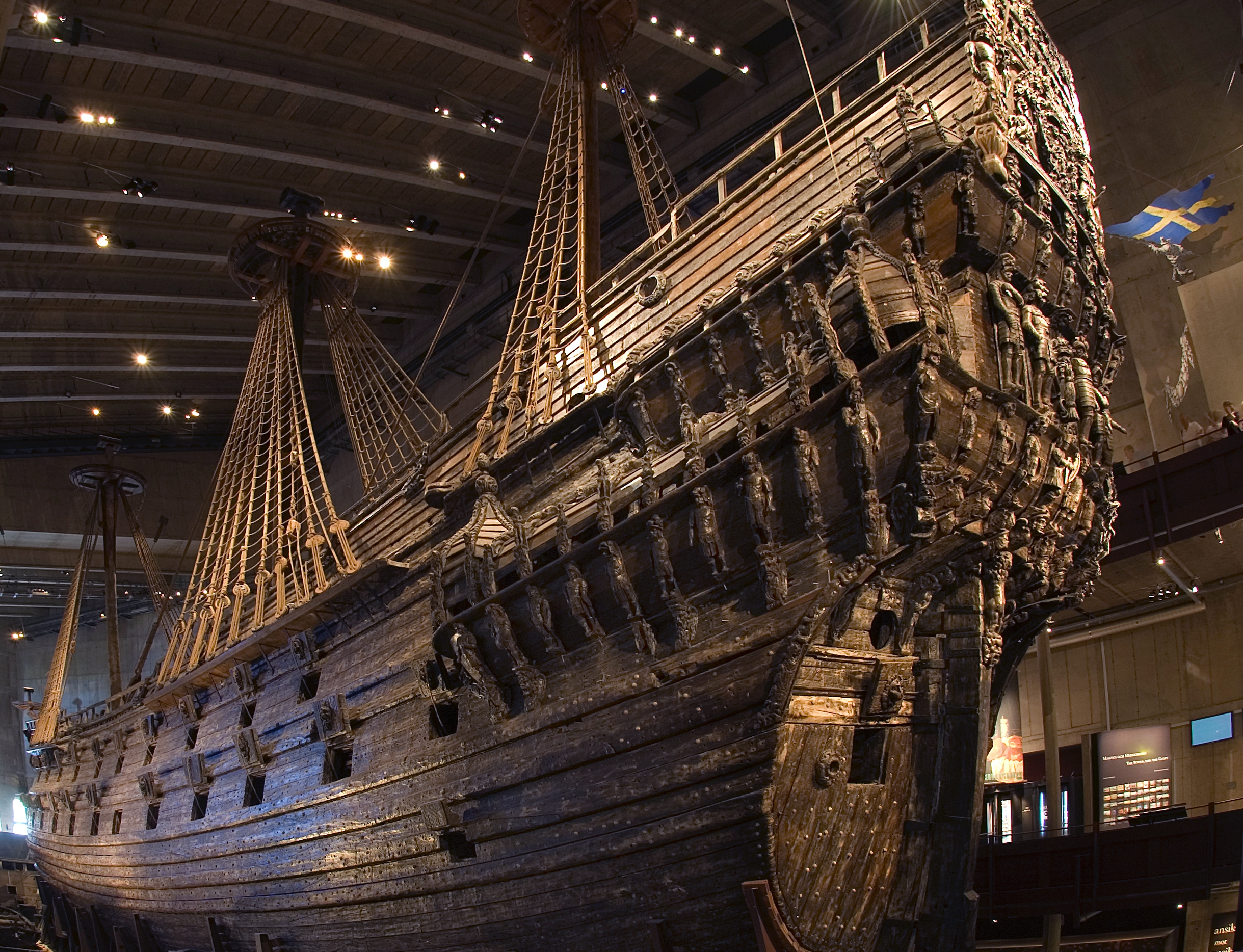
Photo credit: Karolina Kristensson, the Swedish National Maritime Museums.
Anders Franzén lived for shipwrecks . An engineer and expert on the naval warfare of the 16th and 17th centuries, he was especially obsessed with the old Swedish men-of-war that had once menaced the Baltic Sea.
When he wasn’t busy at his day job with the Swedish Naval Administration, he’d spend hours combing through archives in search of maps and documents, hoping they might reveal the location of Sweden’s great sunken warships. And when he learned that one wreck might still be trapped, undiscovered, not far from his home in Stockholm, he was hungry to find it.
For five years, Franzén spent his spare time searching for the shipwreck. He had little luck. Trawling the waterways around Stockholm—what locals call the ström —with a grappling hook, Franzén's “booty consisted mainly of rusty iron cookers, ladies’ bicycles, Christmas trees, and dead cats,” he’d later recall.
But on August 25, 1956, Franzén's grappling iron hooked something 100 feet below. And whatever it was, it was big.
Franzén gently lowered a core sampler—a tool used by oceanographers to get soil samples from the bottom of bodies of water—and retrieved a dark and soggy chunk of black oak. The following month, Franzén's friend Per Edvin Fälting dived into the ström and see what was down there.

Photo from the Archives of the Swedish National Maritime Museums.
Fälting had to work blind. Just 30 yards below the surface, the brackish waters were pitch black. The diver ran his hands over the mysterious object and tried to get a feel for what it might be.
“I can feel something big,” Fälting said to Franzén over a diver’s telephone, “the side of a ship. Here’s one gun port and here’s another.”
There was a pause.
“There are two rows,” Fälting said. “It must be the Vasa .”
The Vasa was the greatest warship to never go to war. Named after the Swedish royal family—the House of Vasa—the vessel was commissioned by King Gustavus II Adolphus in 1625 and was earmarked to become his navy’s flagship. Gustavus had big dreams for the Vasa : He wanted the most lethal warship in the Baltic Sea, one that was as beautiful as it was deadly.
For three years carpenters, sailmakers, painters, woodcarvers, ropemakers, and hundreds of other artisans and craftsmen rushed to build the king’s vessel. The Vasa would be a floridly crafted masterpiece with at least 700 delicately carved sculptures, figurines, and ornaments: Angels, devils, lions, emperors, warriors, musicians, mermaids, ghastly faces, heavenly facades—all painstakingly crafted from oak, pine, and lime wood.
The boat’s exterior would be a palpable rainbow (gilded in gold leaf for extra measure). “The hundreds of sculptures clinging and clambering about the Vasa were an orgy of pink naked flesh, of steel-blue armor, of sanguine reds, poisonous greens, and marine blues,” writes Erling Matz in The Vasa Catalog . As Lars-Åke Kvarning writes in Scientific American , these ornaments had many purposes: “To encourage friends, intimidate enemies, assert claims, and impress the world with this picture of power and glory.”

Photo from iStock.com/rusm.
The ship itself was constructed from 1000 oak trees and had three decks, including a stack of two gundecks, which would hold 64 cannons. The design was unprecedented in its size and complexity.
King Gustavus, famous for his military prowess, demanded it. At the time, he controlled “Finland, Estonia, and [Latvia], and he had just won the small part of Russia that touches the Gulf of Finland,” Kvarning writes. “By thus excluding the czar from the Baltic, he had nearly made [the Baltic] sea into a Swedish lake.” He was also juggling multiple wars and was anxious to get his hands on a new warship that would help preserve his dominance. He told the builders to make haste.
It was a foolish decision. In the early 17th century, constructing a functional ship was a matter of trial and error. (And according to Matz, there was a lot of error: In the 1620s, of the 15 naval ships Sweden lost, only two sank in the heat of battle.) There were no calculations to do or construction drawings to make. A new design was usually partially modeled on its predecessors—but the Vasa had none. The shipbuilders had to basically eyeball it. Worse yet, the Vasa ’s master shipbuilder died mid-way through construction.

Photo from iStock.com/pejft.
Baffled by the ship’s giant dimensions, the Vasa ’s architects were never able to confidently determine how much ballast the vessel needed. They filled the hull with approximately 121 tons of stone but believed it needed much more. But the king, who had personally approved the ship’s dimensions, effectively forbade any alterations—and anyway, adding more ballast would have brought the lowest gundeck dangerously close to the waterline.
When the nearly completed Vasa began floating in port, the ship’s skipper, Söfring Hansson, decided to test the boat’s stability. He asked a herd of 30 men to run back and forth across the deck; after just three runs, the ship began to teeter precariously. Some of the ship’s officers wanted to inform the king that the boat was on the verge of capsizing, but Gustavus wasn’t in town. The problem was ignored.
On August 10, 1628, crowds gathered at Stockholm’s waterfront to see the Vasa off. After attending a church service, the sailors—along with many women and children, who were invited to join the maiden voyage—boarded the boat. Four of the 10 sails were unfurled and, guided by a light breeze, the vessel lurched into Stockholm's ström just before 4 p.m. The crowd cheered.
And then it began to scream.
A slight gust caused the glimmering ship to tilt to its left. The Vasa briefly righted itself, only to return to its awkward, portside lean. The captain immediately demanded that all the gunports be closed, but it was too late—water had breached the openings. As one surviving crewmember recalled, “By the time I came up from the lower deck, the water had risen so high that the staircase had come loose and it was only with great difficulty that I climbed out.”

Photo credit: Anneli Karlsson, the Swedish National Maritime Museums.
Dozens of men, women, and children began jumping from the ship. Stockholm’s waters became peppered with helpless, flailing bodies. Sailors clambered up the ship’s sinking masts. Within minutes, the Vasa was underwater and 30 people were dead.
The world’s meanest warship had been felled by a gentle gust of wind. It had traveled barely 4000 feet.
Hearing that his prized warship was submerged, Gustavus—who was away in Prussia warring against Poland-Lithuania—demanded an inquest to find and punish the people responsible. The captain and a few shipbuilders were tossed into captivity and an investigation ensued. Some investigators claimed the cannons hadn’t been tied down and had rolled to one side, causing the boat to heel over. (Not true.) Others claimed the captain had been negligent. (He wasn’t.)
The truth was, the Vasa was just top-heavy: If anybody deserved blame, it was the man who demanded such clumsy dimensions—the king. But to implicate an infallible man who ruled by divine right was to implicate God himself. Like the Vasa , the case quickly sank from public view.
There is a secret swirling in Stockholm’s harbor: The water there is too brackish and deoxygenated to support the wood-munching shipworm Teredo navalis . In salty seas, this flat little bivalve will gorge itself on wooden piers, hulls, and shipwrecks—slowly destroying all signs of man’s handiwork.
But not in the Baltic. Wooden shipwrecks remain preserved in remarkable condition. (This is especially true in Stockholm, where, according to the Vasa Museum, “Centuries of raw sewage dumped into the harbor have created a dead zone at the bottom, where even bacteria cannot live.”)
Days after the Vasa sank, Sweden’s Council of the Realm sent a British man down to salvage the wreck, but the mission failed. In 1663, a Swede named Albrecht von Treileben plunged into the chilly ström under the protection of a diving bell and managed to retrieve more than 50 of the ship’s expensive bronze cannons.

Photo from the Vasa Museum / Public Domain.
After that, the Vasa ’s location was forgotten for 300 years. The closest thing to a salvage mission came in 1920, when two brothers requested permission from the Swedish government to find the ship and turn the vessel’s oak into Art Deco furniture. (The request was denied.)
Franzén, on the other hand, was determined to keep the Vasa in one piece. Problem was: Nobody knew how. Nobody had ever attempted to raise a shipwreck so big or so old.
Crackpot ideas swirled. “One idea was to freeze the Vasa in an immense block of ice and let her float to the surface,” Matz writes. “The idea was then to tow the iceberg to a suitable position and let it melt in the sun, whereupon the Vasa would emerge.” There was even talk of lifting the ship by filling the empty hull with ping pong balls.

Illustration by Bertil Erkhammar, courtesy of the Vasa Museum.
Thankfully, Franzén’s discovery generated so much interest in the Swedish media that the navy offered to supply boats and train divers, while the Neptune Salvaging Company generously offered to return the ship to the surface pro bono . Divers would use water jets to dig tunnels beneath the shipwreck. Heavy cables would be piped through these passages, creating a basket that could help lift the ship.
In 1957, the first divers plunged into the ström . Working in complete darkness, they carefully began the dangerous work of hollowing out six tunnels, ignoring the fact that tons of ballast could, at any moment, collapse onto their heads. It was a deadly workplace. “Girders, plans, and other paraphernalia meant that the air pipes and lines could easily get stuck,” Matz writes, “And they did.” (It didn’t help that, as the divers dug, they discovered at least 17 skeletons.)
After two relatively uneventful years, the tunnels were completed. The wires were piped through and strung to two pontoons (cheerfully named Oden and Frigg), which gently lifted the wreck 8 feet off the seabed. Starting in August 1959, crews slowly moved the Vasa to shallower waters and set her back down. They would repeat this motion—lift, move, lower—at least 18 times. After each successful drop, the crews would shorten the wires, ensuring the boat would inch closer to the surface with the next lift.

But before the Vasa was allowed to surface, the hull had to be made watertight. The iron bolts that once held the ship together had rusted away, and the salvage crew had to patch and fill those cavities while still submerged. (They also installed new watertight hatches on each port.) This underwater handiwork took two years.
Finally, on April 24, 1961, three giant bilge pumps began purging water from the ship’s interior and the Vasa was, once again, kissed by sunshine. Within two weeks, the Vasa was not only above the surface—it was floating.
For years, the Vasa was housed in a misty, cave-like warehouse. It was there, in the Wasavarvet , that the ship took a rigorous shower in preservatives.

The Vasa 's wood contained approximately 800 tons of water—and it all needed to be removed. Researchers, however, couldn’t simply let the ship sit out and dry, because the waterlogged wood would shrink and split. To prevent cracking, preservationists had to spray the Vasa with a mixture of water and polyethylene glycol (25 minutes on, 20 minutes off) for 24 hours. This process, which came to involve 500 automated spray nozzles, lasted 17 years.
Slowly, water dripped from the Vasa and strings of excess polyethylene glycol trickled down, hardening to form stalactites resembling fine white candles. When the PEG-shower had finished, the humidity in the storage facility had to be gradually cranked down over the course of 10 years.
By that point, archaeologists—who had to be vaccinated against diseases such as jaundice and typhus before touching the boat—had already sifted through tons of mud and sludge in search of artifacts. By spraying down the Vasa ’s decks with garden hoses, they had uncovered more than 30,000 items, including clothes, personal effects, barrels of meat, candlesticks, coins, and a piece of glassware containing a 66-proof alcohol. (“I can testify, from personal experience, that the liquor was good,” Kvarning wrote.) Divers also combed the ship’s watery gravesite to recover thousands more objects.

Of these, every wooden artifact was dunked into a vat of polyethylene glycol solution. Dozens of cast-iron cannonballs—which had rusted so much that they now weighed as much as a Styrofoam balls—were dried in hydrogen heated to more than 1900°F. Six of the Vasa’s crumbling sails, which could only be cleaned while submerged in liquid, were dried in a mixture of alcohol and the solvent xylene. (They took more than a decade to conserve.)
Meanwhile, the Vasa’s sterncastle—the elaborate perch protruding from the ship’s rear—had fallen into shambles. “[W]orkers had to identify and locate many thousands of structural components, ranging from heavy beams to tiny bits of wood—a gigantic jigsaw puzzle to be assembled without benefit of blueprints,” Kvarning writes.
Otherwise, the whole of the Vasa remained in fantastic condition. The fine ornamentations, although missing their brilliant colors, were still magnificent in their details.
Today, there’s still a lot of work to be done. In 2000, the humidity in Stockholm was so high that the presence of soggy museum visitors caused sulfur buried in the ship’s wood to produce corrosive acids. The ship is also shapeshifting. To monitor wood deformation, geodetic measuring devices are being used to map slight changes in the ship’s shape (which is currently settling 1 millimeter every year [ PDF ]). To combat a potential breakdown, carpenters have built a replica of the Vasa ’s hull, which is undergoing a battery of stress tests that will hopefully teach preservationists how to improve the ship’s stability.

That hard work, however, has already paid off. Today, the Vasa Museum is the most popular cultural institution in all of Scandinavia. Home to the world’s only preserved 17th-century ship, the place is more than a vital time capsule—it’s an homage to an ongoing rescue mission more than 300 years in the making.
Lucas Reilly proudly worked on mental_floss magazine for four years, where he served as a senior editor. For two years, he worked as a longform feature writer for the web. He's embedded with professional eclipse chasers in Nebraska, interviewed feudal lords in Britain, hunted for buried treasure in Virginia, and once profiled a man who had tried to turn into a goat.
How Did The World's Most Famous Shipwreck Come To Be?

A stunning island off the southwest coast of Greece, Zakynthos boasts magnificent beaches, secluded coves and verdant valleys. But the island is probably more famous outside Greece for Navagio Beach, a little cove with a pristine beach and crystal clear waters home to a famous shipwreck. In this article, discover the story behind this wayward boat and how it ended up on one of Greece’s most famous beaches. There is no doubt that Navagio Beach (Shipwreck Beach) is one of the most famous and most photographed beaches in Greece. Located on the north-west shore of the Ionian island of Zakynthos (also known as Zante), Navagio Beach, previously known as Agios Giorgos , became an impromptu ship graveyard when the MV Panayiotis washed up on its shores in October 1980.

Many theories and speculations arose and while the date is often wrong (some sources state that the event happened in 1981, 1982 or 1983), most of them claim that the MV Panayiotis was a smuggler ship, hence its contributing to the name Smugglers Cove. Some say that the ship was smuggling cigarettes, wine and even humans, when authorities caught up and cornered it until the cove, where it circled aground. Others, supporting the theory that the vessel was indeed smuggling contraband cigarettes, booze and women, lost engine power and was simply washed ashore in the bay. Another theory supports that the owner of the MV Panayiotis, Haris Kompotheklas, transported smuggled cigarettes from the ports of Yugoslavia and Albania in order to send them to Italy. On this particular journey, he was forced to board two Italian smugglers. Rumour has it the captain was able to arrest and imprison the two Italians to exploit the smuggled goods for himself, but because of unexpected bad weather conditions, he was forced to ground the ship in the bay. And while he and his crew ostensibly tried to salvage the cargo, part of it was carried away by the waves, bringing bounty to villagers who then hid the goods. When the authorities got wind of the incident, they came and arrested the captain and his crew, deported the Italians back to their country and convicted the parties for smuggling, while the cargo was sold through an auction.

Recently, the captain of the ship, Kefalonia-born Captain Charalambos Kompothekras–Kotsoros, released the true account of what happened that night.

Become a Culture Tripper!
Sign up to our newsletter to save up to 500$ on our unique trips..
See privacy policy .
After being cleared from all accusations by the court, he was later forced by the authorities to remove the vessel by his own means. When he visited the site to see how he could execute the manoeuvre, he was so astonished by the beauty of the rusting carcass that he decided to leave it as is.

Now the owner of a villa and apartment complex called Monte & Mare in Kefalonia, he is living a more relaxed life in his beautiful homeland.
Whatever rumor or story you believe, there is no doubt that whatever happened that night of October 2nd in 1980 has left a stunning half-manmade, half-natural monument that has put Zakynthos on the worldwide tourist map.

KEEN TO EXPLORE THE WORLD?
Connect with like-minded people on our premium trips curated by local insiders and with care for the world
Since you are here, we would like to share our vision for the future of travel - and the direction Culture Trip is moving in.
Culture Trip launched in 2011 with a simple yet passionate mission: to inspire people to go beyond their boundaries and experience what makes a place, its people and its culture special and meaningful — and this is still in our DNA today. We are proud that, for more than a decade, millions like you have trusted our award-winning recommendations by people who deeply understand what makes certain places and communities so special.
Increasingly we believe the world needs more meaningful, real-life connections between curious travellers keen to explore the world in a more responsible way. That is why we have intensively curated a collection of premium small-group trips as an invitation to meet and connect with new, like-minded people for once-in-a-lifetime experiences in three categories: Culture Trips, Rail Trips and Private Trips. Our Trips are suitable for both solo travelers, couples and friends who want to explore the world together.
Culture Trips are deeply immersive 5 to 16 days itineraries, that combine authentic local experiences, exciting activities and 4-5* accommodation to look forward to at the end of each day. Our Rail Trips are our most planet-friendly itineraries that invite you to take the scenic route, relax whilst getting under the skin of a destination. Our Private Trips are fully tailored itineraries, curated by our Travel Experts specifically for you, your friends or your family.
We know that many of you worry about the environmental impact of travel and are looking for ways of expanding horizons in ways that do minimal harm - and may even bring benefits. We are committed to go as far as possible in curating our trips with care for the planet. That is why all of our trips are flightless in destination, fully carbon offset - and we have ambitious plans to be net zero in the very near future.

Guides & Tips
The best private trips to book for family celebrations.

The Ultimate Guide to Holidays in Greece

Top Tips for Travelling in Greece

This is the Best Package Deal to Book in Greece

How Much Does a Trip to Greece Cost?

Where to Travel in Summer 2023

Come Sail Away with Culture Trip

See & Do
Why costa navarino should be your next greek destination.

The Best Sailing Vacations for Exploring Ancient Historical Sites

Why You Need to Visit Greece in 2022

A Guide to Sailing in the Dodecanese Islands, Greece

A Guide to Sailing in the Ionian Islands, Greece
Winter sale offers on our trips, incredible savings.

- Post ID: 1003755
- Sponsored? No
- View Payload

Sign Up Today
Start your 14 day free trial today
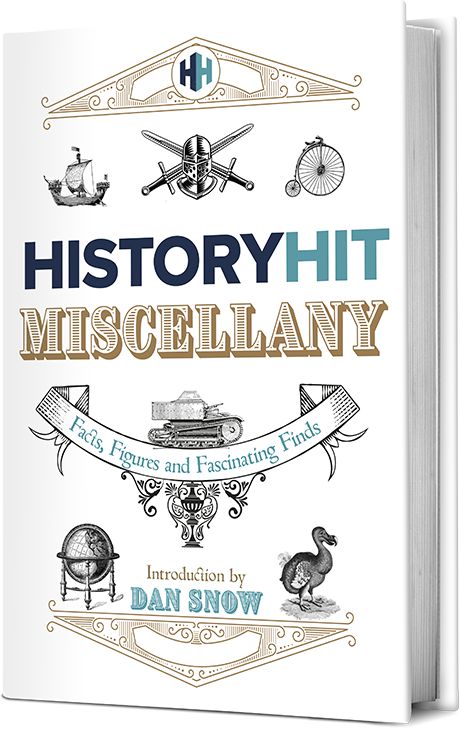
The History Hit Miscellany of Facts, Figures and Fascinating Finds
10 of the Most Famous Shipwrecks Around the World
Although they may not be shipshape any longer, these wrecks still have a strange beauty to them and come laden with history, rather than cargo..

Tristan Parker
23 nov 2021.
If ever we needed reminding of the might of the ocean, all we need do is look at the wealth of shipwrecks scattered around the globe. These fascinating remnants make for incredible photo opportunities and each comes with its own story, demonstrating just how wild and unpredictable the ocean can be.
Then consider an estimate by the United Nations which puts the number of shipwrecks lying undiscovered in the sea at around 3 million, meaning we’ve only found and explored a fraction of what’s out there – potentially around 1%.
But for the time being, enjoy seeing what’s already been uncovered with our pick of 10 famous historical shipwrecks from across the world. Some are accessible only by experienced divers, some are preserved in museums, but many are still accessible for anyone who makes their way to the beach.
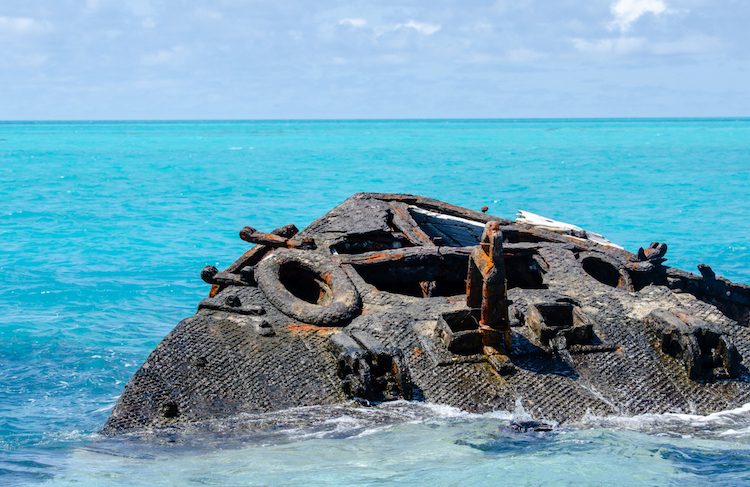
1. HMS Vixen, Bermuda
Built in London as a Royal Navy armoured gunboat in 1864, HMS Vixen went on to serve a short military career, as the ship was found to be too slow for use in battle. Vixen and sister-ship Viper were towed to Bermuda in 1888 to act as stationary defense aids for the Royal Naval Dockyard, before being used as accommodation for the dock workers.
Eventually, the engine and other valuable parts were sold off and Vixen was scuttled (deliberately sunk) in a narrow stretch of water near Daniel’s Head Beach to help prevent possible torpedo attacks. Vixen ’s bow now pokes out of the water and the remains have become a local attraction, regularly visited by divers, tour boats and jet-ski safaris.
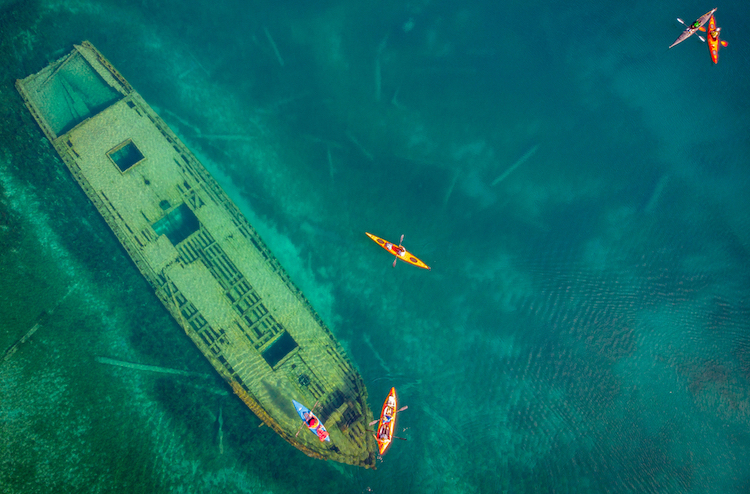
2. Sweepstakes, Canada
This surprisingly beautiful schooner is an impressive sight, lying just 20 feet deep in crystal-clear waters in Fathom Five National Marine Park, in Ontario, Canada. Sweepstakes was built nearby in Burlington in 1867, but was damaged in 1885 and then towed to Big Tub Harbour, where repair work was vetoed.
Sweepstakes sank at the harbour soon afterwards and is now popular with divers and snorkellers keen to see the amazingly well-preserved remains. This includes an almost-fully-intact hull, which can also be seen from above the water.
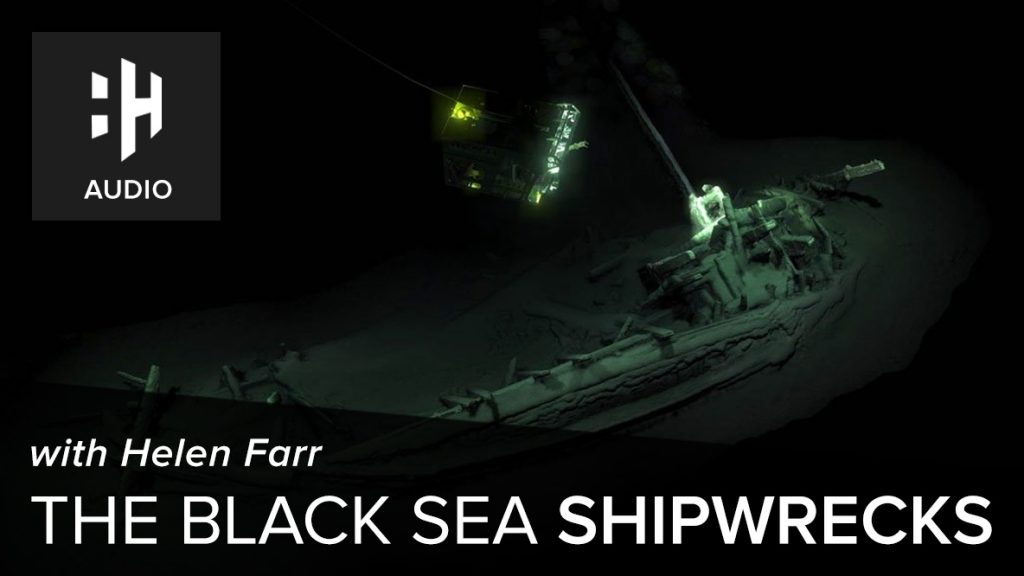
3. Eduard Bohlen, Namibia
The middle of a desert isn’t the first place you expect to see a shipwreck, but there are numerous remains to be found along Namibia’s Skeleton Coast, the most famous of which is the Eduard Bohlen . This German cargo ship ran ashore and became stranded in 1907 on its way from the Namibian city of Swakopmund to Table Bay in South Africa, probably due to thick fog.
Gradual sand movement over the years has shifted the ship around 500 metres from the coast and further into the sands, where it lies half-covered, producing a mirage-like spectacle.
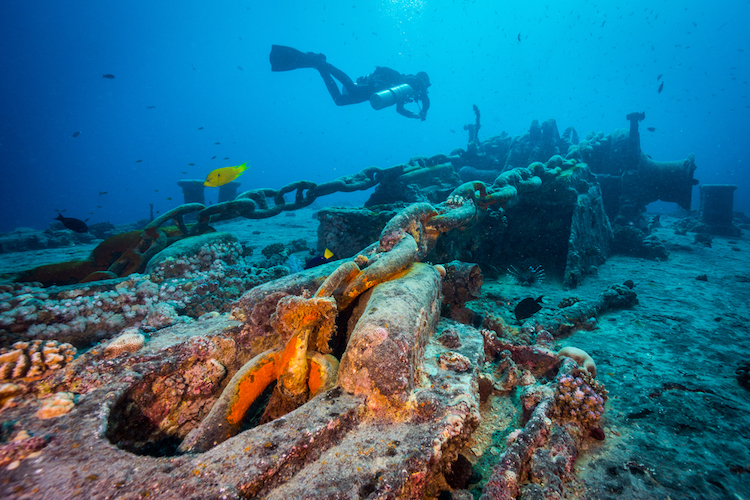
4. Thistlegorm, Red Sea
When it was sunk in the Red Sea by two German bombers in 1941 (tragically killing nine men from the crew of 50), this British Merchant Navy ship was carrying a valuable haul of cargo that included guns, ammunition, trucks, motorbikes, aircraft parts and even locomotives. Some of this cargo remains underwater with the Thistlegorm in its resting place on the seabed, helping to make it one of the most popular shipwrecks in the world for divers. An estimated one million divers have journeyed down to the photogenic wreckage.
Famed oceanic explore Jacques Cousteau rediscovered the Thistlegorm in the early 1950s and raised several items from the remains.
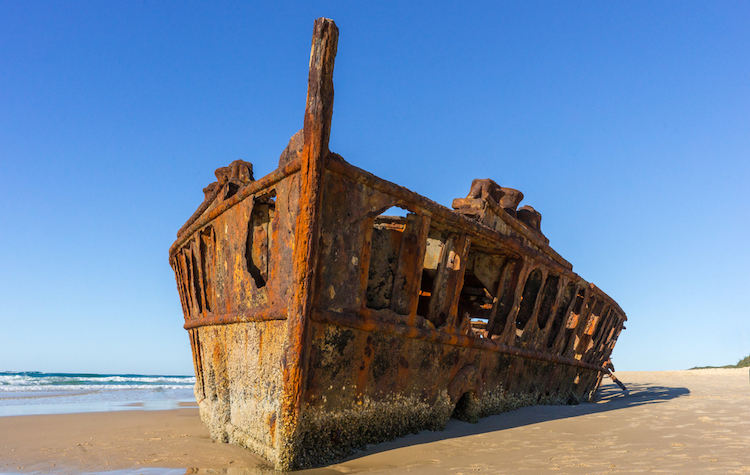
5. SS Maheno, Australia
Constructed as a steam-powered passenger ship in 1905, the SS Maheno was converted into a hospital ship during World War One, resuming its status as a commercial ocean liner after the war ended.
In 1935 the ship was sold to a Japanese shipping yard for scrap metal, but never quite made it to Japan. A cyclone broke the tow-line being used to transport the Maheno from Sydney to Osaka, and the ship drifted ashore onto the paradisical sands of Queensland’s Fraser Bay, where it remains today.
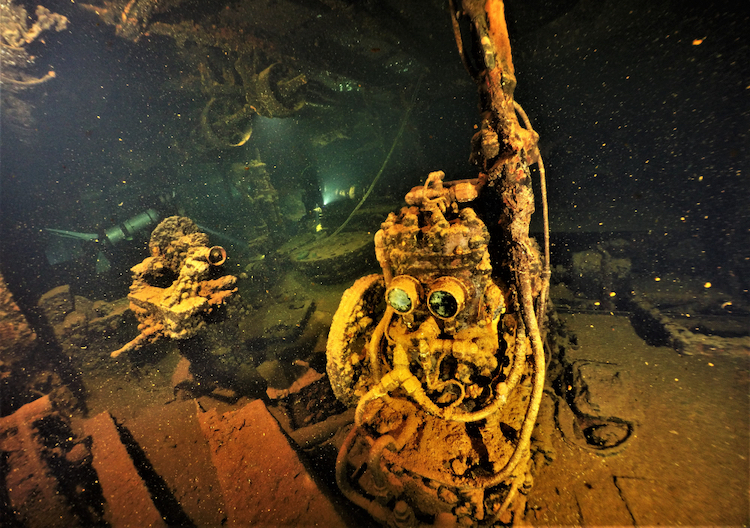
6. Fujikawa Maru, Federated States of Micronesia
Although the initial loads of Fujikawa Maru were items like silk and cotton (as well as passengers on its commercial runs), just two years after it was built the cargo changed dramatically, when the Japanese Navy recommissioned the vessel in 1940. The ship was armed and then used to transport aircraft, but was hit by a torpedo from an American submarine in 1943.
The Fujikawa survived the damage and continued to transport aircraft, but was bombed more heavily in 1944 as part of a large-scale American attack. This time, the damage was too much and the Fujikawa sank in Chuuk Lagoon, a coral reef in the Pacific Ocean within the Federated States of Micronesia. Large sections are still intact and the wreckage has become internationally acclaimed as a dive site.
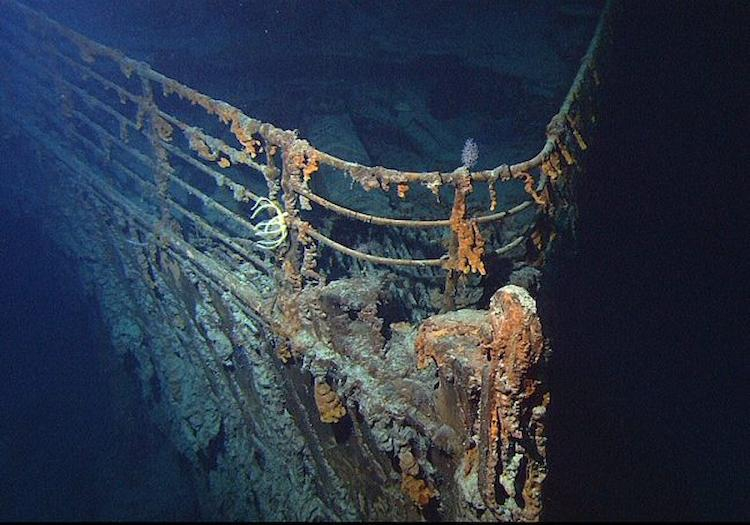
7. RMS Titanic, Atlantic Ocean
No list of notable shipwrecks would be complete without history’s most famous example, the Titanic . The largest cruise ship ever built at the time, 1911, the Titanic set sail on its maiden voyage from Southampton, England, to New York, United States, on 10 April 1912, carrying over 2,200 people as passengers and crew.
In the early hours of 15 April, the Titanic struck an iceberg, which eventually sunk the ship, killing over 1,500 people. It wasn’t until 1985 that the wreckage was located and it was discovered that the vessel had split into two pieces as it sunk. Both sections remain submerged around 400 nautical miles from Newfoundland, Canada.
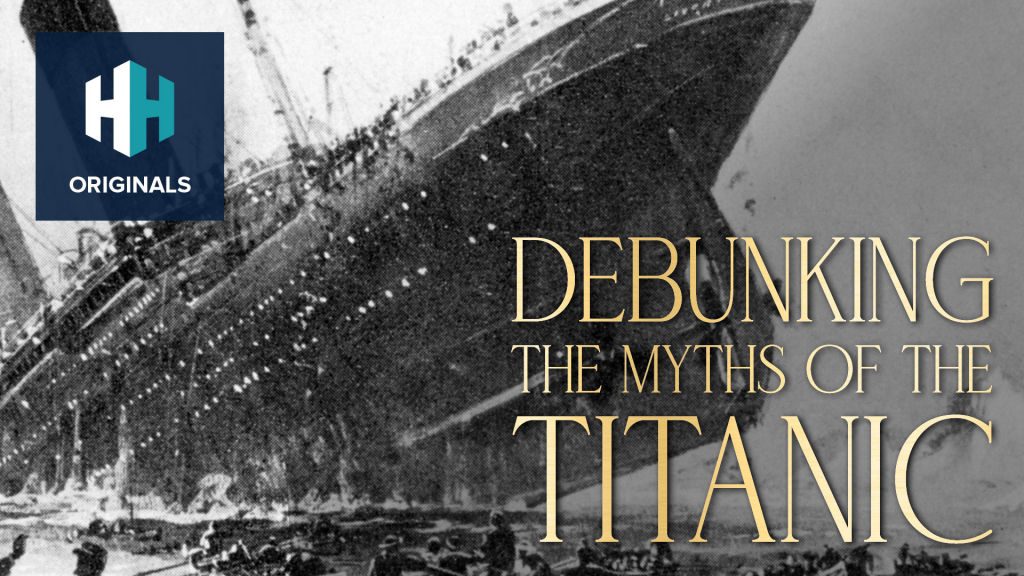
8. Vasa, Sweden
When it was built in 17th-century Sweden, Vasa was believed to be the most advanced warship in the world, until its maiden voyage revealed fatal design flaws. Vasa sank just 20 minutes after setting sail on 10 August 1628, after strong winds rocked the boat and water began to enter the ship through a low row of cannon holes. An estimated 30 crew members were killed and the whole episode was watched by large crowds who had gathered for what was meant to be a proud moment for the country.
It took more than 300 years for Vasa to be recovered, when the ship was finally raised in 1961 and found to be almost completely intact. It’s now on display in Stockholm, Sweden’s capital, in the Vasa Museum.
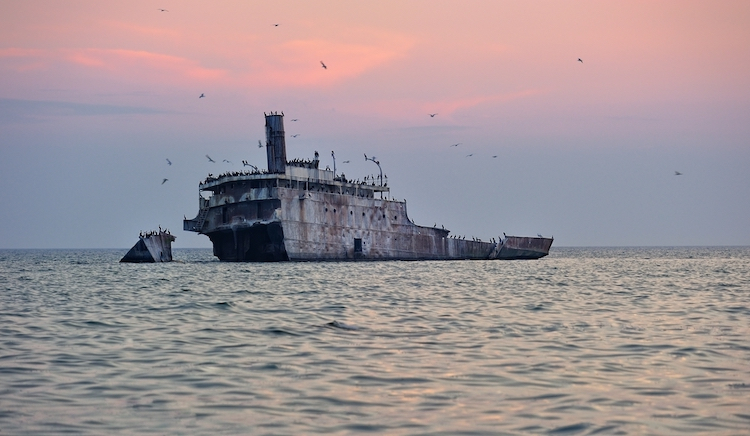
9. SS Francisco Morazan, United States
When it was built in Hamburg in 1922, this cargo ship was named Arcadia , the first of many names it acquired. Over almost four decades, the ship was passed between countries and continents. When sailing from Chicago to Rotterdam in the Netherlands in 1960, heavy snow and fog caused the ship (now named Francisco Morazan ) to become grounded near the shore of uninhabited South Manitou Island in Lake Michigan. Rescue teams were alerted and the ship’s captain, his pregnant wife and the crew were safely removed over the coming days.
The ship remained stranded in shallow waters and is now popular with divers and hikers, as it can be easily seen from land. It’s also home to various sea birds, who have at least found a use for the deserted vessel.
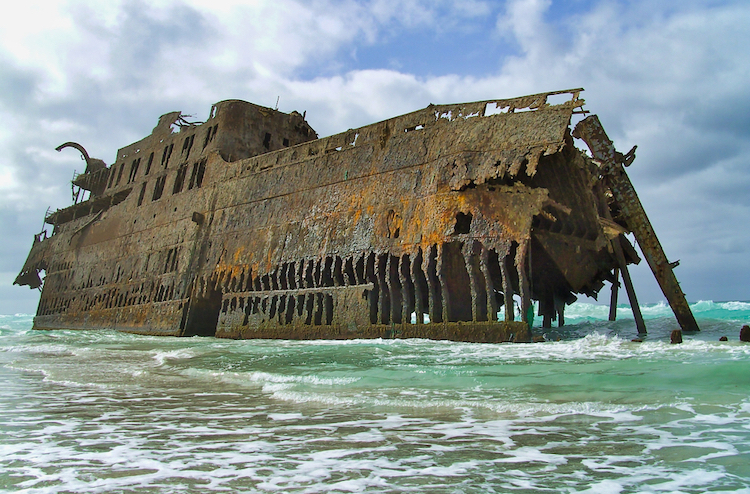
10. Cabo Santa Maria, Cape Verde
There’s some dispute over what Spanish cargo ship Cabo Santa Maria was transporting to Brazil in 1968. Some say it was carrying church bells to be used in the Cathedral of Brasília (which hadn’t yet officially opened at that point) alongside produce like oil, vinegar and vegetables. Others claim the ship carried gifts (including sports cars) and supplies from Spanish dictator Francisco Franco.
Whatever the cargo was, it didn’t make it to South America, as the Cabo Santa Maria ran aground off the coast of Boa Vista, an island in Cape Verde. The crew were safely evacuated and a tugboat tried, unsuccessfully, to recover the ship. When it came to recovering the mysterious cargo, local residents were reputedly enlisted to help unload the goods over the coming months. Now, all that remains is a huge, heavily rusted metal carcass. This eye-catching beast is slowly eroding and dissolving, little by little, but is still holding its own against the sea for the time being.

From Terror to Titanic : 7 famous shipwrecks
Shipwrecks are fascinating maritime time capsules that can be a direct window into what life was like in the past. Many are immortalised in film and television – from James Cameron’s Oscar-winning Titanic to the AMC drama The Terror – while others are popular tourist attractions. Discover seven of the most famous shipwrecks in history…

- Share on facebook
- Share on twitter
- Share on whatsapp
- Email to a friend
RMS Titanic
"There is no danger that Titanic will sink. The boat is unsinkable and nothing but inconvenience will be suffered by the passengers." These infamous words – said by Philip Franklin, vice-president of the International Mercantile Marine Company, in 1912 – have gone down in history for just how grossly inaccurate they proved to be. Franklin was speaking at a press event after hearing about the ship hitting an iceberg via wireless messages. He was presumably hoping to alleviate the fears of the concerned friends and relatives of those involved, but he was also speaking what he thought to be an absolute truth; the luxury passenger liner – at the time one of the largest and most opulent of its kind – had been repeatedly advertised as “practically unsinkable” ahead of its maiden voyage from Southampton to New York. Even considering its 20 lifeboats (which could hold half the people on board) and advanced safety features, it was an assertion that seemed destined to tempt fate – and tempt fate it did: RMS Titanic sank in the early hours of 15 April 1912 after colliding with an iceberg.

The sinking of Titanic remains one of the deadliest peacetime sinkings in history
The sinking of Titanic is today one of the most well-known maritime disasters in the world. This is thanks in part to James Cameron’s Oscar-winning 1997 film of the same name, but also because the event was – and remains to this day – one of the deadliest peacetime sinkings in history. The tragedy claimed more than 1,500 lives, although the precise number of fatalities is disputed. Among the dead were some of the most notable names of the time, including John Jacob Astor IV, one of the richest men in the world, and Isidor Straus, co-owner of Macy’s department store.
- Read more | 8 stories of people who sailed on Titanic
It took a long time to find the shipwreck; 73 years to be exact. She was discovered 13 nautical miles (24km) away from her distress location given at the time of the sinking. Recent research shows that the ship is deteriorating at a rapid rate, and may soon disappear entirely.
- Titanic quiz | How much do you know about the ship and disaster?
Private v public
More like this, the white ship.
Described by some as the ‘medieval Titanic ’, the White Ship disaster was one of the most dramatic events in the Middle Ages in terms of how it rocked the English monarchy. The ship – considered one of the finest of its time – set sail on 25 November 1120 with 300 people on board, the most important of them being William the Ætheling, the only legitimate male heir of King Henry I , and grandson of William the Conqueror . They were destined for England, but they were also determined to enjoy themselves along the way. Many of the people on board the ship were drunk before the ship had even left the dock – including, significantly, the helmsman. So inebriated were the passengers that a number of people refused to board the ship ahead of its departure – a decision that likely saved their lives. Just one mile off the coast of Barfleur – the favoured port to sail from Normandy to England – the ship hit a rock and sank. There was just one survivor, a man named Berold the butcher who was able to relay to people back on shore the chain of unfortunate events.
It’s an extraordinary thing for one ship to bring such calamity to a nation
Henry was devastated by the loss of his son. After 15 years of failing to produce another male heir, he named his daughter, Matilda, as his successor and handed her the realm – a decision that led to a period of civil war known as the Anarchy .

“I maintain that [the sinking of the White Ship] was the most disastrous moment in British maritime history,” Charles Spencer – author of The White Ship – revealed in an interview for HistoryExtra in 2020 . “Yes, the Titanic is remarkable in its scale and the glamour of the people on board, but this was an entire royal family destroyed. It’s an extraordinary thing for one ship to bring such calamity to a nation.”
The Mary Rose
Although many experts have attempted to solve the mystery of why Mary Rose sank, there is still debate about what caused her to capsize during the battle of Solent on 19 July 1545, sending around 500 men to their deaths. One eyewitness account suggests that a large gust of wind unbalanced the ship as she turned around, allowing water to enter the ship via the lowest row of gun ports. Another theory is that she was hit by a cannonball, although there is little physical evidence of this and the eyewitness in question – a Frenchman – may instead have been trying to overplay the military capabilities of Mary Rose’ s French adversaries.

One common misconception about Mary Rose is that she was a new ship on her maiden voyage. In actuality she had enjoyed a successful 34-year career as Henry VIII ’s favourite warship, and was more than capable of withstanding hardier conditions than those present on the day of her sinking. She had endured far choppier waters and carried greater numbers of soldiers to battle in the past – so no one can claim that she wasn’t fit for the job.
- You might like | 5 remarkable shipwreck stories from history
But the mystery of why Mary Rose sank is just a small part of why she is a household name today. In October 1982, the world watched as she was raised, a feat that required years of planning and the efforts of a huge team of divers, archaeologists, and scientists. Today located in Portsmouth Historic Dockyard, Mary Rose is a remarkable Tudor time capsule – although it’s worth noting that around half of her structure is missing and there are still significant parts of the wreck buried in the seabed.

The Gloucester
Hot on the tails of Mary Rose fame is the Gloucester , which was first located in 2007 but only made public knowledge earlier this year in a bid to protect the treasure trove of goods contained within the wreck site.
The ship sank off the coast of Norfolk in 1682 while on a journey from England to Scotland, resulting in the deaths of more than 130 people. James Stuart, Duke of York, was the most notable passenger on board, although he managed to escape and went on to become king of England, Ireland and Scotland as James II and VII.
- Read more | Why the Gloucester might be the most important shipwreck since the Mary Rose
One of the most tragic elements of the sinking was just how avoidable it might have been in the first place. Ahead of the ship’s departure there had been heated discussions about how she might navigate several treacherous sandbanks rising from the seabed. “James, clearly keen to get to Scotland, wanted to take the most direct route,” explains Professor Claire Jowitt in an interview for HistoryExtra. “ The next morning, the Gloucester hit the sandbanks and sank within an hour. James, hoping it could be saved, delayed abandoning ship – and royal protocol meant nobody else could leave before him. Had James decided to go sooner, more lives could have been saved.”
Among the discoveries in the wreck were 150 bottles of wine, cutlery, clothes, pipes and spectacles complete with spare lenses. But will the ship ever be brought to the surface, as Mary Rose was? “With the appropriate permissions, it might be possible to raise parts of the ship, while other discoveries could be made through the use of trenches,” says Prof Jowitt.
HMS Erebus and HMS Terror
In 1845, HMS Erebus and HMS Terror embarked on a mission to find a shipping route connecting Europe and Asia via North America. What exactly transpired on their Arctic voyage is uncertain, but both ships were abandoned three years into their mission. Neither returned; nor did any of their 129 crewmembers. The expedition, led by British explorer John Franklin, is now considered one of the greatest disasters in British polar history – and has inspired numerous retellings in popular culture, the most recent being the AMC drama The Terror .
- Read more | The Franklin Expedition: what happened on the ill-fated Victorian voyage?
So what prompted the men to leave their ships and where did they go? It’s one of history’s greatest mysteries – and a whole range of theories have been proposed as to what happened to Franklin’s men. “People claimed that the local Inuit must have killed them, or that the crew had been stricken by scurvy,” explains travel writer and presenter Sir Michael Palin – who retraced Franklin’s route “Lead poisoning [from food tins contaminated by lead solder] was once thought to be the key reason why everything went wrong, but that theory has now been widely dismissed.”

In 2014 and 2016 respectively, the sunken wrecks of Erebus and Terror were rediscovered – although we are no closer to discovering the mystery of what happened. “It’s not a very glamorous theory, but ultimately, I believe that Franklin’s men were simply in the wrong place at the wrong time,” suggests Michael Palin. “They chose to make their voyage to the North-West Passage during one of the coldest periods in modern history. From around 1845 to 1848, the ice in that region didn’t melt even over summer, meaning that they were unable to free the ships. That was the primary problem, and it couldn’t have been foreseen.”
Franklin’s men were simply in the wrong place at the wrong time
Despite both ships being discovered only recently, it is thought that the Inuit knew where they were located around a century beforehand. The difficulty lay in the fact that this was entirely word-of-mouth evidence – and, as Palin notes, “People simply didn’t take non-written Inuit testimony seriously enough to listen.”
RMS Lusitania
While many historic ships were sunk by accident – as is the case with the White Ship disaster of 1120 – others have been destroyed on purpose. The unarmed passenger liner RMS Lusitania was torpedoed by a German submarine during the First World War, an act which resulted in the deaths of 1,198 people on board and stoked the flames of anti-German feeling in Britain and the US.
The Germans suggested that the attack was justified: the ship was carrying war munitions, they said, plus the waters around the isles had been declared a war zone. But British people reacted to the news with wrath, and the German community within the country bore the brunt. Riots broke out around the country, German businesses were boycotted and national newspapers encouraged the dismissal of German staff. Rumours began to spread that all Germans living in Britain were spies, while almost all police districts in London reported violence and disorder in the days after the sinking.

Successive British governments continued to deny that there were munitions on board the Lusitania in the years following the war. But, as Saul David explained in a 2015 issue of BBC History Magazine , “they were lying. Government papers released in 2014, and recent dives on the wreck, have confirmed that the Germans were right all along: the ship was indeed carrying war material.”

JUMP into SPRING! Get your first 6 issues for £9.99
+ FREE HistoryExtra membership (special offers) - worth £34.99!
Sign up for the weekly HistoryExtra newsletter
Sign up to receive our newsletter!
By entering your details, you are agreeing to our terms and conditions and privacy policy . You can unsubscribe at any time.

JUMP into SPRING! Get your first 6 issues for

USA Subscription offer!
Save 76% on the shop price when you subscribe today - Get 13 issues for just $45 + FREE access to HistoryExtra.com

HistoryExtra podcast
Listen to the latest episodes now

Top 10 Most Famous Shipwrecks
And they're not the only ones. There's been a long fascination throughout history with shipwrecks and the treasure that they could hold, with the United Nations estimates that there are at least three million shipwrecks on the ocean floors.
Here we take a look at 10 of history's most famous shipwrecks:

Read more about Mysteries
The deepest known shipwrecks in history
10. ms world discoverer.
The MS World Discoverer was a Danish cruise ship created in 1974. While carrying passengers on a cruise in 2000 it struck a rock at the Solomon Islands, resulting in the ship subsiding. A distress signal was quickly dispatched and all crew and passengers were escorted safely to another passenger ferry.
There have been several attempts to salvage the shipwreck, but none have been successful, partly due to the fact that much of the ship has been looted and damaged during the Solomon Islands Civil War. The ship has remained at Roderick Bay ever since, and is now a popular local tourist attraction and it can even be viewed on Google Maps.

Read more about Disasters
The deadliest shipwrecks in history
9. the black swan.
The Black Swan or The Black Swan Project, is believed to be the greatest recovery of gold treasure in history. The treasure was found on the remains of the Spanish warship Nuestra Senora de las Mercedes which sank off Portugal in 1804. In 2007 the American company Odyssey Marine Exploration announced that it had uncovered gold worth an estimated $500 million (£314 million).

Read more about Treasure Hunting
The ship of gold: The '£1 billion' lost treasure of the Merchant Royal
However, the Spanish government declared that they rightfully owned the gold, and the case went all the way to the US Supreme Court, only for the gold to be returned to Spanish authorities in 2012, where it is now displayed in various exhibitions across the country.
8. MV Dona Paz
The sinking of the MV Dona Paz is remembered in history as the deadliest of all peacetime maritime distasters. It was a Philippine registered ferry and while carrying over 4,000 passengers, collided with an oil tanker MT Vector on December 20, 1987. A fire and explosion ensued, killing a predicted 4,386 passengers and there were only 24 survivors.
A lack of proper safety and communication measures were blamed, and it reportedly took 8 hours for the Philippine maritime authorities to hear of the incident. Due to the fire much fo the ship was destroyed, and it is now remembered as "Asia's Titanic."

The most notorious pirates from Blackbeard to Anne Bonny
7. the queen anne's revenge.
Queen Anne's Revenge was an 18th century warship mostly known for being the ship of legendary pirate Blackbeard (Edward Teach). First serving in the British Navy, the ship was later captured by the French and then by pirates from 1717 onwards. Although Blackbeard used the ship for less than a year, he achieved some of his greatest prizes during this time. In 1718 he grounded the ship and abandoned it, escaping capture by the British by boarding a smaller nearby ship.
In 1996 the remains of Queen Anne's Revenage were discovered, about one mile ashore from Atlantic Beach, North Carolina. So far thirty one canons have been discovered and more than a quarter of a million artifacts have been recovered. As one of the few pirate ships to be discovered, it is now listed on the US National Register of Historic Places.

7 fascinating facts about deep sea diving
Vasa is a Swedish warship, believed to have been built between 1626 and 1628. The ship sank twenty minutes into its maiden voyage on 10 August 1628 after being hit by strong winds and flooding. Sinking less than a mile into its journey, it was regarded as a great embarassment for the King of Sweden, and there were several salvage attempts, but none were successful.
It was not until 1961 that the shipwreck was successfully recovered, including thousands of artifacts. The hull of the ship was found to be remarkably in tact and with the help of some restoration, the ship is now a popular Swedish tourist attraction, with over 22 million visitors to date.

Read more about Battles
The Second Officer who survived Titanic and saved 130 lives at Dunkirk
5. the mary rose.
The Mary Rose was a Tudor warship commissioned and run during the reign of Henry VIII. Launched in 1511, it served in many battles against France, Brittany and Scotland, and in 1545 it sank during a battle against the French. Sinking in the Solent, close to the Isle of Wight, it was not rediscovered until 1971, and was salvaged in 1982. The remains of the shipwreck are now viewable in a museum in Portsmouth, and has become one of the most expensive and expansive projects in maritime archeology history.
In addition to the ship's structure itself, over 26,000 artefacts have been recovered - many of which are now on public display. The remains of about half of the deceased crew members have also been recovered, and bone analysis has revealed that many suffered from health conditions such as arthritis, rickets and scurvy.
4. USS Arizona
The USS Arizona was an American battleship built for the US Navy launched in 1915. The ship served many purposes, from escorting President Woodrow Wilson to the Paris Peace Conference to being sent to Turkey during the Greco-Turkish War, and was sent from California to Pearl Harbour, Hawaii in 1940 in response to the threat of Japanese Imperialism. On 7 December, 1941 USS Arizona was bombed by the Japanese, exploding and sinking. 1,177 crew members and officers were killed.
The shipwreck was declared a National Historic Landmark on 5 May 1989. Today the shipwreck remains and can be viewed at the USS Arizona Memorial, and is annually visited by two million people.

Read more about Ancient History
The oldest shipwrecks in history
3. rms lusitania.
RMS Lusitania was a British ocean liner launched in 1906, and made a total of 202 trans-Atlantic crossings before it was torpedoed and sunk by a German U-boat on 7 May 1915. Of the 1,962 passengers and crew aboard, 1,191 lost their lives. Causing outrage and shock across the world, some believe it was a major factor in encouraging the US to enter World War II as an ally.
Today the shiprwreck is in a state of severe detoriation. As it had been operating for seven years prior to sinking, it is in much worse condition compared to The Titanic and much was destroyed upon the initial blast of the torpedo. It lies 11 miles south of the lighthouse at Kinsale, Ireland. There have been various salvage attempts of the Lusitania, with many of the remaining ship's items being recovered, some of which are privately owned while others are on displays in museums around the world.

Read more about WW1
28 little known facts about WWI
2. rms republic.
The star of Billion Dollar Wreck, the RMS Republic was built in 1903 and operated as a steam-powered ocean liner. It wasn't until 23 January 1909 at 5:30 a.m. that distaster struck, colliding with the Lloyd Italiano liner SS Florida just off Nantucket, Massachusetts and sinking the next day at about 8.40 p.m. A total of six lives were lost, and the evacutaion process was praised as flawless at the time. Since the sinking, there have been many rumours and legends surrounding the treasure that supposedly went down with the ship. Ranging from $250,000 to $3,000,000 in estimates of the value of the sunken treasure - if excavated today it could be worth hundreds of millions of dollars - perhaps even a billion.
It is now son and father Grant and Martin Bayerle's mission on Billion Dollar Wreck to recover the rumoured treasure and claim it as their own. The shipwreck itself is 250 feet under water and much of it has deteriorated - however the vaults that contain the alleged treasure appear to be very much in tact.

Read more about Sport
A deep dive into the history of diving
1. rms titanic.
Just about everyone knows about Titanic - and its fate. A lot of us will know it from James Cameron's 1997 mega-blockbuster Titanic, which included actual footage of the ship's eerie remains. The supposedly "unsinkable" ocean liner set sail on its maiden voyage on 10 April 1912 only to hit an iceberg just before midnight on 14 April and sank in less than three hours. Claiming 1,514 lives, it is often remembered as one of the most famous and tragic shipwrecks in history. It wasn't until 1985 that a Franco-American expedition was able to reach the shipwreck, and discovered that it had been split in half - with each half lying within about a third of a mile apart from one another.

4 shipwrecks that weren't discovered until years later
The stern section was found to be almost completely crumbled, where as the bow is in much better condition, with some of the interiors incredibly intact. Hundreds of artifacts have been excavated from the shipwreck and can be viewed in various exhibitions around the world - from tableware to furniture and even menus.
Most Recent

10 forgotten Easter traditions from the British Isles

The kingmaker Margaret Beaufort: Mother of the Tudor dynasty

What is a skinwalker? Facts about the Native American legend

5 biggest mysteries of Jesus' life
More from history.

Competition: Win a copy of the Jerusalem Files by 'The Curse of Oak Island's' Corjan Mol

How to watch 'The Curse of Oak Island' season 11 in the UK

'If you turn up a lot of bling you'll go down in history': 'Cursed Treasures' interview

The mystery of Blackbeard's treasure: Where is it buried?
Keep reading.

10 Lost Tresaures That Can Still Be Found

Famous Eye Patches

5 Lost Treasures Waiting To Be Found

5 Famous Female Pirates
You might be interested in.

Hadrian's Wall and the River Eden

Lost Relics of the Knights Templar: All episodes now available on Catch Up

The Templar-Freemason connection

The Nazi hunt for holy treasure from Thor's Hammer to the Holy Grail

History’s Most Famous Shipwrecks
Shipwrecks can be tragic, yet critical discoveries that help us understand the past and piece together historical elements that are unknown or poorly understood.

They tell the tales of conflict, survival, and cultural exchanges from times past.
Many ships have fallen victim to accidents and attacks that sent them to a watery grave.
While not always, sometimes there’s an opportunity to explore the shipwrecks, which often get viewed as captivating stores of antique treasures.
Let us take you through the mysteries of these mind-boggling shipwrecks while providing historical and cultural context, and some intriguing facts you may not have known.
Table of Contents
The Titanic

Many people are familiar with the Titanic , as it is amongst the most famous shipwrecks around the world.
Deemed to be “unsinkable” and luxurious, the world’s largest passenger ship, and indeed largest cruise ship, set sail for its maiden voyage to New York City, but hit an iceberg on April 14, 1912, while trying to cross the North Atlantic ocean.
They say it could stay afloat even if four of the 16 watertight compartments suffered a breach. Unfortunately, five compromised compartments filled with water claimed the lives of around 1,517 people in three hours.
It wasn’t until 1985 that the remains got found (about 400 miles off the coast of Newfoundland, Canada), thanks to the efforts of a French and American co-expedition.
Today, multiple companies allow tours of the wreckage from the British ship, but it’s pretty costly, ranging from $60K-$250K.
Scientists worry the RMS Titanic remains won’t last much longer due to metal-eating bacteria sea life that will likely cause it to dissipate completely.
The Spanish Armada

In 1588, King Phillip II sent the Spanish Armada to invade England. The ship was known to be vast and powerful.
The crew aboard consisted of 30,000 men, and the fleet was 130 ships. The idea was to overthrow Queen Elizabeth I, reinstate the Catholic monarchy, and end the Dutch revolt against the Spanish conquest.
Because of boisterous thunderstorms and waves, many of the ships were wrecked on the coasts of Ireland and Scotland (Streedagh Beach in Sligo).
About 5,000 crew members died during this shipwreck, mainly from the La Juliana wardship.
Local divers came across three wrecked fleet vessels in 1985, known as La Juliana, La Santa Maria, and La Lavia. Due to its protected status, no one can dive in the area without a license.
The Lusitania

The Lusitania , a British passenger ship, set sail in 1906. It was a high-class vessel noted for its speed.
During the first world war, in May 1915, the British ocean liner traveled from English to New York City. Reports were that a German U-boat was near the Irish coast, and the Lusitania should steer clear of that area.
However, the captain didn’t need these warnings, and the ship sank on May 7th because it got struck by a torpedo fired from a German submarine . Various sources estimate that 1,200-1,900 people got killed.
Today, the shipwreck is in its final resting place about 11 miles off the southern coast of the Irish lighthouse at Kinsale, beneath 300 ft of water.
Multiple dive clubs and institutions have obtained licenses to explore what’s left of the ship.
They mention that visibility is low beyond 100 feet. Any scuba diving in this area requires permission from the owner and the authorities.
The Fleet of Kublai Khan

Another one of the most famous shipwrecks of all time is the destruction of Kublai Khan’s fleet . Kublai was Genghis Khan’s grandson and wanted to invade Japan; his first attempt was in 1274.
He gathered 500 small boats and 300 ships, but a typhoon decimated one-third of his fleet as it inched closer to the Japanese coast.
Though discouraged, Khan would reattempt the same voyage seven years later in 1281. However, the fleet got destroyed by a storm again.
In waters near Takashima Island in Matsuura, there was a 66-ft long vessel discovered under almost 100 feet of water and three feet of sand.
Marine archaeologists discovered over four thousand artifacts, such as cannonballs, bricks, and stone anchors. Because little is known regarding the ship’s remains, no one dives to visit the site.
The Andrea Doria
View this post on Instagram A post shared by L.A. Street Names (@lastreetnames)
The Andrea Doria was an Italian ocean liner that took 46 lives when it sank in 1956 on its way to New York City. The famous ship was traveling through heavy fog when it and the MS Stockholm collided.
The Swedish warship hit Andrea Doria on its side, though reports are that both ships tried to avoid the crash. The ship hitting the other was disastrous.
Two divers, Joseph Fox, and Peter Gimbel found the wreckage. The location is in Massachusetts , off Nantucket Island, by the lightship. The ship is in 160-240 feet of water, and there are strong currents to reach it.
The visibility is low, but many people still attempt to see the remains, as this luxury ship is a popular choice for recreational scuba divers.
However, be mindful that exploring the “Mount Everest” of scuba diving is a challenging endeavor that has taken the lives of 22 people thus far.
The Endurance
View this post on Instagram A post shared by Untold Tales Of The Past (@untoldtales.jpg)
For over one hundred years, no one knew where to find the wreckage from the Endurance . It was as though Sir Ernest Shackleton’s ship disappeared without a trace. However, it got stuck beneath floating ice sheets in the Weddell Sea.
Shackleton wanted to cross Antarctica in 1914, but Endurance got stuck in all the ice and steadily drifted toward the north until it eventually sank after getting crushed in 1915.
There were 28 crew members stranded with him, but Shackleton gathered life jackets and lifeboats and managed to travel 800 miles to get home with no one losing their life along the way.
Luckily, in 2022, a group of archaeologists and scientists set out to find the ship’s location. They found the wreck at 10,000 feet, about four miles from where the vessel had been suspected of sinking. Because of the depths, people cannot visit the Endurance shipwreck.
Queen Anne’s Revenge
View this post on Instagram A post shared by GaToPR ???????? (@gatoprgaming)
Queen Anne’s Revenge was a French slave ship captured and overtaken by the legendary pirate Blackbeard, feared by many.
It is one of the most famous ships in history. They used the vessel to pillage the British, Dutch, and Portuguese ships as they headed to the Caribbean .
However, in 1718, the French ship met its fate. In North Carolina, the ship ran aground, though Blackbeard manages to escape via a smaller ship, taking most of the treasure he’s accumulated with him.
The famous boat sunk but was rediscovered in 1996 in 28 ft of water, nearly one mile offshore.
Since then, more than 300,000 artifacts have been salvaged, giving us a glimpse into pirate life during the 18th century.
Only 300 scuba divers get to visit Queen Anne’s Revenge each year, from September to November, only if the waters are calm.
The Antikythera Wreck
View this post on Instagram A post shared by Archaeology & Art (@archaeologyart)
On Antikythera wreck , a small Greek island, sponge divers discovered an archaic wreck in 1900.
Multiple investigations after the initial discovery revealed that this was a prominent Roman vessel that sank somewhere between 70 to 60 BC as it traveled to Italy .
Unfortunately, the ship went down with many valuable pieces of precious metal, fine artwork, and corroded inventions.
The most notable piece reassembled from the ruins was the first analog computer, named the Antikythera Mechanism.
The jewelry, marble sculptures, and bronze statues make this wreck among the most prized in history, and it is regarded as a floating museum .
Much of what was found can be seen in Athens, at the National Archaeological Museum. Visitors are not allowed to explore the wreck without special licensing.
HMS Erebus and HMS Terror
View this post on Instagram A post shared by ???????????????? ???????????????????????????? ???????????????????????????????????? (@the_ancyent_marinere_)
When trying to find the Northwest Passage (alternate route between the Atlantic and Pacific oceans) in 1845, Sir John Franklin led a British odyssey to the Arctic that ended in tragedy. The two ships he commanded, the HMS Terror and the HMS Erebus, would never reach the goal.
Both shops got entangled in sea ice, and the crew members had to abandon the ships, which ultimately sank. None of the men ever got found despite the many rescue missions.
After close to two hundred years of looking, Terror ( found in 2016) and Erebus (discovered in 2014) were finally seen by Canada’s King William Island. Located on the Arctic Ocean seafloor , pieces of the ship are still intact. Public access is not permissible at this time.
The Mary Rose
View this post on Instagram A post shared by Chris Swallow (@mr.mullow)
Mary Rose , a Tudor warship sent by King Henry VIII, set sail in 1511 for the first time.
This famous ship endured many battles against Scotland, Brittany, and France, but sank when battling the French in 1545. The death toll is around 500 men, as only 35 survived the wreck.
Though it took centuries, in 1971, a skilled team of technical divers discovered the shipwreck.
In the ten years that would follow, hundreds of volunteer divers excavated the site to retrieve as many artifacts as possible.
Some of the best finds are tools, armor, hand weapons, coins, cannons, clothing, and more.
As of 1982, Mary Rose has been raised to the surface, and in 1986, about one-third of the ship’s original hull is viewable at the Mary Rose Museum.
The Bajo de la Campana
View this post on Instagram A post shared by Ministerio Cultura y Deporte (@culturagob)
Bajo de la Campana is the first Phoenician shipwreck that archaeologists excavated. Found near a submerged rock reef by Cartagena in Spain, this wreck goes back nearly 3,000 years.
The ship ran aground, and the cargo got spilled out, which included many artifacts found in clusters in various sea caves and on the sea bed.
Explorers Juan Piñedo Reyes and Mark Polzer discovered and restored specific fragments from the ship’s hull with incredible bronze and ceramic treasures.
There was also lead ore, amber, pine nuts, elephant tusks, and more.
Researchers conclude that this ship was the property of a trader traveling west to exchange goods from the Eastern Mediterranean region.
HMS Victory

In 1737 the HMS Victory first sailed the seas. During a mission in 1744, the vessel attempted to aid a British convoy surrounded by the French who created a blockade near Portugal .
It got separated from the rest of the fleet and sunk. It’s suspected that it sank because of a design that was too heavy at the top, stormy weather, and rotten wood.
When the HMS Victory sank, it became one of the worst naval disasters in the English Channel, claiming the lives of over 1,000 sailors.
The vessel was lost to time for more than 250 years in the Channel Islands, with no remnant of the ship in sight.
The Odyssey Marine Expedition of the United States discovered this shipwreck in 2008; it got found about 43 nautical miles from where the vessel encountered the storm.
Since it was a military wreck, the remains of HMS Victory now belong to the British Government under maritime laws, which prohibit diving.
SS Edmund Fitzgerald
View this post on Instagram A post shared by Seán MacNeil (@ablanco702)
Many ships have been sunk by the Great Lakes of North America. Perhaps none is more renowned than the SS Edmund Fitzgerald , also known as The Queen of the Great Lakes.
On November 10, 1975, the giant freighter crossed Lake Superior when a terrible storm arose and sank the ship—killing all 29 passengers.
The Fitz sank somewhere in Canadian waters, broken in two pieces approximately 535 feet under the surface of Lake Superior.
On 14th November 1975, an aircraft belonging to the US Navy found the ship.
At the request of the crew and family members, three expeditions were conducted at the site. On 4th July 1995, the ship’s bronze bell got retrieved.
However, by 2006 the Canadian Government passed a law that disallowed anyone to dive, deeming the site integral to Canadian maritime history.
USS Arizona, USS Utah, and USS Oklahoma

On December 7, 1941, there were surprise attacks on the United States naval base at Pearl Harbor, Oahu island, Hawaii, by Japanese forces.
There were three irreparable shipwrecks: the USS Utah , the USS Oklahoma , and the USS Arizona .
Of all those ships, the USS Arizona is most renowned because of the USS Arizona memorial, where there’s a public display of the wreck in memory of Pearl Harbor.
Although the public can’t access the USS Utah, anyone with a military ID can visit the site to pay their respects to this World War II memorial.
The officials desired to lift the USS Oklahoma to return the ship to active service.
This dream couldn’t get realized because as it was getting towed to the California scrapyard, a tempestuous storm made the USS Oklahoma sink somewhere in the Pacific Ocean , and its final resting place was unknown.
Add comment
Cancel reply.
Save my name, email, and website in this browser for the next time I comment.
You may also like

The Famous Ironton Shipwreck in Lake Huron

The Incredible Shipwreck Discovered on Daytona Beach Shores
Latest articles.
- What’s the Difference Between Seaweed and Seagrass?
- Hilarious Video Shows How Dolphins Use Pufferfish to Get High!
- The Tallest Bridge Ever Built: A Marvel of Modern Engineering
- Are There Sharks in the North Sea?
- The Largest Lake in the World Isn’t What You Think
- Are There Sharks in Lake Washington?
About American Oceans
The American Oceans Campaign is dedicated primarily to the restoration, protection, and preservation of the health and vitality of coastal waters, estuaries, bays, wetlands, and oceans. Have a question? Contact us today.
Explore Marine Life
- Cephalopods
- Invertebrates
- Marine Mammals
- Sea Turtles & Reptiles
- Sharks & Rays
- Shellfish & Crustaceans
Copyright © 2024. Privacy Policy . Terms & Conditions . American Oceans
- Ocean Facts
10 Famous Shipwrecks in the World
Throughout history, tragic circumstances have caused ships from around the world to sink. Whether they sunk due to storms, human error, or wartime violence, the ships described below are historically important sites.
Readers can find information about ten of the most famous shipwrecks in history on this list. Most of these did not result in a loss of lives, but a few, such as the sinking of the RMS Titanic and MS Estonia, tragically did. Some of the wrecks mentioned on this ship are easy to access, while others require special permits, guides, and advanced diving abilities. The MS Estonia, for example, is completely inaccessible for citizens of certain countries.
RMS Titanic
Location: the Atlantic Ocean, 400 miles from Newfoundland, Canada
Reason: Hit an iceberg near damaging watertight compartments

The Titanic is undoubtedly the most famous shipwreck in history. The ship was built in Ireland and was considered to be “unsinkable.” It sank in the North Atlantic Ocean during its maiden voyage from Southampton to New York City on April 14th, 1912. 1,517 people lost their lives. The ship was located in 1985 by a French-American expedition, and numerous artifacts was removed by archeologists. Some companies have proposed plans to raise the ship from its seabed grave at a depth of 13,000 feet underwater, but the wreck is incredibly fragile. Today, it is protected under the UNESCO convention and will still be remembered by future generations.
Fujikawa Maru
Location: Chuuk Lagoon, Federated States of Micronesia
Reason: Hit by a torpedo fired by the US submarine Permit

The Fujikawa Maru was 450 feet long and built-in 1938. The ship was used to carry silk, flax, and more. The ship was converted into an aircraft ferry and hit by a torpedo in September 1943. The ship was recommissioned and hit again. It sunk in Chuuk Lagoon, hitting the ocean floor and finding its final resting place. It is one of several wrecks within the lagoon. The wreckage has become one of the chief wreck diving sites for scuba divers around the world.
USNS General Hoyt S. Vandenberg
Location: Key West, Florida
Reason: To turn into an artificial reef

The large USNS General Hoyt S. Vandenberg (17,120 tons) sank in May of 2009 to serve as an artificial reef. The ship sits around 140 feet underwater. It originally served as a troop transport and missile-tracking ship during World War II. The reef was created in order to benefit the local economy. Today, an increase in scuba divers to the ship has led to studies about whether or not artificial reefs can decrease the pressure tourism places on natural reefs. According to NOAA, the conclusion was that the artificial reef did not decrease the pressure on natural reefs.
Eduard Bohlen
Location: Namibia
Reason: Grounded on a beach from heavy fog (poor visibility)

Despite being completely beached, this hard-to-see ship is located on a beach along Namibia’s Skeleton Coast. Visitors need a special vehicle and guide to travel there—the shipwrecked on the fifth of September in 1909 during a heavy fog. The captain ran aground while on a voyage from Swakopmund to Table Bay. The ship was featured in several programs, including Wonders of the Universe, a 2011 television documentary series.
MS World Discoverer
Location: Solomon Island
Reason: Hit an uncharted reef or rock under the ocean

This famous ship write is located around Solomon Island. The ship is half-submerged in the waters. It used to serve as a cruise ship before it collided with an uncharted coral reef in 2000. A passenger ship responded to the captain’s distress signal, and all the passengers were safely transported to land in a successful rescue. The ship was brought into Roderick Bay and left at a 20-degree tilt in order to keep it partially afloat. It has since been ransacked of goods and valuable materials. Today, the tilt is closer to forty-six degrees.
Peter Iredale
Location: Oregon, United States
Reason: Storm

The Peter Iredale is a beautiful beached shipwreck located in Oregon. The ship was owned by the British company Iredale & Porter and sunk in 1906 when it was traveling from Santa Cruz on its way to Portland. A storm hit and sank the ship. Today, it is an incredibly popular tourist attraction and is one of the easiest-to-see shipwrecks of the Graveyard of the Pacific, an area that has resulted in more than 2,000 shipwrecks along the Pacific Coast.
Location: 22 nautical miles from the Finnish island of Utö
Reason: Water poured into the deck, destabilizing and capsizing the ship

The MS Estonia was a cruise ship that was built in 1980 to use on the Estline Tallin-Stockholm route. The ship sank in the Baltic Sea on September 28th, 1994, claiming 852 lives. It is one of the worst maritime disasters of recent years. The ship’s poor cargo distribution caused listing and a bow door to separate from the rest of the ship. This meant that the decks flooded rapidly, and the power failed. Unfortunately, an emergency was not declared for ninety minutes.
Only 138 passengers and crew were rescued from the 989 onboard. Reports are still being issued about the disaster to this day. Thousands of tons of pebbles were dropped onto the site, and a treaty established in 1995 prohibits citizens from surrounding countries from approaching the wreck.
Giannis D
Location: Red Sea
Reason: Crashed into a coral reef

The Giannis D was built in Japan in 1969. It was initially named the “Shoyo Maru,” but as it was resold, it became the property of the Dumarc Shipping and Trading Corporation in Piraeus, Greece. The commerce ship’s final voyage took place in 1983. It was a freighter carrying lumber from Jeddah to Yemen. The ship ran aground, according to reports. The ship had drifted off course in the open water, according to The Red Sea Project, and “ran aground at full speed on the northwest edge of the Sha’ab Abu Nuhas Reef.” The ship broke into three parts and is sitting about 10 meters underwater.
Sweepstakes
Location: Tobermory, Ontario
Reason: Sunk as too expensive to repair

The Sweepstakes was built in 1867, weighed 218 gross tonnes, and was 119 feet long. The oldest shipwreck on the list was used to carry coal before it sustained expensive damage in 1885. The ship’s general size made it too expensive to repair. Rather than fix or salvage the ship, the decision was made to strip it of everything valuable and sink it. The shipwreck is so well-known that it’s easy to book a tour to visit the wreck in the harbor. It’s also a popular location with divers and marine archaeologists.
German High Seas Fleet
Location: Orkney Islands, Scotland
Reason: Beached or sunk by the Royal Navy

The German High Seas Fleet was scuttled at the Royal Navy’s base at Scapa Flow in the Orkney Islands of Scotland. The main reason for the existence of the High Seas Fleet was to give assistance to the North Sea German naval bases and to keep German U-Boats operational. These warships were sunk after the First World War after the ships had been interned while the Armistice took place. The vessels were sunk on June 21, 1919. Some of the ships were beached, but fifty-two were sunk. Some wrecks were salvaged and towed away, but others remain popular dive sites.
What is the most famous shipwreck?
Without a doubt, the wreck of the HMS Titanic is the most famous wreck in history. The ship sank in 1912 and wasn’t relocated until 1985.
What is the deadliest shipwreck in history?
The deadliest shipwreck in history was the Wilhelm Gustloff. Nine thousand people lost their lives aboard this ocean liner when torpedoed by a Soviet submarine in 1945.
What ship sank after the Titanic?
The sister ship of the Titanic, the Birttanic, sank in 1916 in the Aegean Sea, resulting in the loss of thirty lives. One thousand others were rescued from the wreck.
How many shipwrecks are there in the ocean?
Although it is difficult to estimate accurately, it is believed that there are more than 3 million shipwrecks in the ocean worldwide.
What happens to bodies in shipwrecks?
Just like marine animals that die at sea, they are decomposed by different types of sea life until nothing is left behind. This is why bodies are never seen at shipwrecks.
What is the most famous unfound shipwreck?
Flor de la Mar or Flor do Mar, is considered to be the most famous and most valuable shipwreck to still be uncovered by marine archeologists. It is believed to have many riches onboard.
Are there any shipwrecks in the Mariana Trench?
It is most likely that there have been a number of vessels finding their demise in the Mariana Trench. However, due to the sheer depth of the Marian Trench, around 36,000 ft, it is extremely difficult to search the Pacific Ocean floor for shipwrecks and even harder to extract anything from them.
Are there any sunken pirate ships?
The Whydah, captained by Sam “Black Sam” Bellamy, is the most famous certified pirate ship to sink. It perished off the coast of Cape Cod in 1717 due to a heavy storm and carried a hefty collection of treasures and riches with it.
About Ocean Info
At Ocean Info, we dive deep into ocean-related topics such as sealife, exploration of the sea, rivers, areas of geographical importance, sailing, and more.
We achieve this by having the best team create content - this ranges from marine experts, trained scuba divers, marine-related enthusiasts, and more.

Dive into more, the ocean is more than just a surface view

5 Main Types of Algae in the Ocean
Algae absorb 45-50% of global CO2 and are key to the environment. Explore the 5 main types of algae: Brown, Green, Red, Diatoms, Dinoflagellates.

Coral Color: Pigments of The Vibrant Ocean

Adam’s Bridge: A Natural Wonder or a Man-Made Masterpiece?


50 Fish That Start With X: Common And Scientific Names

Ocean Info is a website dedicated to spreading awareness about the ocean and exploring the depths of what covers two-thirds of Earth.
[email protected]
About Us Charity Contact Privacy Policy
Ocean Animals and Plants Exploration Comparisons Listicles Lakes
Save The Planet

Ocean Info © 2024 | All Rights Reserved
The deep blue sea is more amazing than you think...
Discover 5 Hidden Truths about the Ocean
Have Fun With History
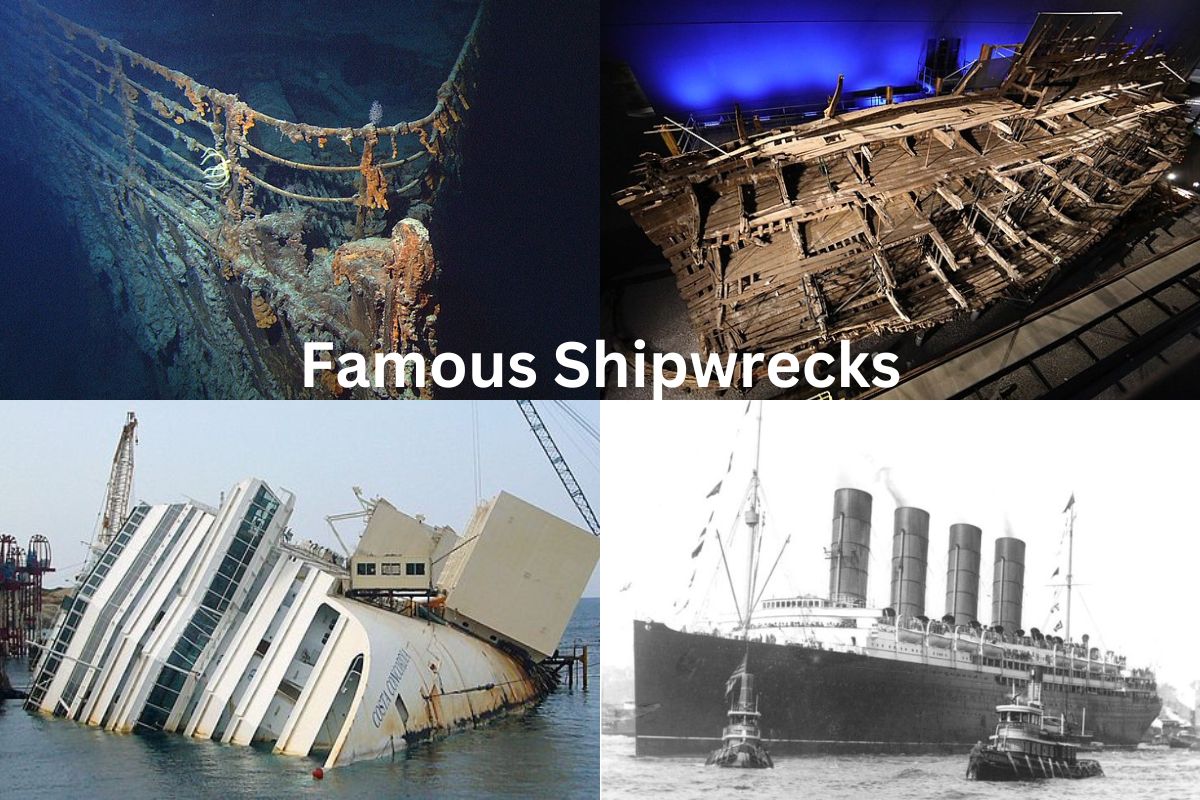
13 Most Famous Shipwrecks
Throughout history, several famous shipwrecks have attracted the attention and imagination of people all across the world.
Some of these wrecks are well-known for their tragic results, while others are noteworthy for their historical significance or the priceless items they contain.
The stories behind these sunken vessels continue to intrigue us to this day, from the tragic voyage of the Titanic to the eerie ruin of the Lusitania. Some historic shipwrecks, such as the Mary Rose and the Vasa, provide insight into past lives and technologies.
While the causes and circumstances of each disaster differ, they all have one thing in common: human tragedy, perseverance, and the enduring mystery that surrounds lost ships and their secrets hidden beneath the waves.
Famous Shipwrecks
1. titanic (1912).
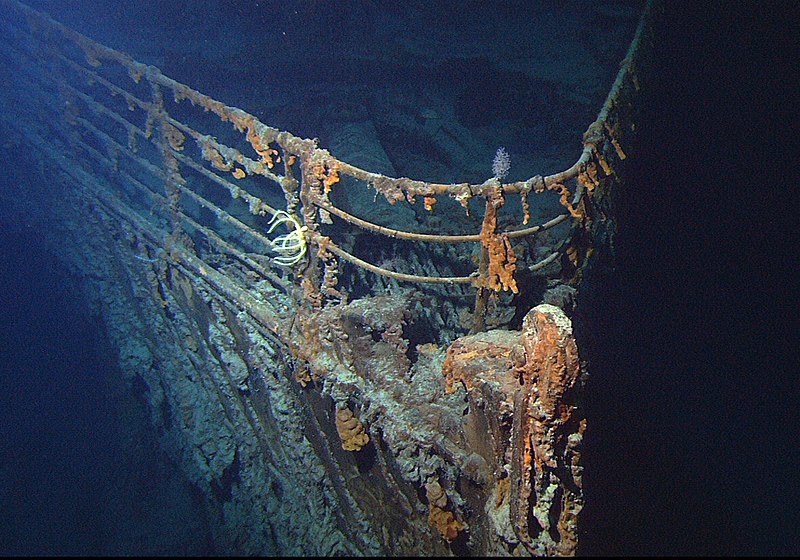
The Titanic was a British passenger liner that sank in the North Atlantic Ocean on April 15, 1912, after colliding with an iceberg on her maiden voyage from Southampton, UK, to New York City, USA.
The Titanic was intended to be one of the largest and most luxurious ships of its day, including swimming pools, Turkish baths, and a grand staircase. The ship was only four days into its journey when disaster struck.
The Titanic carried over 2,200 passengers and crew members, including several well-known figures like as business people, politicians, and entertainers. The Titanic’s collision with the iceberg caused considerable damage, and it was clear that the ship was sinking. Despite efforts to save it, the ship sank, killing around 1,500 people.
The sinking of the Titanic became a global disaster that captured the public imagination. The disaster generated a spate of inquiries and investigations, including one by the United States Senate, which resulted in significant revisions to marine safety regulations.
The Titanic’s legacy lives on in popular culture, with a plethora of literature, films, and television shows centered on the disaster. The Titanic remains one of history’s most infamous and terrifying ships, a testament to the fragility of human life and the dangers of the open sea.
2. Lusitania (1915)
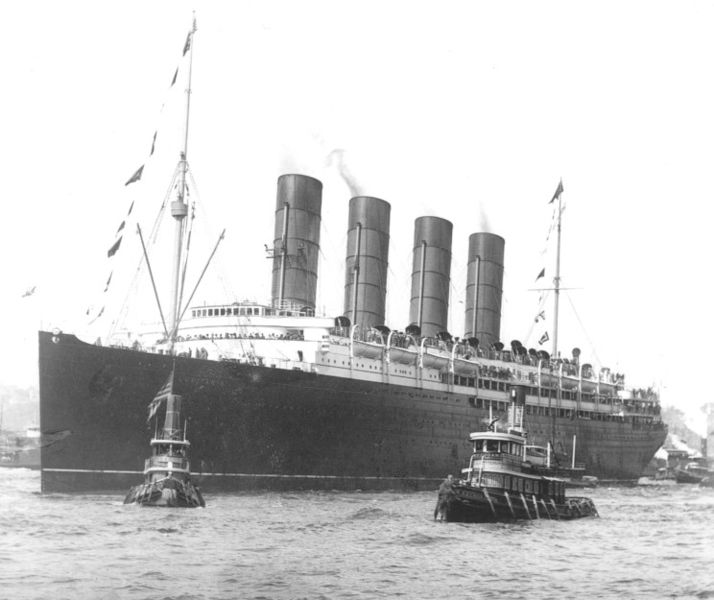
The Lusitania was a British ocean liner that was torpedoed and lost by a German U-boat on May 7, 1915, during World War I.
The ship was on her way from New York to Liverpool when it was hit by a single torpedo fired by the German submarine U-20, resulting in a catastrophic explosion that killed 1,198 passengers and crew members.
One hundred and twenty Americans were among those slaughtered, which heightened popular outrage against Germany and pushed the United States closer to war.
The sinking of the Lusitania was a momentous event in the war and had a huge impact on public opinion. It was widely criticized as a horrible act of war against civilians, and those advocating for the United States to join the Allies used it as a rallying cry.
The sinking also had long-term consequences for maritime warfare, resulting in modifications in ship design, the deployment of convoy systems, and other efforts to safeguard civilian vessels.
The Lusitania’s wreck was discovered off the coast of Ireland in 1935, and efforts to study and document the ship’s remnants have continued to this day. The sinking of the Lusitania is still remembered as a tragic and major event in both World War I and maritime disaster history.
3. Andrea Doria (1956)
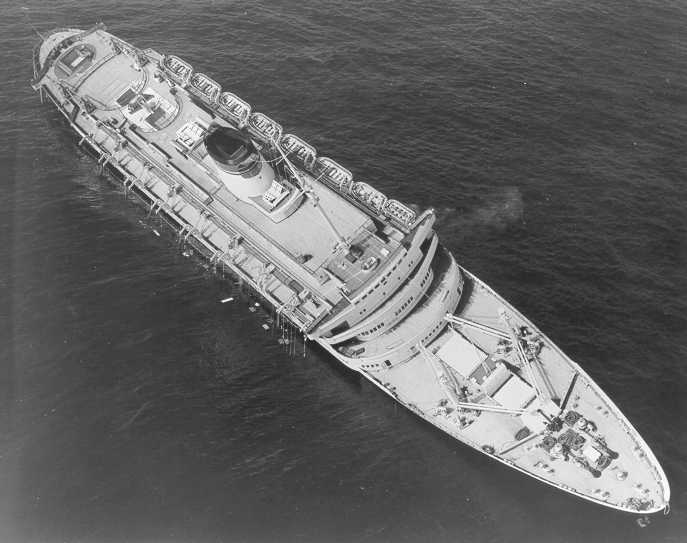
The Andrea Doria was an Italian luxury liner that sank on July 25, 1956, off the coast of Massachusetts after colliding with the Swedish ship Stockholm. The crash occurred in dense fog and killed 46 persons on board the Andrea Doria.
The Andrea Doria’s sinking was one of the biggest maritime disasters in American history, and it received extensive coverage in the media at the time. The ship was carrying many wealthy and renowned passengers, including movie stars and European aristocracy, which contributed to the tragedy and drew the attention of the public.
Despite the severity of the collision, the majority of passengers and personnel on board the Andrea Doria were able to escape safely thanks to the prompt response of surrounding ships and the coast guard.
The accident also highlighted technological developments and safety precautions in the maritime sector, since many people were saved by newly built life rafts and life jackets.
Due to its remarkably intact condition and placement in a relatively shallow section of the Atlantic, the wreck of the Andrea Doria remains a popular site for deep-sea divers today. The Andrea Doria’s sinking is remembered as a tragic incident in the history of ocean liners .
4. USS Arizona (1941)
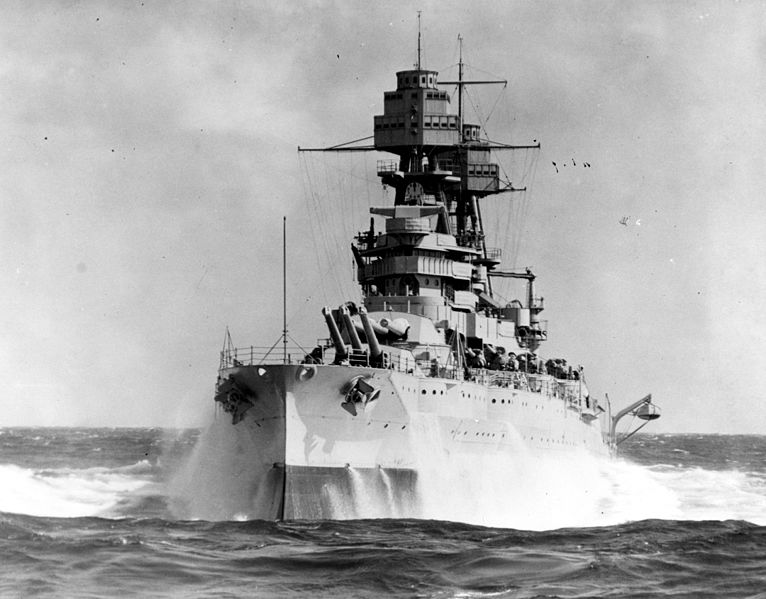
The USS Arizona was a United States Navy battleship that was sunk during the Japanese attack on Pearl Harbor on December 7, 1941, which precipitated the country’s entry into World War II. The ship was commissioned in 1916 and served as part of the United States Pacific Fleet out of Pearl Harbor, Hawaii.
The USS Arizona was a battleship of the Pennsylvania class that measured more than 185 meters in length and weighed more than 34,000 tons. When it was commissioned, it was fully outfitted with deadly armaments and regarded as one of the most powerful battleships in the world.
During the attack on Pearl Harbor, the USS Arizona was hit by numerous bombs, causing the ship to explode and sink swiftly, killing 1,177 sailors and Marines on board, accounting for over half of the American casualties.
The USS Arizona now stands at the bottom of Pearl Harbor as a national monument and memorial to the sailors and Marines who perished on board. The ship is a somber reminder of the sacrifices made by American service members during WWII, and it has come to symbolize the country’s determination to protect its freedom and beliefs.
5. HMS Bounty (1789)
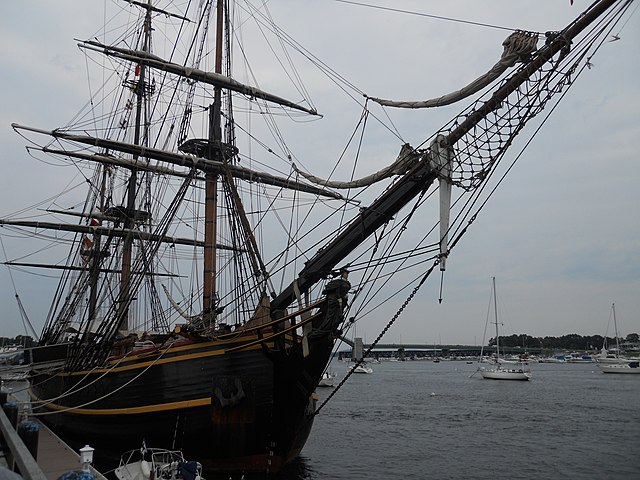
The HMS Bounty was a British Royal Navy ship most known for the on-board mutiny in 1789. The Bounty was built in 1784 to bring breadfruit from Tahiti to the West Indies as part of a British endeavor to cultivate a new crop for enslaved workers.
During the voyage to Tahiti, conflicts between the crew and the ship’s commander, William Bligh, erupted, and in April 1789, a gang of mutineers led by Fletcher Christian seized control of the ship, leaving Bligh and many of his ardent supporters alone in a tiny boat.
The Bounty continued to sail after the mutiny, with Christian and the mutineers finally settling on Pitcairn Island in the South Pacific. The ship was burnt and sunk to prevent notice.
The fate of the mutineers and their descendants on Pitcairn Island was unknown for many years, but academics were able to piece together the account of the mutiny and its aftermath in the twentieth century.
The story of the HMS Bounty and the mutiny on board has inspired innumerable books, films, and other works of popular culture, and the ship has become an iconic symbol of the hazards and perils of discovery and adventure.
6. Mary Rose (1545)
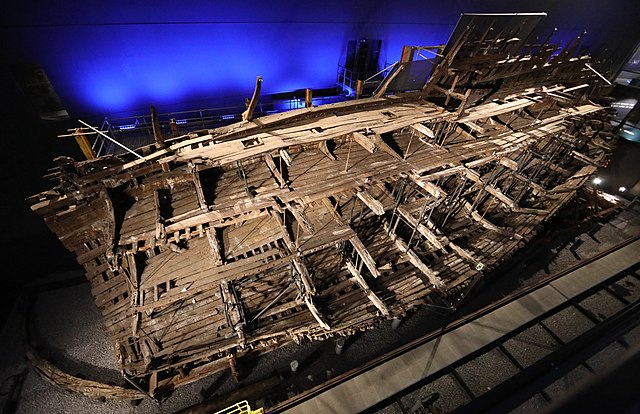
The Mary Rose was an English Tudor navy warship that was launched in 1511 during King Henry VIII’s reign. The ship took part in various battles, including the Battle of the Solent against the French navy in 1545. The Mary Rose overturned and sank during this combat, killing the majority of the crew and soldiers on board.
The wreck’s location was unknown for centuries until it was found in 1971 and lifted from the seabed in 1982. The ship’s wreckage and artifacts have been carefully conserved and are currently on display at the Mary Rose Museum in Portsmouth, UK.
With its combination of conventional sailing methods and developing technologies like as guns and gunpowder, the Mary Rose symbolizes a unique period in English naval history.
The ship also provides a look into Tudor life and society, since objects discovered on board reveal details about the crew and soldiers’ daily routines.
The Mary Rose is now a renowned tourist attraction as well as a symbol of England’s maritime heritage. Historians and archaeologists continue to study the ship and her remains, providing unique insights into the Tudor age and the evolution of naval warfare.
7. Vasa (1628)
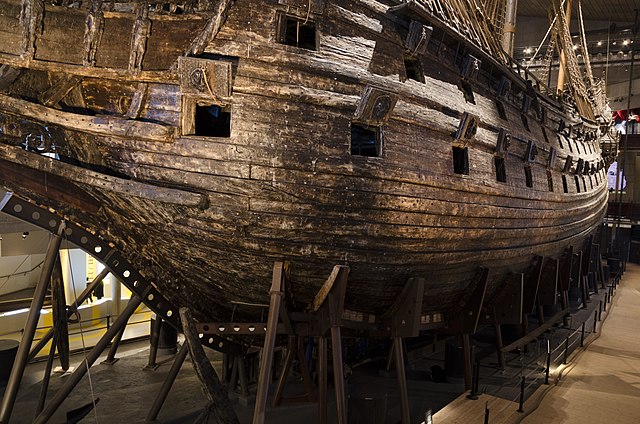
The Vasa was a Swedish warship that sank in 1628 on its maiden voyage. King Gustavus Adolphus commissioned the ship, which was one of the largest and most heavily equipped warships of its day. The ship crashed and sank mere minutes after setting sail due to design problems and top-heavy construction.
The Vasa was lost for over 300 years before being recovered and salvaged in 1961. The ship and her treasures are now on display in Stockholm’s Vasa Museum.
The Vasa is notable because it is one of the most complete and well-preserved 17th-century warships. The ship and its artifacts provide fascinating insights into the era’s technology, workmanship, and daily living. The Vasa has also rekindled interest in marine archaeology and preservation, as well as the development of innovative underwater excavation and restoration techniques.
The Vasa Museum is now a renowned tourist destination and a symbol of Swedish naval history. Historians and archaeologists continue to study the ship and her artifacts, providing unique insights into the history of naval combat and the development of shipbuilding technology.
8. RMS Empress of Ireland (1914)
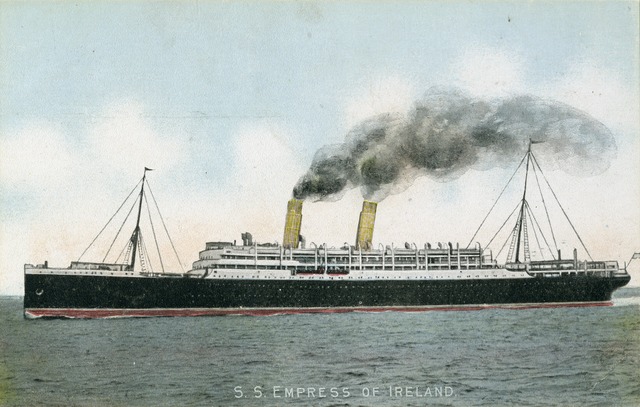
The Canadian Pacific passenger liner RMS Empress of Ireland sank in the St. Lawrence River on May 29, 1914, after colliding with the Norwegian coal ship Storstad. The collision occurred in severe fog, and the Empress of Ireland collapsed and sank within minutes, killing 1,012 people.
The sinking of the Empress of Ireland is regarded as one of Canada’s worst maritime tragedies. The majority of the passengers were Canadian immigrants and their families, making it an especially terrible occurrence for the country. The accident also had long-term consequences for maritime safety, prompting improvements in ship design and navigation laws.
The search for and exploration of the wreck of the Empress of Ireland began in the 1960s and has continued to this day. The wreck is now preserved by the Canadian Heritage Rivers System and is a popular destination for divers and nautical history buffs.
The sinking of the Empress of Ireland is an important event in Canadian history that serves as a reminder of the risks of nautical travel. It also demonstrates the bravery and heroism of the rescuers who risked their lives to save others during the crisis.
9. USS Indianapolis (1945)
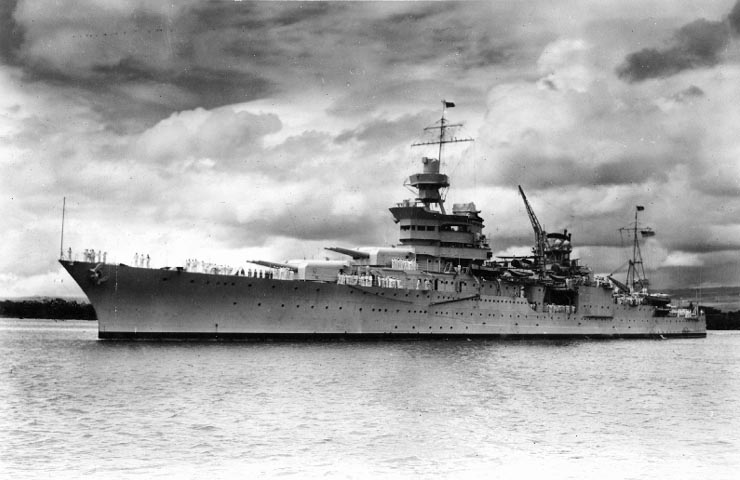
The USS Indianapolis was a heavy cruiser in the United States Navy that played an important part in World War II’s Pacific theater. The ship was returning from a top-secret mission to carry components of the atomic bomb to Tinian Island when it was sunk by a Japanese submarine on July 30, 1945.
The ship sank swiftly, and rescue efforts were hampered by communication breakdowns, leaving many crew members stranded in shark-infested seas for days.
Just 316 of the nearly 1,200 crew members on board survived, making it one of the bloodiest events in US Navy history. Because of the nature of the Indianapolis’ mission and the awful conditions faced by the survivors, the sinking drew significant attention.
The USS Indianapolis tragedy has been memorialized in novels, movies, and films, and survivors have tried to ensure that the ship and its crew’s narrative is not forgotten. The wreck of the USS Indianapolis was discovered in 2017, and efforts are now ongoing to preserve and document the ship’s wreckage.
The sinking of the USS Indianapolis is a terrible reminder of the sacrifices made by service members during times of war, as well as the perils that might be encountered at sea.
The survivors and relatives of those who perished continue to remember the ship and its crew, ensuring that their sacrifice is not forgotten.
10. Bismarck (1941)
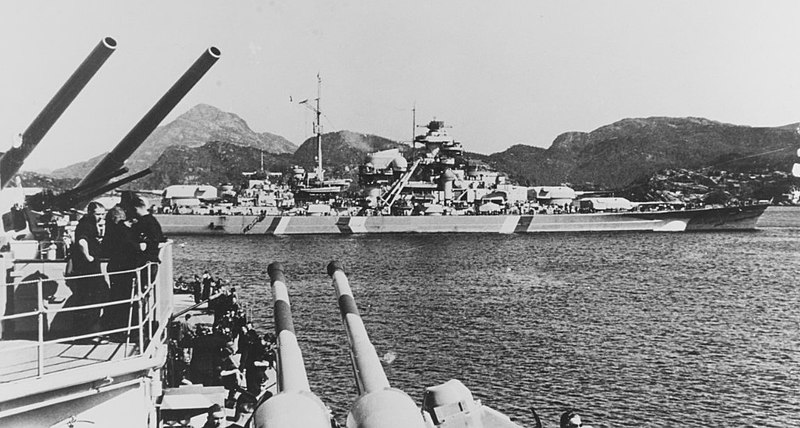
During World War Two, the Bismarck was a German battleship that was sunk by the British Royal Navy on May 27-28, 1941. The Bismarck was one of the largest and most powerful battleships of its time, posing a serious threat to British naval forces in the Atlantic.
The sinking of the Bismarck was a momentous success for the Allies, and it is regarded as one of World War II’s most crucial naval battles. Over several days, British forces pursued the ship mercilessly until it was crippled and sunk by torpedoes and gunfire from British warships. Only 114 of the Bismarck’s 2,200 crew men survived.
The loss of the Bismarck changed the direction of the war by removing a major threat to Allied ships in the Atlantic. The action also demonstrated the force and efficacy of naval warfare throughout WWII, and it remains a key event in naval warfare history.
The Bismarck wreck is now a famous destination for deep-sea divers and has been the topic of countless films and publications. The ship is still a symbol of war’s strength and destruction, as well as a reminder of the human cost of war.
11. SS Edmund Fitzgerald (1975)
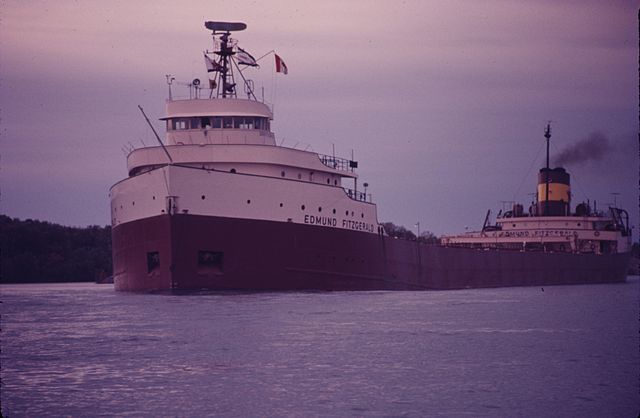
The SS Edmund Fitzgerald was an American Great Lakes freighter that sank in Lake Superior during a strong storm on November 10, 1975. The ship’s 29 crew men were all killed, and the wreck is still at the bottom of the lake today.
The Edmund Fitzgerald’s sinking is one of the most well-known and analyzed maritime tragedies in American history. The ship was transporting a significant cargo of iron ore pellets when it encountered a storm with hurricane-force winds and 35-foot-high waves. Despite the crew’s and rescue teams’ efforts, the ship eventually split in two and sank.
The incident got considerable media coverage and inspired a popular ballad by Canadian singer-songwriter Gordon Lightfoot, which helped to draw attention to the tragedy and its impact on the crew members’ families.
The sinking also resulted in greater Great Lakes maritime safety laws and training, as well as advances in weather forecasts and communication.
The wreck of the Edmund Fitzgerald is now a prominent dive site and a symbol of the dangers and difficulties of nautical travel. The ship is a sad reminder of the bravery and sacrifice of people who work at sea, as well as a memorial to those who died in the disaster.
12. Costa Concordia (2012)
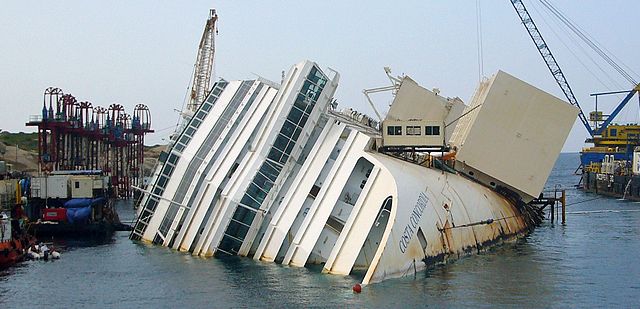
The Costa Concordia was an Italian cruise ship that sank off the coast of Italy on January 13, 2012, after colliding with a rock formation near Giglio. The tragedy killed 32 individuals and caused severe environmental harm in the surrounding area.
The Costa Concordia’s sinking was one of the most high-profile maritime disasters in recent history, with widespread media coverage worldwide. Francesco Schettino, the ship’s captain, was heavily chastised for his conduct during and after the accident, including delaying evacuation and leaving ship before all passengers had been evacuated.
Salvage efforts for the Costa Concordia began in 2012 and took several years to finish. After being refloated, the ship was transported to Genoa, where it was destroyed for scrap.
The Costa Concordia’s sinking emphasized the need of cruise industry safety standards and training, as well as the need for increased accountability for individuals in positions of control on board ships.
The accident also heightened public awareness of the environmental effect of large-scale cruise ships and the importance of responsible industrial operations.
The Costa Concordia is still a sobering reminder of the hazards of seafaring travel and the necessity of safety and accountability in the maritime industry today.
13. The Batavia (1629)
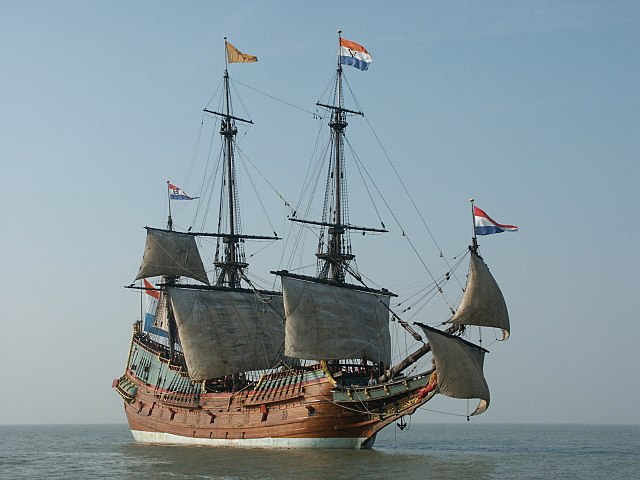
In 1629, the Dutch East India Company ship Batavia was destroyed on a reef off the coast of Western Australia. The ship was carrying important cargo as well as a significant number of passengers and staff, including soldiers and officials from the Dutch East Indies colony.
Following the catastrophe, a group of troops led by high-ranking official Jeronimus Cornelisz launched a savage campaign of murder and mutiny against their fellow survivors. Almost 100 persons were slaughtered by the mutineers before they were defeated by a relief force sent from the neighbouring island of Java.
The Batavia’s story has become legendary for its combination of adventure, betrayal, and tragedy. The ship’s wreck and its treasures have been the focus of ongoing study and excavation, and the events surrounding the mutiny continue to intrigue historians and nautical history enthusiasts.

Earth and World 2024
Top 10 most famous and incredible shipwrecks.
A wreck is the remaining parts of a ship that has destroyed, which are found either stranded ashore or submerged to the base of a waterway. Wrecking might be intentional or unplanned. In January 1999, Angela Croome assessed that there have been around three million wrecks worldwide (a gauge quickly embraced by UNESCO and different associations). Here are the 10 most incredible and famous shipwrecks in the world,
Famous Shipwrecks
1.ms world discoverer.
One of the famous Shipwrecks, the MS World Discoverer was a Danish voyage send made in 1974. While conveying travellers on a journey in 2000 it struck a stone at the Solomon Islands, bringing about the ship dying down. A pain flag was immediately dispatched and all team and travellers were escorted securely to another traveller ship.
There have been a few endeavours to rescue the wreck, however, none have been fruitful, incompletely because of the way that a significant part of the ship has been plundered and harmed amid the Solomon Islands Civil War. The ship has stayed at Roderick Bay from that point onward and is currently a prominent nearby vacation destination and it can even be seen on Google Maps.
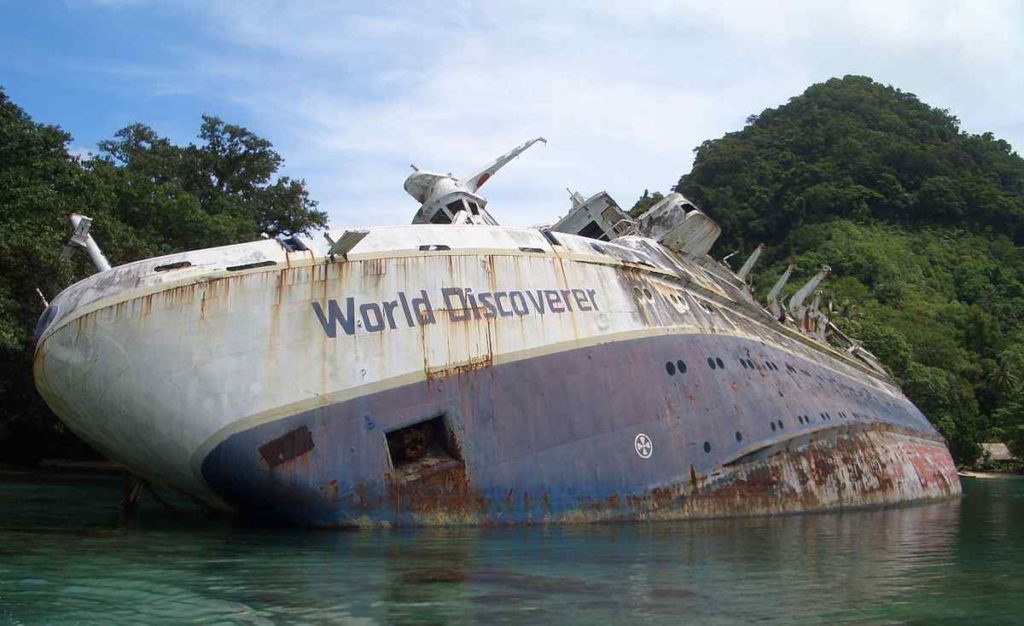
Image Source: Wikimedia
2. THE BLACK SWAN
The Black Swan or The Black Swan Project is accepted to be the best recuperation of gold fortune ever. The fortune was found on the remaining parts of the Spanish warship Nuestra Senora de las Mercedes which sank off Portugal in 1804. In 2007 the American organization Odyssey Marine Exploration reported that it had revealed gold worth an expected $500 million (£314 million).
In any case, the Spanish government pronounced that they legitimately claimed the gold, and the case went the whole distance to the US Supreme Court, just for the gold to come back to Spanish experts in 2012, where it is presently shown in different presentations the nation over. It is one of the famous Shipwrecks in the world.
Also Read: Top 10 Largest Cruise Ships in 2019
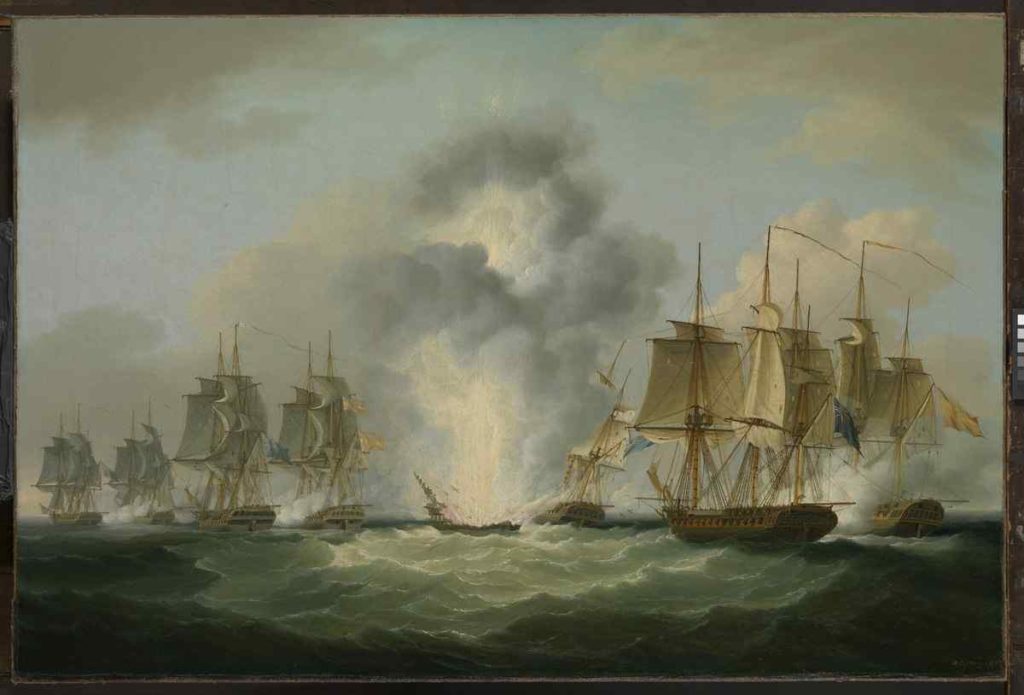
3. MV DONA PAZ
The sinking of the MV Dona Paz is recalled in history as the deadliest of all peacetime oceanic distasters. It was a Philippine enlisted ship and keeping in mind that extending 4,000 travellers, slammed into an oil tanker MT Vector on December 20, 1987. A flame and blast followed, executing an anticipated 4,386 travellers and there were just 24 survivors.
The absence of appropriate wellbeing and correspondence measures were accused, and it allegedly took 8 hours for the Philippine sea specialists to know about the occurrence. Because of the flame much FO the ship was demolished, and it is presently recognized as “Asia’s Titanic.”

4. THE QUEEN ANNE’S REVENGE
Ruler Anne’s Revenge was an eighteenth-century warship for the most part known for being the ship of unbelievable privateer Blackbeard (Edward Teach). First serving in the British Navy, the ship was later caught by the French and afterwards by privateers from 1717 onwards. Despite the fact that Blackbeard utilized the ship for not exactly a year, he accomplished a portion of his most noteworthy prizes amid this time. In 1718 he grounded the ship and relinquished it, getting away caught by the British by boarding a littler adjacent ship.
In 1996 the remaining parts of Queen Anne’s Revenge were found, around one mile aground from Atlantic Beach, North Carolina. So far thirty one standards have been found and in excess of a fourth of a million relics have been recuperated. As one of only a handful couple of privateer boats to be found, it is currently recorded on the US National Register of Historic Places.
Vasa is a Swedish warship, accepted to have been worked somewhere in the range of 1626 and 1628. The ship sank twenty minutes into its first venture on 10 August 1628 in the wake of being hit by solid breezes and flooding. Sinking not exactly a mile into its voyage, it was viewed as an incredible embarrassment for the King of Sweden, and there were a few rescue endeavors, however none were effective.
One of the famous Shipwrecks was not until 1961 that the wreck was effectively recuperated, including a large number of antiques. The structure of the ship was observed to be surprisingly in propriety and with the assistance of some rebuilding, the ship is presently a mainstream Swedish vacation destination, with more than 22 million guests to date.
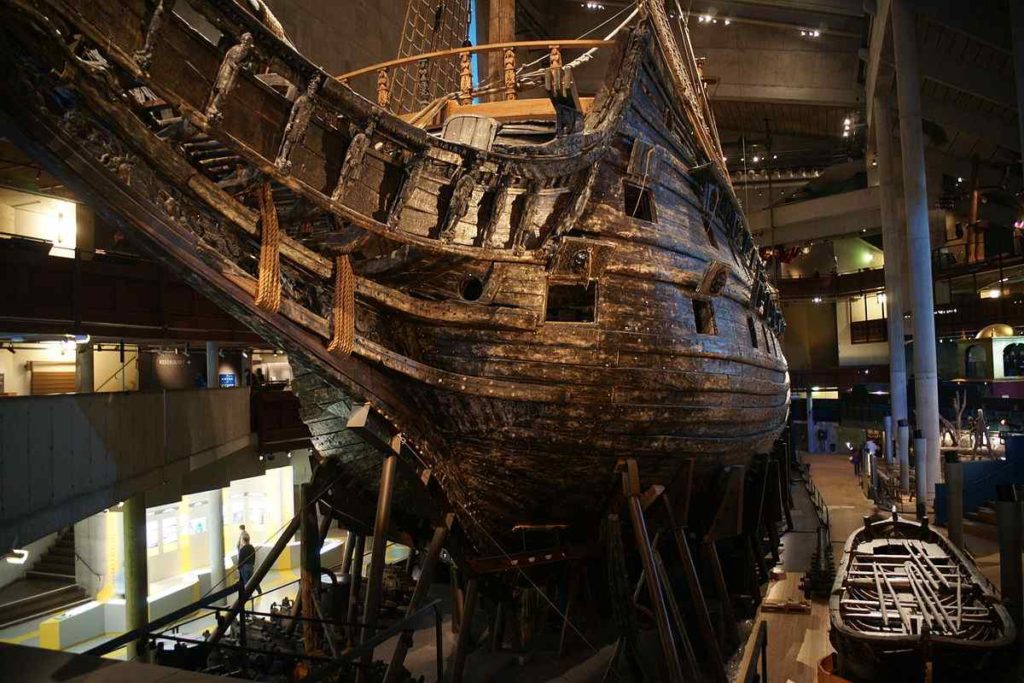
6. THE MARY ROSE
The Mary Rose was a Tudor warship dispatched and keep running amid the rule of Henry VIII. Propelled in 1511, it served in numerous fights against France, Brittany and Scotland, and in 1545 it sank amid a fight against the French. Soaking in the Silent, near the Isle of Wight, it was not rediscovered until 1971 and was rescued in 1982. The remaining parts of the wreck are currently distinguishable in an exhibition hall in Portsmouth and have turned out to be a standout amongst the most costly and far-reaching ventures in sea prehistoric studies history.
Notwithstanding the ship’s structure itself, more than 26,000 antiques have been recouped – a significant number of which are presently on open showcase. The remaining parts of about portion of the perished team individuals have likewise been recuperated, and the bone investigation has uncovered that many experienced wellbeing conditions, for example, joint pain, rickets and scurvy. It is one of the famous Shipwrecks.
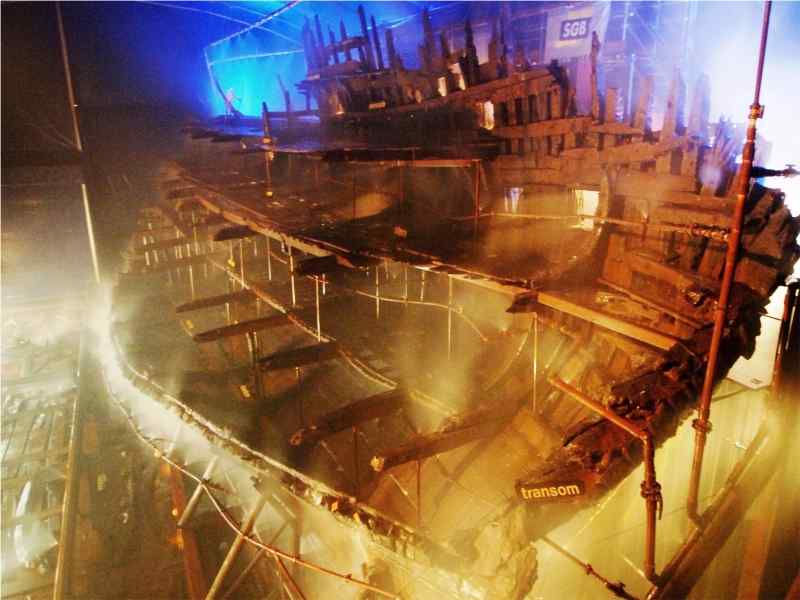
7. USS ARIZONA
The USS Arizona was an American warship worked for the US Navy propelled in 1915. The ship has filled some needs, from escorting President Woodrow Wilson to the Paris Peace Conference to being sent to Turkey amid the Greco-Turkish War, and was sent from California to Pearl Harbor, Hawaii in 1940 because of the risk of Japanese Imperialism.
On 7 December 1941 USS Arizona was shelled by the Japanese, detonating and sinking. 1,177 group individuals and officers were murdered. The wreck was pronounced a National Historic Landmark on 5 May 1989. Today the wreck remains and can be seen at the USS Arizona Memorial, and is every year visited by two million individuals.
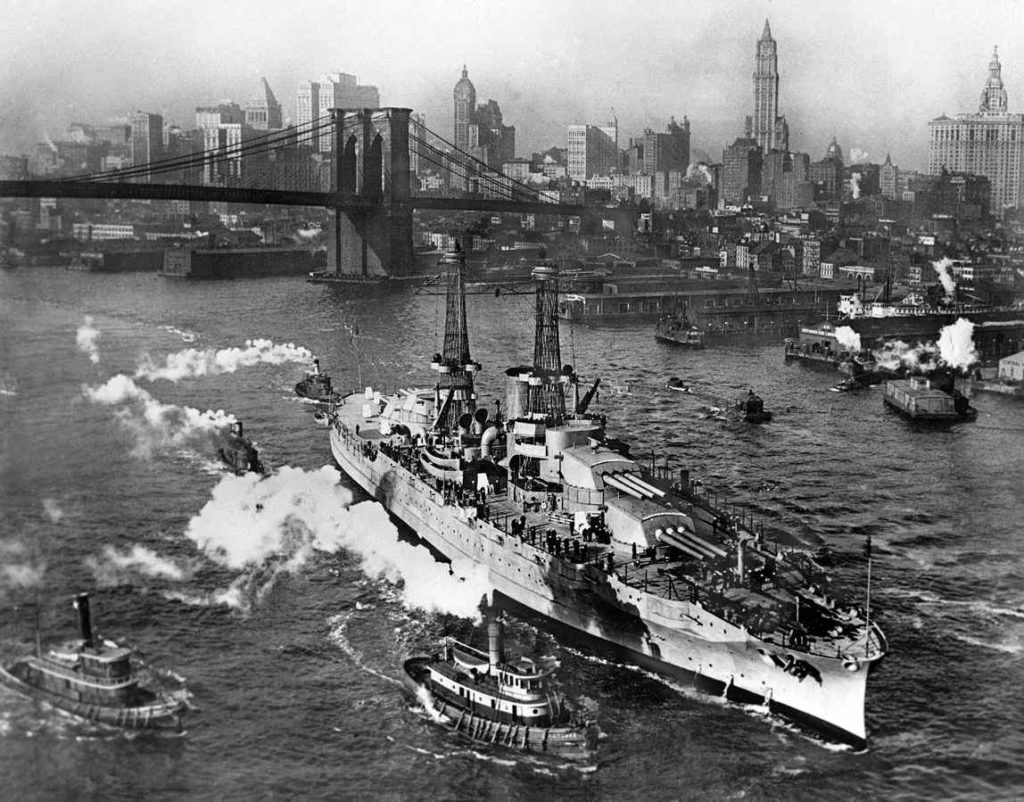
8. RMS LUSITANIA
RMS Lusitania was a British sea liner propelled in 1906, and made an aggregate of 202 trans-Atlantic intersections previously it was torpedoed and sunk by a German U-pontoon on 7 May 1915. Of the 1,962 travelers and team on board, 1,191 lost their lives. Causing shock and stun over the world some trust it was a central point in urging the US to enter World War II as a partner.
Today the shipwreck is in a condition of extreme deterioration. As it had been working for a long time before sinking, it is in much more awful condition contrasted with The Titanic and much was demolished upon the underlying impact of the torpedo. It lies 11 miles south of the beacon at Kin sale, Ireland. There have been different rescue endeavours of the Lusitania, with a considerable lot of the rest of the ship’s things being recuperated, some of which are exclusive while others are on showcases in galleries around the globe.
9. RMS REPUBLIC
The star of Billion Dollar Wreck, the RMS Republic was worked in 1903 and worked as a steam-fueled sea liner. It wasn’t until 23 January 1909 at 5:30 a.m. that disaster struck, crashing into the Lloyd Italiano liner SS Florida simply off Nantucket, Massachusetts and sinking the following day at about 8.40 p.m. A sum of six lives were lost, and the evacuation procedure was adulated as immaculate at the time. Since the sinking, there have been numerous bits of gossip and legends encompassing the fortune that as far as anyone knows ran down with the ship.
Running from $250,000 to $3,000,000 in evaluations of the estimation of the submerged fortune – whenever exhumed today it could be worth a huge number of dollars – maybe even a billion. It is presently child and father Grant and Martin Bayerle’s central goal on Billion Dollar Wreckto recoup the reputed fortune and guarantee it as their own. The wreck itself is 250 feet submerged and quite a bit of it has crumbled – anyway, the vaults that contain the supposed fortune hmave all the earmarks of being particularly incivility.
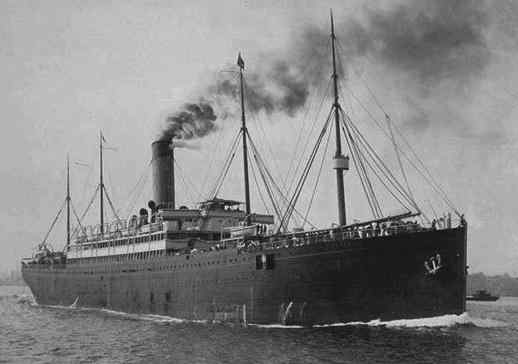
10. RMS TITANIC
Pretty much everybody thinks about Titanic – and its destiny. A ton of us will know it from James Cameron’s 1997 uber blockbuster Titanic, which included genuine film of the ship’s creepy remains. The probably “resilient” sea liner set sail on its first journey on 10 April 1912 just to hit a chunk of ice just before midnight on 14 April and sank in under three hours. Guaranteeing 1,514 lives, it is regularly recognized as a standout amongst the most popular and disastrous wrecks ever.
It wasn’t until 1985 that a Franco-American campaign could achieve the wreck, and found that it had been part down the middle – with every half existing in about 33% of a mile separated from each other. The stern area was observed to be totally disintegrated, whereas the bow is in much better condition, with a portion of the insides extraordinarily unblemished. Many curious have been uncovered from the wreck and can be seen in different displays the world over – from silverware to furniture and even menus.
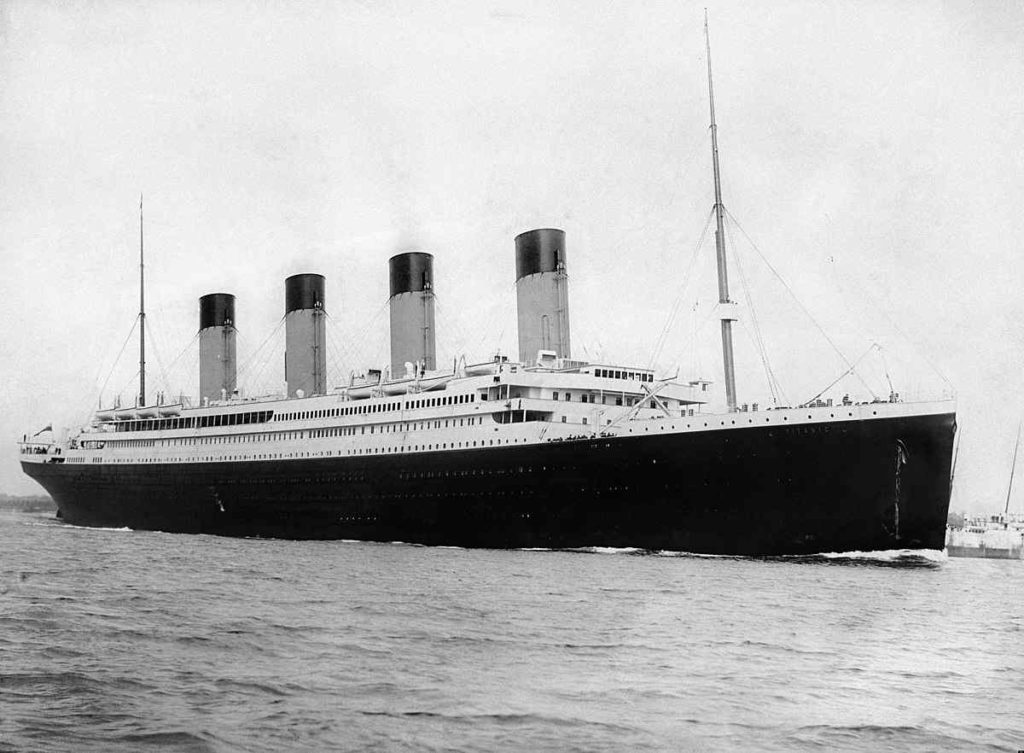
Image Source: Wikipedia
These are the 10 most incredible and famous shipwrecks. Do post your comments.
Related Posts:
- Top 10 Most Incredible Caves in the World
- Top 10 Most Incredible Roman Theaters
- Top 10 Incredible And Amazing Arctic Birds
- Top 10 Most Famous Monuments Of Ancient Egypt
- Top 17 Most Famous Churches In The World
- Top 15 Most Famous Bridges In The World

Recommended for you
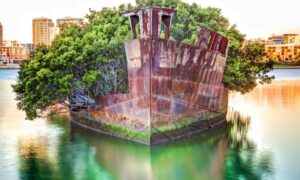
Popular Posts

The Biggest Casinos in Canada
A gambler is always curious about trying out different casinos to improve their experience....

Delving into the World of Exotics: Exploring Unique Sports Betting Options
These wagers venture beyond the standard game outcome predictions, delving into specific aspects of...
The Mathematics of Chance: Exploring Randomness
In the vast universe of numbers and predictions, the mathematics of chance offers a...

What is Biometric Verification? A Complete Guide
Biometric verification is revolutionizing the way we confirm identity, offering a secure and efficient...

Top 7 Countries to Visit for Gambling
Gambling enthusiasts often seek destinations that offer an exciting and varied gaming experience unlike...
Recent Posts

Exploring Gambling As Entertainment: Benefits & Risks
Gambling as a form of entertainment has taken top places in the popularity charts...

The Healing Power of Planting a Tree in Memory of a Loved One
Losing a loved one can be one of life’s most difficult experiences. In the...

How to Make Your Family Snow Park Adventure Unforgettable
As you eagerly gaze out the frost-covered window, imagining the pristine white landscapes awaiting...
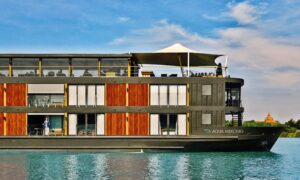
Unveiling the Unparalleled Luxury of Aqua Expeditions ─ A Journey Like No Other
Embarking on a journey across the world’s waterways has long been a dream for...

How to Effectively Accept Credit Card Payments ─ 10 Tips for Businesses
During the last ten or so years, there has been a notable shift in...

30 Famous Shipwrecks In The World
Shipwrecking is truly a big loss of material possessions and human lives. A rough estimate by the United Nations shows at least 3 million shipwrecks are lying across ocean floors. There are over 5000 shipwrecks in the Great Lakes that have taken the lives of over 30,000 mariners. There is also a shipwreck museum at whitefish point.
Several maritime accidents in the past, as depicted in popular movies, poems and dramas, depict the heartwrenching tales of lost ships, their lamenting crew and hopeless passengers who drowned in the depths of oceans and seas.
Shipwrecks are essential discoveries that tell stories of the past, helping us connect the dots in history. For future generations, shipwrecks provide a window to the long histories of conflict, survival, and the history of destinies. They are testimonies to the trade and cultural exchanges of our predecessors.
Over countless centuries, many ships have fallen prey to accidents caused by human negligence. Nonetheless, these shipwrecks excite history buffs and laypeople alike. They are often seen as treasure chests and shrouded in mystery.
Many enthusiastic travellers, brave warriors and merchants have found their final resting place at the bottom of mighty seas and oceans. In addition to being important sites of cultural interest, these historical monuments contribute significantly to a healthy marine ecosystem and support recreation and the growing diving industry.
The Great Lakes Shipwreck Historical Society found Atlanta 650 feet below Lake Superior. The 172-foot schooner barge sank in 1891. Its recent discovery was the steamer Cyprus, which went down in 1907. North Carolina Coast also has a diverse history of seafaring.
Marine archaeologists have discovered many shipwrecks in the area, including the Queen Anne’s Revenge, the pirate Blackbeard, which sunk in 1718 CE, and USS Monitor, the earliest steamship with an iron hull, built for the Union during the American Civil War.
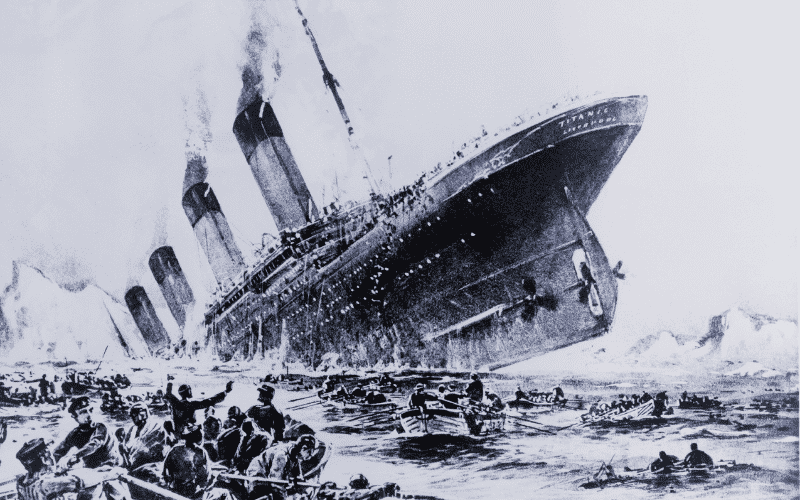
In this article, we take you through the pages of history to some of the precious maritime treasures on the ocean floor.
Table of Contents
1. SS Edmund Fitzgerald
The majestic SS Edmund Fitzgerald was an American freighter. The ship was launched on 7th June 1958 and was the biggest vessel to ply on the Great Lakes of North America at that time.
It carried a cargo of Taconite iron ore from mines near Minnesota to the ironworks in Ohio, Michigan and Detroit. She was a famous ship that broke its previous records and set new ones in its 17 years of service.

She embarked on her last unfortunate voyage from Wisconsin, near Duluth, on 9th November 1975. She was carrying a cargo of ore pellets and was headed by Captain Ernest M. McSorley.
The ship was destined for a steel factory in Detroit and was moving when she was joined by another ship SS. Arthur M. Anderson. The next day, both ships were caught in a strong storm with hurricane winds and almost 11 m high waves.
On the evening of 10th November 1975, Edmund Fitzgerald sank around 17 miles north-northwest of Whitefish Point, Michigan. The entire 29-member crew went down with it in what has become the greatest Great Lakes Shipping Tragedy of all time.
She was found by an aircraft belonging to the US Navy on 14th November 1975. Three expeditions were conducted at the site, and at the request of the family members of the crew, the ship’s bronze bell was retrieved on 4th July 1995.
2. HMHS Britannic
Belonging to the Olympic class of steamships, the White Star Line vessel was the youngest sistership of the RMS Olympic and the RMS Titanic. It was constructed to be a passenger liner; however, she functioned as a hospital ship from 1915 until she finally sank in November 1916.
She entered service before the First World War started. She was carefully designed, and lessons learned from the sinking of the Titanic were implemented in its construction to make it safe and comfortable.
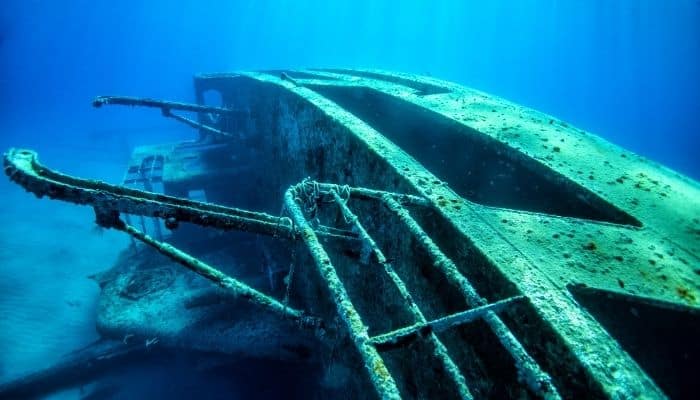
In 1915-16, she sailed between Britain and the Dardanelles. On 21st November 1916, she was shaken by a blast which occurred due to a naval mine of the German Navy. The incident took place near the Greek island of Kea in the Aegean Sea.
The ship sank around an hour later and killed 30 people. She became the biggest ship that sank during World War I and, more so, tragically. Of the 1066 people, 1036 survived and were rescued from the water and the lifeboats.
In 1975, its wreck was located, and it became the world’s biggest and most well-preserved passenger liner.
3. HMS Curacoa
HMS Curacoa was a light cruiser constructed for the Royal Navy. She functioned as a flagship most of the time. Assigned to the Atlantic Fleet in 1919, she was sent to the Baltic to support the British forces in their campaign during the Civil War in Russia.
After encountering a naval mine, she suffered damage and was sent to be repaired. Later she was shifted to the Mediterranean fleet in 1922-23 to support British Troops in Turkey.
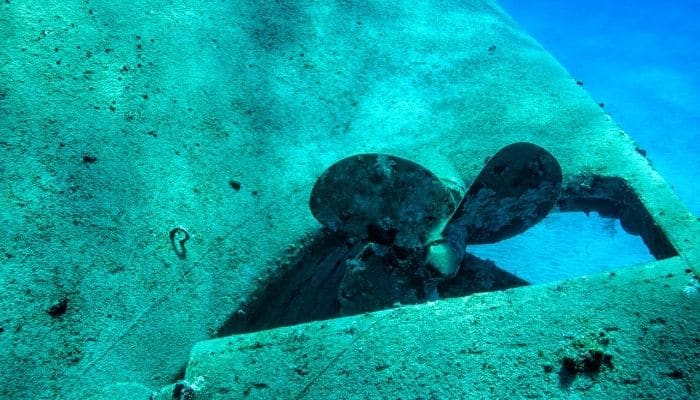
She was converted to a training ship in 1933, and in 1939, before the Second World War started, she was made into an anti-aircraft cruiser.
After 1940, she became an escort ship. In 1942, she escorted the RMS Queen Mary, which resulted in the tragedy. The former was carrying around 15,000 US troops and was moving in a zigzag course to avoid German bombers and possible enemy vessels.
Queen May caught up with the escort ship Curacoa and was trying to overtake her. One of the seamen of Curacoa, Ernest Watson, was admiring Queen Mary when he noticed its bow swinging toward the cruiser. He realised that the two ships were soon going to collide.
The 20 times bigger Queen Mary rammed into Curacoa’s metal plating and sliced it in half before it sank in no time. Out of 430 men onboard, only 99 seamen and 2 officers survived.
4. The fleet of Kublai Khan
Kublai Khan’s lost fleet is one of the most famous shipwrecks of old times. Two Mongolian invasion fleet attempting to attack Japan was wrecked in storms in 1274 and 1281, killing tens of thousands of troops.
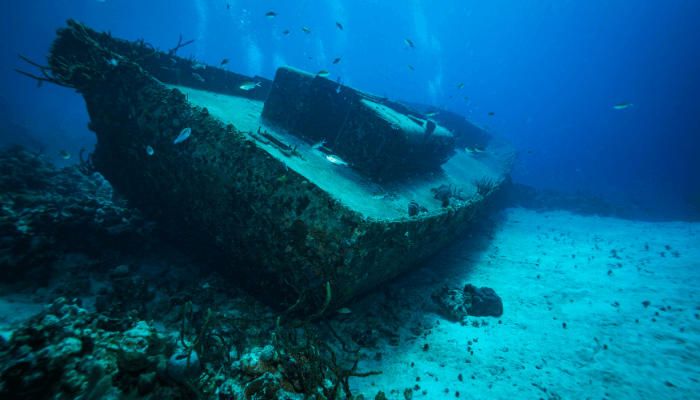
Several artefacts belonging to these vessels were found centuries later on the seabed of the Imari Gulf. In October 2001, an entire shipwreck claimed to originate from Fujian in south China was discovered by archaeologists.
Recently in 2015, archaeologists located a Mongolian ship in a bay close to the city of Matsuura, near the island of Kyushu.
5. The Spanish Armada
The Spanish Armada, a fleet of 130 ships on a mission to invade England in 1588, was disrupted by storms, and a large number of the Armada’s ships were wrecked on the coasts of Scotland and Ireland, killing around 5000 soldiers.
Among the drowned were most of the soldiers and crewmembers of the 32-gun warship La Juliana, built near Barcelona in 1570.
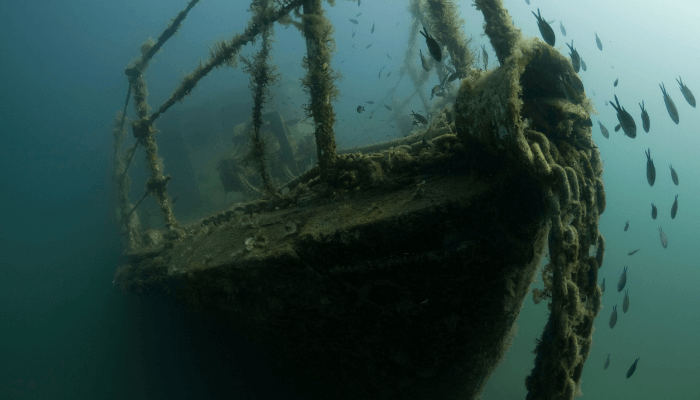
In 1985, local divers discovered the wreckage of three fleet vessels, including La Lavia, La Santa Maria de Vision, and La Juliana. In 2015, several cannons from La Juliana were found in the sands off Streedagh in Co Sligo.
6. RMS Titanic
RMS Titanic, the most famous ship for never making her destination, was the largest cruise ship of its time. The Titanic was built in Ireland at the Harland and Wolff shipyard. It was considered to be the most developed ship of that era.
However, the Titanic, famously described as ‘unsinkable,’ unfortunately sank after colliding against an iceberg on its maiden voyage- from Southampton to New York City- on 14 April 1912 in the North Atlantic Ocean.
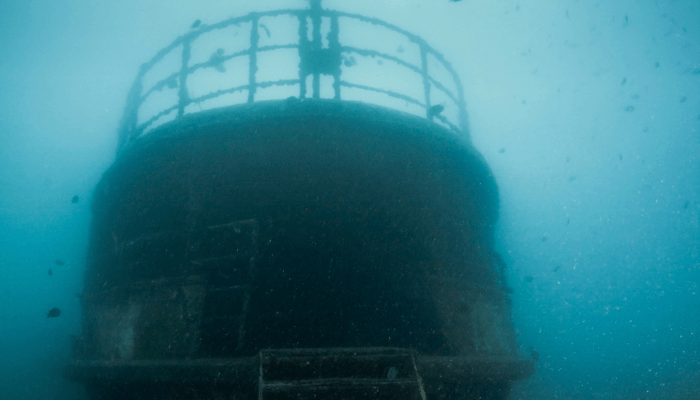
Around 1,517 people lost their lives in one of the biggest marine tragedies in history.
After many unsuccessful expeditions, the wreck was finally located by a joint French–American expedition in 1985. Several artefacts and debris have been removed from the shipwreck and are displayed in the National Maritime Museum in England.
Many schemes were proposed to raise the ship, but the fragile condition of the vessel prevented such plans. The 2001 UNESCO Convention now protects the wreck of the RMS Titanic.
7. RMS Empress of Ireland
Canadian ocean liner RMS Empress of Ireland sank near the mouth of the Saint Lawrence River on 29 May 1914 after colliding with the Norwegian collier SS Storstad due to thick fog, killing 1012 people.
The vessel was en route from Quebec City to Liverpool, with 1057 passengers and a crew of 420 abroad, when the ship went down in one of the worst disasters in Canadian maritime history.
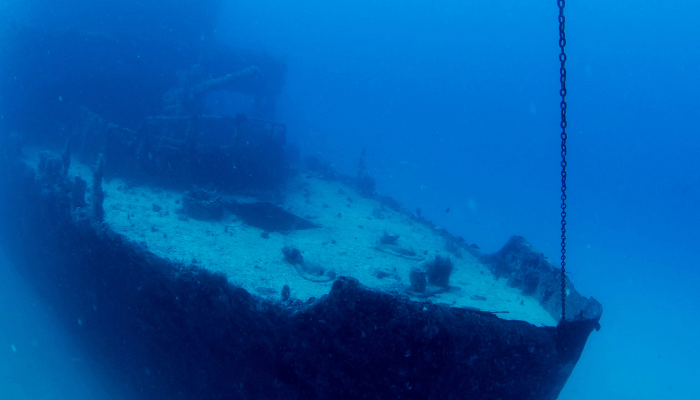
At present, the wreck of Empress of Ireland lies in a shallow 130 ft of water.
Several divers have recovered several valuables, including silver bars, a brass bell, and a stern telemeter, from the ship on several occasions after the incident.
8. MS Estonia
The Estonia ship casualty in the Baltic Sea is one of the biggest maritime incidents in the recent past. The cruise ferry MS Estonia, built in the German shipyard Meyer Werft, was en route to Stockholm from the Estonian province of Tallinn when it sank on 28 September 1994.
Over 800 people lost their lives in this horrifying incident, and most of the bodies were never recovered.
The cause of the accident remains controversial as there are many theories about the cause of the sinking. The most commonly known reason for the accident is said to be the rough weather conditions that the ship encountered.
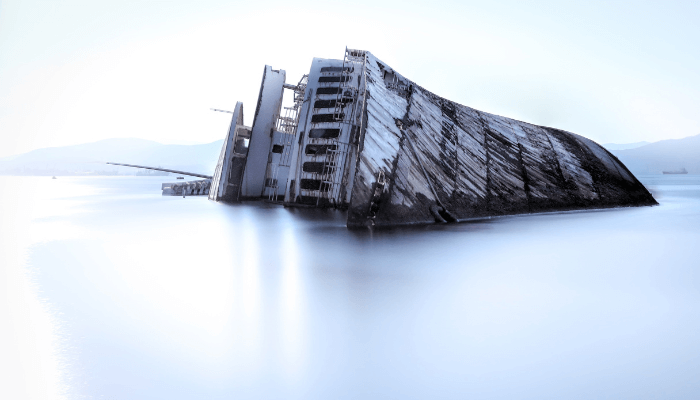
However, other sources disregarded this reason and stated that because of the ship’s military involvement, bombs were planted by rival countries to destroy the ship.
After the accident, there were demands from the relatives of the deceased to raise the vessel to give a land burial. And at the same time, there were discussions to raise the ship for a detailed inspection to know the cause of the accident.
However, the Swedish government decided to bury the vessel, and thousands of tons of pebbles were dropped on the site.
As per the Estonia Agreement 1995, the burial site has been designated as a sea grave and prohibited the exploration of the wreckage.
9. The Andrea Doria
The Italian ocean liner Andrea Doria sank after colliding against the Swedish ship MS Stockholm in July 1956, killing 46 people.
The vessel, which had 1,134 passengers and 572 crew members on board, was en route to New York City when it met with one of the most infamous maritime disasters in history.
However, despite the severity of the incident, not many lives were lost thanks to the timely communication by the ship’s authorities and commendable rescue efforts.
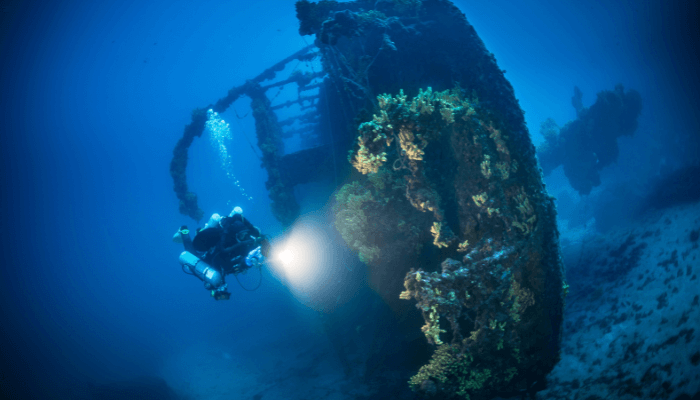
After the sinking of the vessel, divers Peter Gimbel and Joseph Fox managed to locate the wreck of Andrea Doria.
Today, resting in some 240 feet of the North Atlantic water, the wreck of Andrea Doria has become a popular site among scuba divers, being called “Mount Everest of scuba diving.”
10. HMS Victory
The 100-gun ship of the Royal Navy, HMS Victory, was launched in 1737 and met with an accident in the English Channel in 1744.
The sinking of HMS Victory, one of the worst British naval disasters in the English Channel, claimed the lives of more than 1,000 sailors.
The ship disappeared in the Channel Islands, and for over 250 years, there was no sight of any remains of the ship.
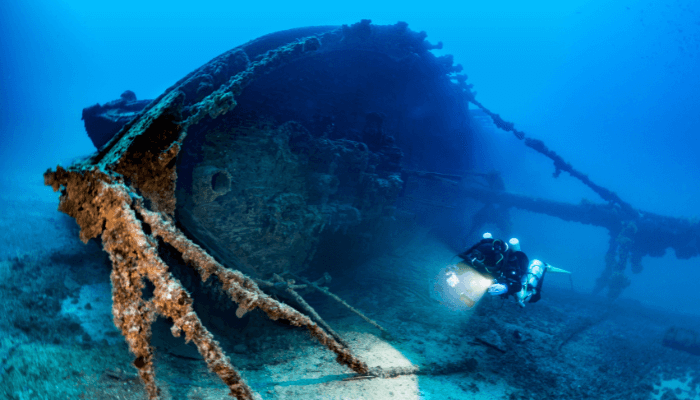
The shipwreck was discovered in 2008 by the Odyssey Marine Expedition of the United States around 43 nautical miles from where it encountered the storm and disappeared.
As a military wreck, the remains of HMS Victory are now the property of the British Government under maritime laws.
11. MV Doña Paz
The Philippine-registered passenger ferry MV Doña Paz was en route from Leyte Island to Manila when it sank after colliding with the oil tanker MT Vector on 20 December 1987.
One of the deadliest peacetime maritime disasters in history, the collision claimed the lives of at least 4,386 people.
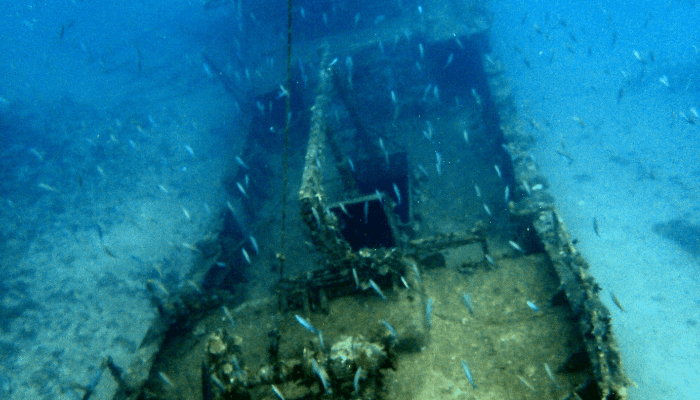
Reports then revealed that the vessel was overcrowded, the ship did not have a radio, and passengers didn’t have immediate access to life jackets.
The ship, now known as ‘Asia’s Titanic,’ was mostly destroyed in the collision due to the fire.
12. The Carpathia
The British passenger liner RMS Carpathia is best known for rescuing survivors from the Titanic when the cruise ship met with an accident.
However, Carpathia met with the same destiny when it was destroyed by a German submarine in the year 1917, at the time of World War I.

The vessel was attacked by three torpedoes from a German U-boat when it was moving as part of a convoy travelling from Liverpool to Boston, and five people were killed in the accident.
The Carpathia wreck was found in 1999 by a company known as Argosy International Ltd, in 600 ft of water, 298 km west of Land’s End, sitting upright on the ocean bed.
13. The Mary Rose
The Mary Rose was a warship in the navy of the Tudor King Henry VIII and was destroyed while leading an action against a French ship in Solent on the Isle of Wight on 19 July 1545.
The ship sank in a strait of the English Channel, claiming the lives of hundreds of men.
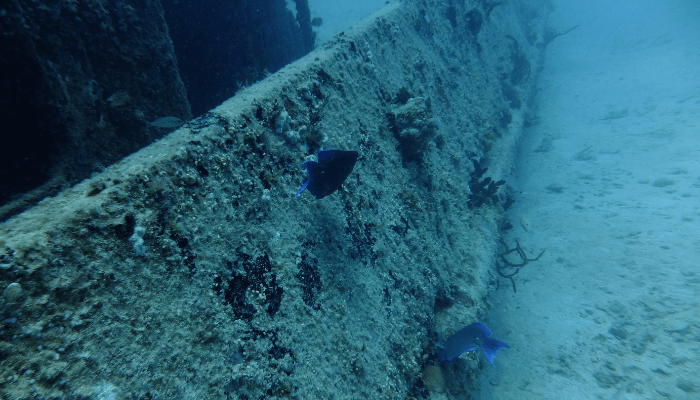
This shipwreck was salvaged in 1982 by the Mary Rose Trust, and now the artefacts are displayed in the Portsmouth Historic Dockyard.
The artefacts discovered in the Mary Rose were unique, offering immense knowledge about the equipment of naval warfare of that era.
14. The Vasa
The Vasa was a Swedish war vessel built during the 17th century, and it was the most high-tech warship when it set sail. However, the ship sank during its maiden voyage in the year 1628 in Stockholm Harbor.
Many unsuccessful attempts were made to raise the ship from the seabed in the following years.
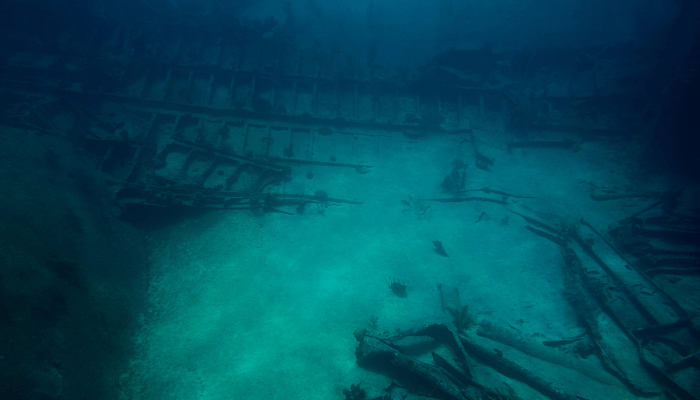
Finally, the Vasa was recovered in 1961, and at present, the remains of the Vasa are stored at the Vasa Museum in Stockholm, where it attracts more than a million visitors per year.
15. The Rhone
The iron-hulled steamship RMS Rhone was a UK Royal Mail Ship or packet ship owned by the Royal Mail Steam Packet Company. This ship was lost in a hurricane off the coast of Salt Island in the British Virgin Islands in 1867, killing 123 people.
The topmast of the vessel remained above the waterline for a long period after the accident, and the Royal Navy blew up the stern of the ship only in 1950 due to navigational hazards.
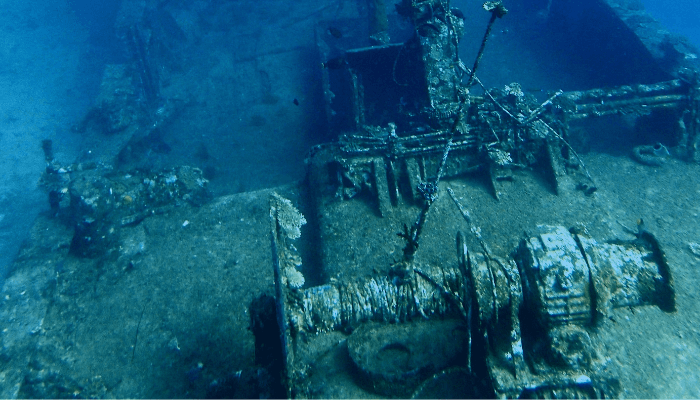
At present, because of the way the shipwreck is positioned in the water, the Rhone is regarded as the best diving destination in the Caribbean.
16. The Sultana
In one of the worst and least recognised maritime disasters in the history of the US, the explosion and sinking of steamboat Sultana on 27 April 1865 took 1,800 lives on the Mississippi River near Memphis.
The ship was used at the end of the American Civil War to transport the POWs from the Union army back home, and the vessel met with an accident after the explosion of its boilers.
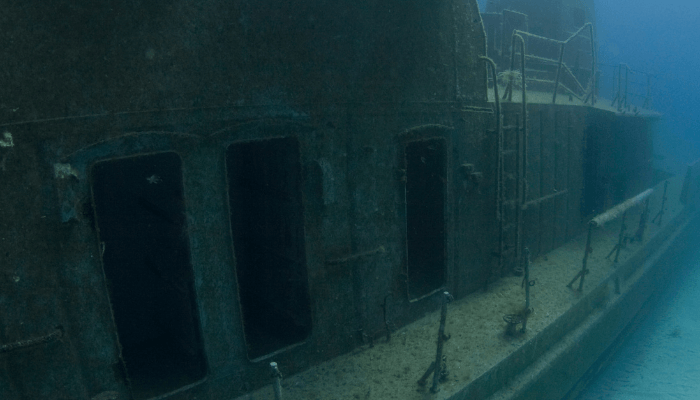
The ship’s wreck was found in 1982 in a soybean field on the Arkansas side, around 6 km from Memphis.
Featuring a few relics from the ship, a temporary Sultana Disaster Museum was opened in 2015 on the 150th anniversary of the tragedy.
17. The RMS Republic
The steam-powered ocean liner RMS Republic, built-in 1903, was lost at sea after colliding with the Lloyd Italiano liner SS Florida in 1909.
The vessel was en route from New York City to Gibraltar and Mediterranean ports when it met with an accident that killed six people.
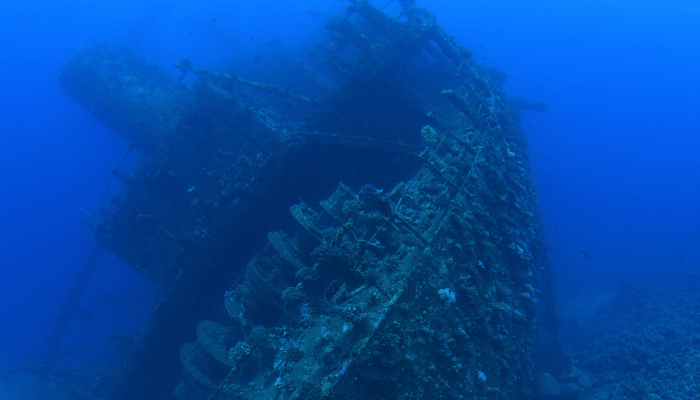
Several rumours suggest that the Republic was carrying valuables, including gold, when she went down off Nantucket, Massachusetts.
The Republic wreck, found in 1981 by Captain Martin Bayerle, lies upright around 80 km south of Nantucket Island, around 250 feet underwater.
18. RMS Lusitania
British ocean liner RMS Lusitania was the world’s largest passenger ship for a brief time when it launched in 1906.
The vessel was sunk on 7 May 1915 after being attacked by a German U-boat off the southern coast of Ireland, killing 1962 passengers and 1191 crew members.
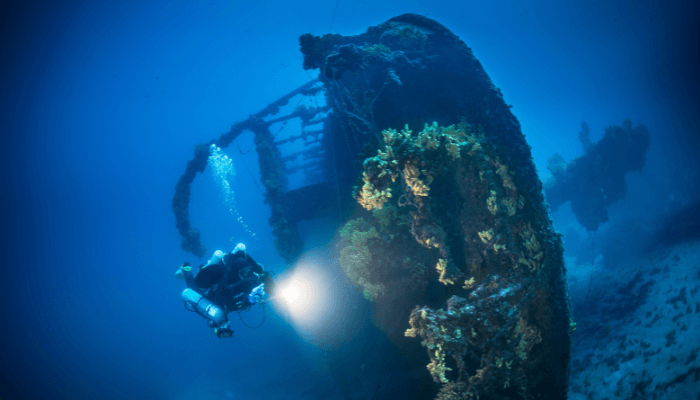
The disaster occurred on the 202 nd trans-Atlantic crossing of RMS Lusitania. After a few salvage efforts, several items were recovered.
Currently, the wreck lies 11 miles south of the lighthouse at Kinsale, Ireland, with around 300 feet of water.
19. USS Arizona
The USS Arizona was a US Navy Battleship. It was named after the 48th state and was the last vessel of the Pennsylvania class. She was commissioned in 1916 and participated in crucial missions and operations during the First World War.
The ship escorted President Woodrow Wilson to the Paris Peace Conference and was deployed to serve in the Greco-Turkish War in 1919. In 1921, she joined the Pacific Fleet. In the 1920s and 30s, USS Arizona participated in training exercises and was refurbished too.

It provided relief efforts in 1933 after an earthquake near Long Beach, California. In 1940, the home port of the Pacific Fleet shifted from California to Pearl Harbour, a move to check the Japanese influence.
On 7th December 1941, the Japanese forces launched an attack on Pearl Harbour. The USS Arizona was struck by several bombs dropped by aeroplanes. Hence, the ship sank, taking with it about 1177 naval officers and crew. Unlike other ships attacked the same day, Arizona was damaged badly and could not be repaired or brought back.
Its shipwreck is located at Pearl Harbour’s bottom, near the USS Arizona Memorial, built in memory of those who died during the attack.
20. USS Indianapolis
The USS Indianapolis was a heavy cruiser of the US Navy, belonging to the Portland Class. It was launched in 1931 and played a major role in the Pacific Theater of Operations during the Second World War. It was a part of many wars and campaigns, such as the Battle of the Philippine Sea.
On 30th July 1945, the ship was headed to Leyte from Guam when it was struck by 2 torpedoes fired by I-58, a Japanese submarine. They hit the ship near its bow, which caused it to sink in no time. She sank in just 12 minutes with most of its crew onboard.

Unfortunately, there was also a communication error, and its sinking could not be reported on time. The crew was left in the open water for 4 days without food and drinking water before a patrolling plane spotted them and rescued the survivors. However, till then, many of the crew had perished as a result of dehydration, shark attacks, exposure and saltwater poisoning.
The ship was carrying 1196 crew, of which only 316 survived. The sinking of the USS Indianapolis is one of the worst maritime disasters in U.S. Naval history.
In 2017, a search team found the ship’s wreckage in the Philippine Sea at a depth of around 18,000 ft and in 2018, the crew was awarded a Congressional Gold Medal.
21. HMS Hood
HMS Hood was the Royal Navy’s Battlecruiser constructed during the First World War. Although new vessels were being built at that time, Hood remained the biggest warship in the world for two decades after it was commissioned in 1920. Her prestige and honour were evident through her nickname ‘The Mighty Hood’.
The ship had to patrol the waters and also functioned as an escort ship in the North Atlantic. In May 1941, Hood and another ship called Prince of Whales were told to intercept the German warship Bismarck and Prince Eugen, which were headed to the Atlantic to attack convoys.
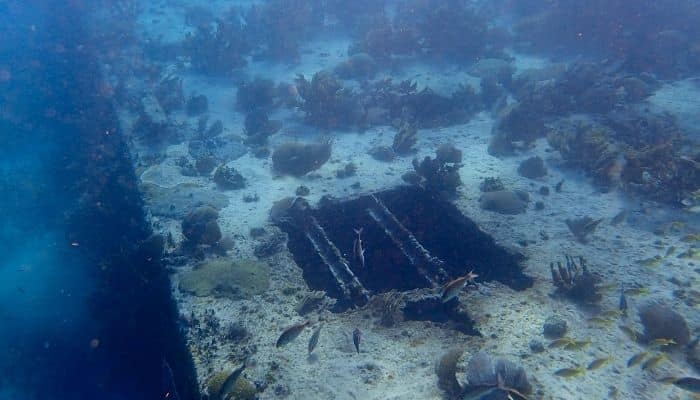
On 24th May 1941, during the Battle of Denmark Strait, the ship was hit by many German shells, which led to many explosions and its sinking with the loss of all but 3 of her 1418 crew members. Since the ship was considered invincible and was a symbol of power for the navy and British people, its sinking affected British morale.
22. SS Central America
SS Central America, also known as the Ship of Gold, was an 85 metres long sidewheel steamer. She operated between Central America and the eastern coast of the U.S. in the 1850s.
The steamship sank in 1857 off the South Carolina coast due to a hurricane. 425 of her 578 passengers and crew went down with the ill-fated ship, which was also carrying 30,000 pounds of gold and other precious items. The ship was on its voyage from Panama to New York.
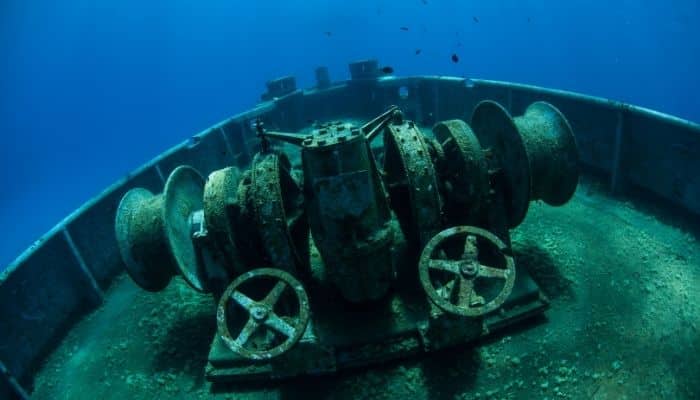
Its sinking was a crucial event in American history since it contributed to the panic of 1857, a financial crisis which went on for many years.
In the 1980s, a team of explorers found the wreck of SS Central America, and they recovered some amount of gold and other precious items from it. The discovery of this vessel and its treasures was said to be one of the greatest archaeological finds of the century.
23. Bismarck
Named after Chancellor Otto von Bismarck, the battleship Bismarck was constructed for Nazi Germany’s Kriegsmarine. She was laid down in 1936, launched in 1939 and work on it was completed in 1940, after which she joined the German Fleet. Bismarck and Tirpitz were the largest battleships ever constructed by Germany, and they were two of the biggest ships built by a European power at that time.
However, it sank on 27th May 1941 in the North Atlantic, a significant event in naval history. In May 1941, Bismarck engaged in a battle with the British Royal Navy’s HMS Hood and HMS Prince of Wales. Eventually, Bismarck sank the Hood with its firepower but sustained damages and retreated to France for repairs.

However, the Royal Navy was now determined to sink Bismarck and pursued the battleship by launching a massive search operation. After a few days, Bismarck was located, and she was attacked by 15 torpedo bombers from the aircraft carrier HMS Ark Royal. Hence, the ship was hit, and its steering gear became inoperable.
The next morning, two British warships and two heavy cruisers attacked Bismarck. The ship ultimately sank, taking most of its crew with it.
24. HMAS Sydney
HMAS Sydney was a light cruiser of the Royal Australian Navy during the times of the Second World War. On 19th November 1941, she engaged in a battle with the German cruiser Kormoran off the western coast of Australia.
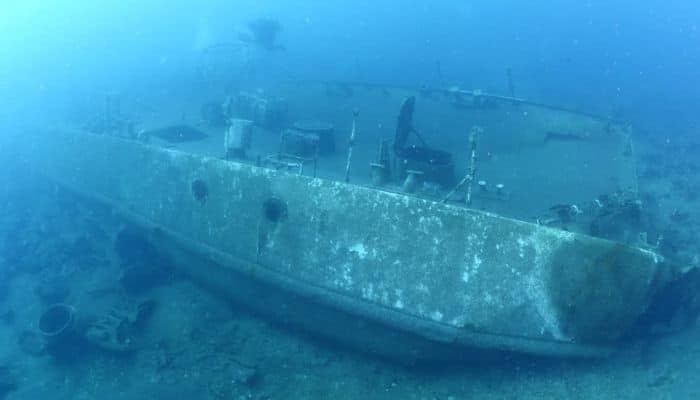
The German auxiliary cruiser was disguised as a Dutch freight ship and was carrying out raiding operations in the Indian Ocean. In the skirmish, the Koromoran was damaged severely, but it managed to get a lucky hit on the Australian cruiser, which led to a catastrophic explosion on the HMAS Sydney. It not only destroyed the ship, but all of its 645 crew members were killed as the ship sank.
There is a debate among experts as to what exactly happened since there were no survivors to give a first-hand account. However, it is believed that the Koromoran fired a torpedo that struck Sydney’s Magazine, which led to the explosion. The sinking of HMAS Sydney was a big tragedy for Australians.
25. USS Yorktown
USS Yorktown was an aircraft carrier of the US Navy that operated during the Second World War. It was named after the 1781 Battle of Yorktown and was commissioned in 1937. She was the lead ship of her class and took part in many important battles, such as the Battle of Midway and the Battle of the Philippine Sea.
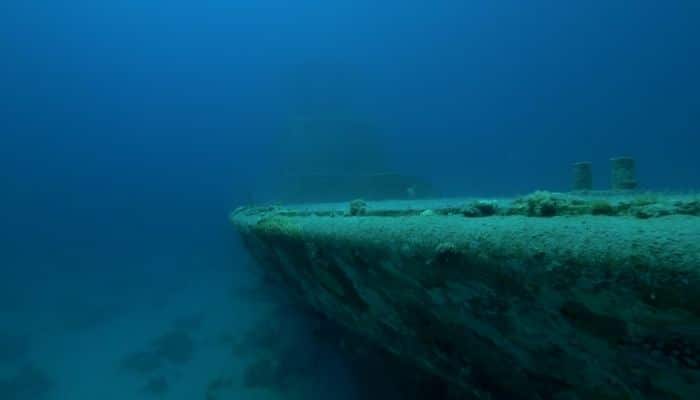
Yorktown sank two Japanese fleet carriers and took Japanese aerial attacks at Midway. On 4th June 1942, during the Battle of Midway, she was crippled by a Japanese aircraft. She lost power, and salvage efforts began. She was being towed by USS Vireo. However, on the afternoon of 6th June, I-168, a Japanese submarine fired many torpedoes, of which 2 struck Yroktown, and the third hit the USS Hammann, a destroyer of the US Navy, which was providing auxiliary power to Yorktown.
As the situation became dangerous, the repair crew evacuated Yorktown, which ultimately sank on 7th June 1942.
26. SS Eastland
The SS Eastland was a passenger vessel built in 1903 by Jenks Shipbuilding based in Port Huron, Michigan, for the Michigan Transport Company. The ship was used for tours, taking passengers from Chicago to several destinations across Lake Michigan.
On 24th July 1915, the SS Eastland was about to leave for Michigan City, Indiana, with over 2500 people and crew onboard when tragedy struck. The vessel listed heavily to one side while it was still docked at the wharf. In a couple of minutes, the ship capsized with many people trapped below deck.
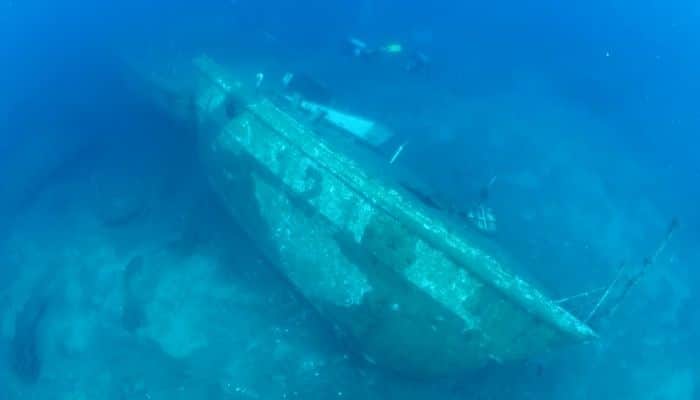
Rescue efforts could not save all and led to the death of 844 people, making it one of the deadliest and heart-wrenching maritime disasters in the history of the U.S. Most people on the ship were immigrants from the Czech Republic, Norway, Poland, Sweden, Denmark, Italy, Hungary and Austria.
The cause of the tragedy was said to be an amalgamation of many factors in the ship’s design and construction, and also overcrowding plus improper loading of cargo.
27. MV Wilhelm Gustloff
The MV Wilhelm Gustloff was initially a cruise ship. However, it was taken by the German Navy in 1939 to serve as a transport vessel for German military personnel and refugees. She also served as a hospital ship in 1939-1940.
Launched in 1937, the ship was intended to be named Adolf Hitler but was instead christened after Wilhelm Gustloff, leader of the Swiss branch of the Nazi party, who was assassinated in 1936. Hitler decided to name the ship after him when he met the former leader’s widow at the memorial service.
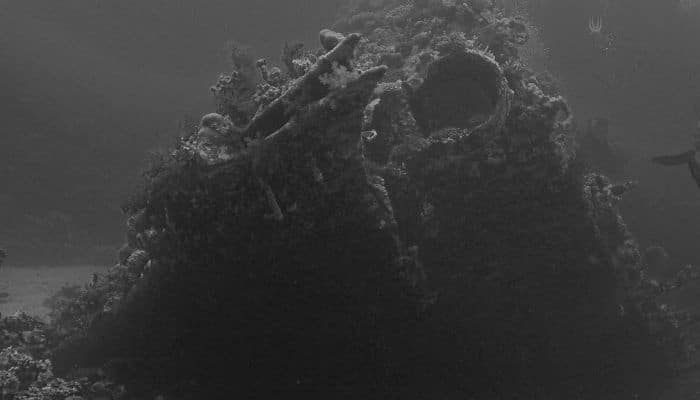
On 30th January 1945, the ship was torpedoed by Soviet Submarine S-13 in the Baltic Sea. This happened when the vessel was evacuating civilians and military personnel from East Prussia and the German-controlled Baltic States as the Red Army closed in.
She sank in less than 60 minutes, killing around 9400 people, mostly civilians.
28. General Slocum
General Slocum was a steamship named after Civil War General and New York Congressman Henry Warner Slocum. Owned by Knickerbocker Steamboat Company, the ship operated in the city of New York as an excursion steamer for another 13 years.
She was constructed in Brooklyn, New York, in 1891 and during her service, she was involved in many mishaps, including many groundings and collisions. It started four months after she was launched as she ran aground off Rockaway, and tugboats were used to set her free.

On 15th June 1904, the ship caught fire and sank in the East River, New York City. During the accident, she was carrying the members of St. Mark’s Evangelical Lutheran Church to a church picnic. Around 1021 out of the 1342 people were killed in the accident.
The fire was caused by a cigarette or a possible spark from one of its boilers which ignited the highly flammable material on the ship. It was not equipped with enough lifeboats, and the crew was not properly trained to manage such situations.
29. HMS Birkenhead
HMS Birkenhead, or HM Troopship Birkenhead of the Royal Navy, was one of the 1st ships to have an iron hull. She was made to be a steam frigate but later transformed into a troopship before it was commissioned.
She was launched in 1845 and sank off the South African coast on 26th February 1852, which led to the deaths of more than 400 people, including women and children.
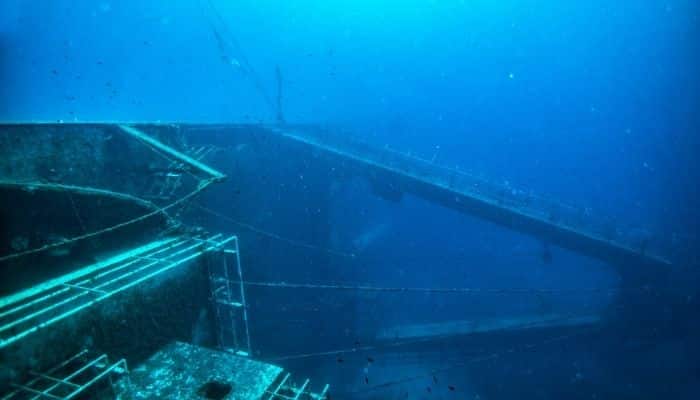
When she sank, the Birkenhead was on a mission. She was carrying troops to South Africa for the Frontier Wars and also had a few civilians. However, she hit an uncharted rock and began to take in water.
There were not enough lifeboats for everyone, and so the soldiers stood on the deck to allow the women and children to get on the few lifeboats available onboard. This act of chivalry has come to be known as the Birkenhead Drill.
However, in spite of this bravery by the soldiers and members of the crew, more than 400 people died when the ship sank.
30. El Cazador
The El Cazador was a Spanish brig that sailed in the late 18th century, ultimately sinking in the Gulf of Mexico in 1784. In the 1770s, the economy of Spanish Louisiana was suffering due to the usage of paper money not backed by gold or silver. Hence Carlos III, the King of Spain, decided to replace the paper money with Spanish silver coins.
In 1784, the ship left the port of Veracruz in Mexico to deliver a huge shipment of silver coins to New Orleans. The ship’s captain was Gabriel de Campos y Pineda. However, Cazador never reached its destination. It is argued that the ship was caught in a storm and sank off the Louisiana coast, taking precious cargo with it.
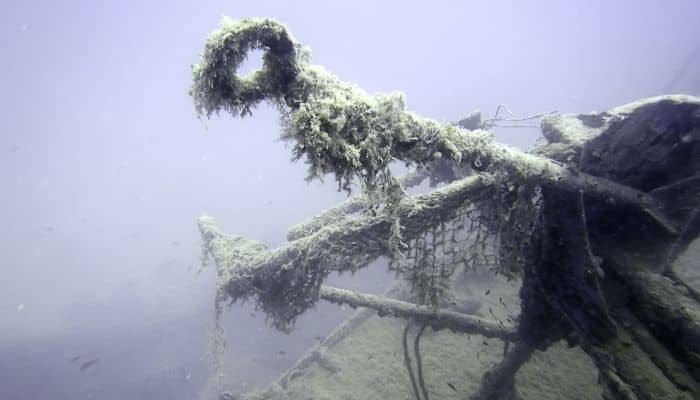
In 1993, the wreck of El Cazador was found by a shrimp boat captain Jerry Murphy who was fishing in the waters of the Gulf of Mexico. After the successful salvage effort, thousands of silver coins were found in the vessel’s hold. They were in a pretty great condition despite being in the water for over 200 years.
The discovery of El Cazador and its treasure is said to be one of the greatest maritime finds of the 20th century.
There are many famous shipwrecks in the world apart from the ones mentioned above. However, these shipwrecks have captivated people’s imaginations for many years.
From the unfortunate sinking of the Titanic to the mysterious disappearance of many ships, stories of ships have become a part of our collective history and culture. They have been depicted in art, paintings, movies, songs etc.
While shipwrecks took countless lives and led to immense suffering, they helped engineers to design more efficient and safer ships.
The sinking of ships also led to the implementation of stricter regulations and enforcement of new safety rules for ships at sea, which revolutionised maritime travel as well.
Today, these shipwrecks inspire marine enthusiasts to uncover the mysteries behind them and remind us of the ruthlessness and dangers of the sea and the strength of the human spirit.
Frequently Asked Questions About Shipwrecks
1. What is the most famous shipwreck?
The RMS Titanic is the most tragic shipwreck in the world. It has become popular due to the 1997 movies directed by James Cameron.
2. What Great Lake has had the most shipwrecks?
All great lakes have hundreds of shipwrecks, but most are found in Lake Erie.
3. What is the most popular unfound shipwreck in the world?
Flor de la Mar is the most famous shipwreck, filled with diamonds, gold and other riches.
4. What is the deepest shipwreck ever found?
The U.S.S Samuel. B Roberts was found in the Philippine Sea at 22,916 feet. It is the deepest shipwreck ever found.
5. Can you claim a shipwreck?
Yes, a country can claim ownership rights of a vessel if it owns the ship. Even if the vessel was sunk for hundreds of years, ownership rights could be claimed.
You may also like to read:
- 11 Books On Shipwreck And Maritime Archaeology You Might Be Interested In
- 6 Latest Shipwrecks Found Around the World
- 10 Great Lakes Shipwrecks
Disclaimer: The authors’ views expressed in this article do not necessarily reflect the views of Marine Insight. Data and charts, if used, in the article have been sourced from available information and have not been authenticated by any statutory authority. The author and Marine Insight do not claim it to be accurate nor accept any responsibility for the same. The views constitute only the opinions and do not constitute any guidelines or recommendations on any course of action to be followed by the reader.
The article or images cannot be reproduced, copied, shared, or used in any form without the permission of the author and Marine Insight.
Do you have info to share with us ? Suggest a correction

Subscribe To Our Newsletters
By subscribing, you agree to our Privacy Policy and may receive occasional deal communications; you can unsubscribe anytime.
Web Stories

About Author
Zahra is an alumna of Miranda House, University of Delhi. She is an avid writer, possessing immaculate research and editing skills. Author of several academic papers, she has also worked as a freelance writer, producing many technical, creative and marketing pieces. A true aesthete at heart, she loves books a little more than anything else.
21 Comments
I love ships all my life
I have loved ships my hole life
National Maritime Museum, in England, reminds the memories of the most prestigious voyage of the Titanic. All the shipwreck are wonderful and amazing.
The Edmund Fitzgerald should be on that list, as its even more known & legendary than some of the ships listed there already.
I <3 THE TITANIC BROOO
Ships are so cool
Im so jelly man.
ships are cool bro
Ship are so cool
Ship are so cool man lit
Ever since I found out about the rms titanic I got so interested that I had to look for more shipwrecks the lovibond shipwreck is also my favorite it said love and jeoulsy is the talk of this haunted ship
Ships looks better when at the bottom of the Ocean….
Ever since I found out about the titanic I watched all videos about ships mysteriously disappearing or sinking
Cloaked in my wolf skin shawl, nestled in my comfy recliner of rich Corinthian leather; surrounded by deep mahogany and nurtured by my oaked Cabernet I can help but think: my god, ships are cool.
USS Arizona , Edmund Fetzgerald and HMHS Brittanic are also famous shipwrecks
Thank you Mitch for the value addition
I love ships sinking. It’s satisfying.
No USS Indianapolis?
Completely inaccurate about HMS victory which was never lost and was retired to the naval dockyard in Portsmouth England It has never been decommissioned and is the oldest commission vessel in the Royal Navy
the ship im looking for on here ISNT THERE
Very satisfying comments about ships. But really Edmund Fitzgerald, HMHS Britannic and HMS curocia aren’t here? It seemed this site is incomplete. Author might not got his full payment to do this 😂.
Looks like the author was on a sinking ship when it came to researching those particular vessels!
Leave a Reply
Your email address will not be published. Required fields are marked *
Subscribe to Marine Insight Daily Newsletter
" * " indicates required fields
Marine Engineering
Marine Engine Air Compressor Marine Boiler Oily Water Separator Marine Electrical Ship Generator Ship Stabilizer
Nautical Science
Mooring Bridge Watchkeeping Ship Manoeuvring Nautical Charts Anchoring Nautical Equipment Shipboard Guidelines
Explore
Free Maritime eBooks Premium Maritime eBooks Marine Safety Financial Planning Marine Careers Maritime Law Ship Dry Dock
Shipping News Maritime Reports Videos Maritime Piracy Offshore Safety Of Life At Sea (SOLAS) MARPOL

- Southeast Asia
- North America
- Central & South America
- Middle-East
- Australia & South Pacific
- Luxury Awards
- Family Travel
- Solo Travel
- Beaches & Islands
- Zodiac Travels
- Wellness & Spas
- Accessories
- Points and Miles
- #TheGreenEdit
- T+L Tastemakers
- Sustainable Travel
- T+L Experiences
Hidden Treasures: Exploring Shipwrecked Marvels Across the Globe
Doesn’t exploring the mysteries surrounding shipwrecks sound intriguing check out some such locations at numerous beaches around the world..
By: Pyusha Chatterjee Published: Sep 27, 2023 10:00 AM UTC
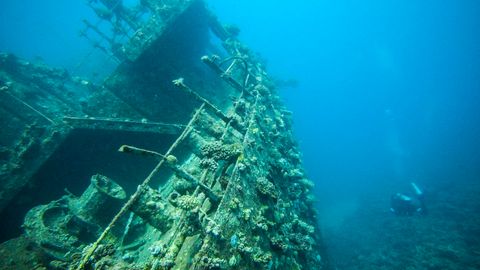
Isn’t it intriguing to explore the underwater realms and uncover the mysteries surrounding shipwrecks? While the idea of diving deep into the ocean to witness sunken vessels is undeniably fascinating, there’s an equally thrilling experience waiting for you at shipwreck locations along the seashores. What’s more, some of these sites offer exploration opportunities without the necessity of scuba diving or snorkelling, catering to those who prefer a different kind of adventure.
According to UNESCO’s analysis, there are reportedly over three million shipwreck sites worldwide, many of which remain undiscovered. So, let us be your guides as we take you on a journey to explore a selection of shipwreck locations, both above and beneath the water , to satisfy your ‘curio-sea-ty’ about the sea.
What are shipwrecks and why are they preserved?
Shipwrecks are accidents which lead to the destruction or sinking of ships, often due to collision with rocks or other catastrophic events.
Shipwrecks form an important aspect of marine archaeology and conservation. Some shipwrecks also affect the biodiversity underwater, serving as unique habitats for marine life. According to the UK-based Maritime Archeological Trust , “Maritime and Underwater Cultural Heritage (MUCH) is concerned with the relationship between people and the marine and coastal environment over time, using tools such as archaeology to investigate how the ocean was used through historical maritime artefacts.” To sum up, it’s safe to say that some shipwrecks are preserved to keep their history intact as well as to strike an ecological balance.
Prepare your bucket list with these unmissable shipwreck spots worldwide
Mv panagiotis , greece.
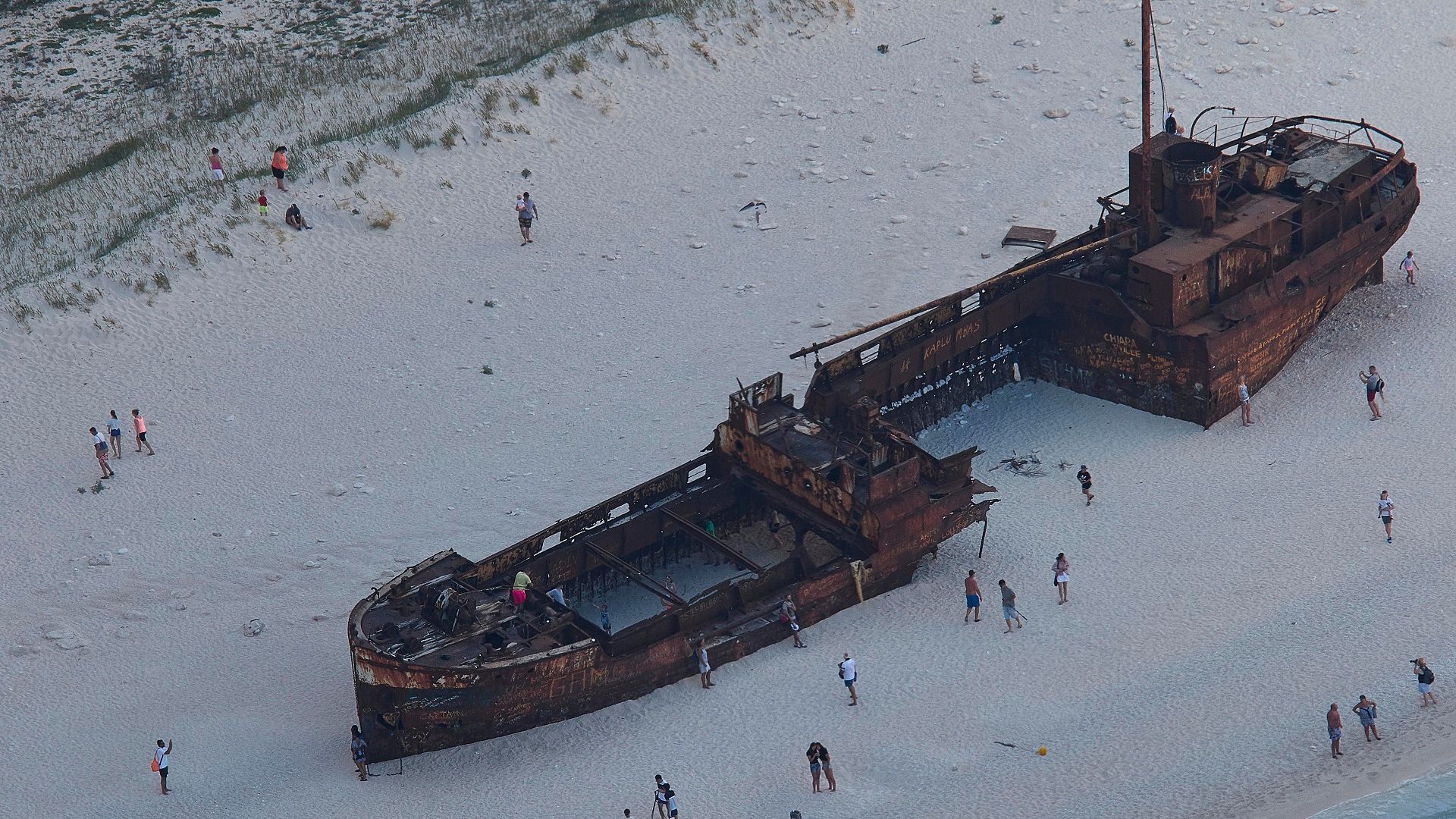
Originally named St Bedan , this Coaster General Cargo ship is known to have rescued soldiers from the port harbour of Dunkirk during World War II. It is said that the ship got damaged due to a storm in 1980 while carrying illegal cigarettes and liquor to Turkey. It got washed towards Zakynthos Island and was forsaken by the crew post that.
Shrouded in numerous tales surrounding its wreckage, the remains of this vessel, nestled on the beach amid azure waters, draw inquisitive explorers to Zakynthos Island. It’s also a famous spot for BASE jumping, an adventure sport that involves jumping from fixed objects.
How to reach: Reaching the MV Panagiotis shipwreck site in Navagio is possible only by boat. You can take one from Porto Vromi Maries, Agios Nikolaos, Zakynthos town or Skinari.
The Vasa , Sweden

Deemed to be one of the shortest maiden voyages in history, The Vasa ’s journey ended at just 1300 metres after it set sail in 1628. Believed to be the most powerful ship at the time, The Vasa , which has its own dedicated museum now, witnessed an untimely end and sank.
It was in 1961 that The Vasa was salvaged after spending 333 years underwater. Following numerous proposals and extensive reconstruction efforts, the Vasa Museum ( Vasa Museet ) was officially unveiled in Stockholm in 1990, with the vessel being its star attraction. According to its official website , about 98 percent of the structure remains intact, making it appear far from a wrecked ship today.
How to reach: You can take a cab from Stockholm Arlanda Airport, which is approximately 44 km away from the museum . You can also take tram no 7 from the city centre and get down at Nordiska museet/Vasamuseet stop.
SS Maheno , Australia
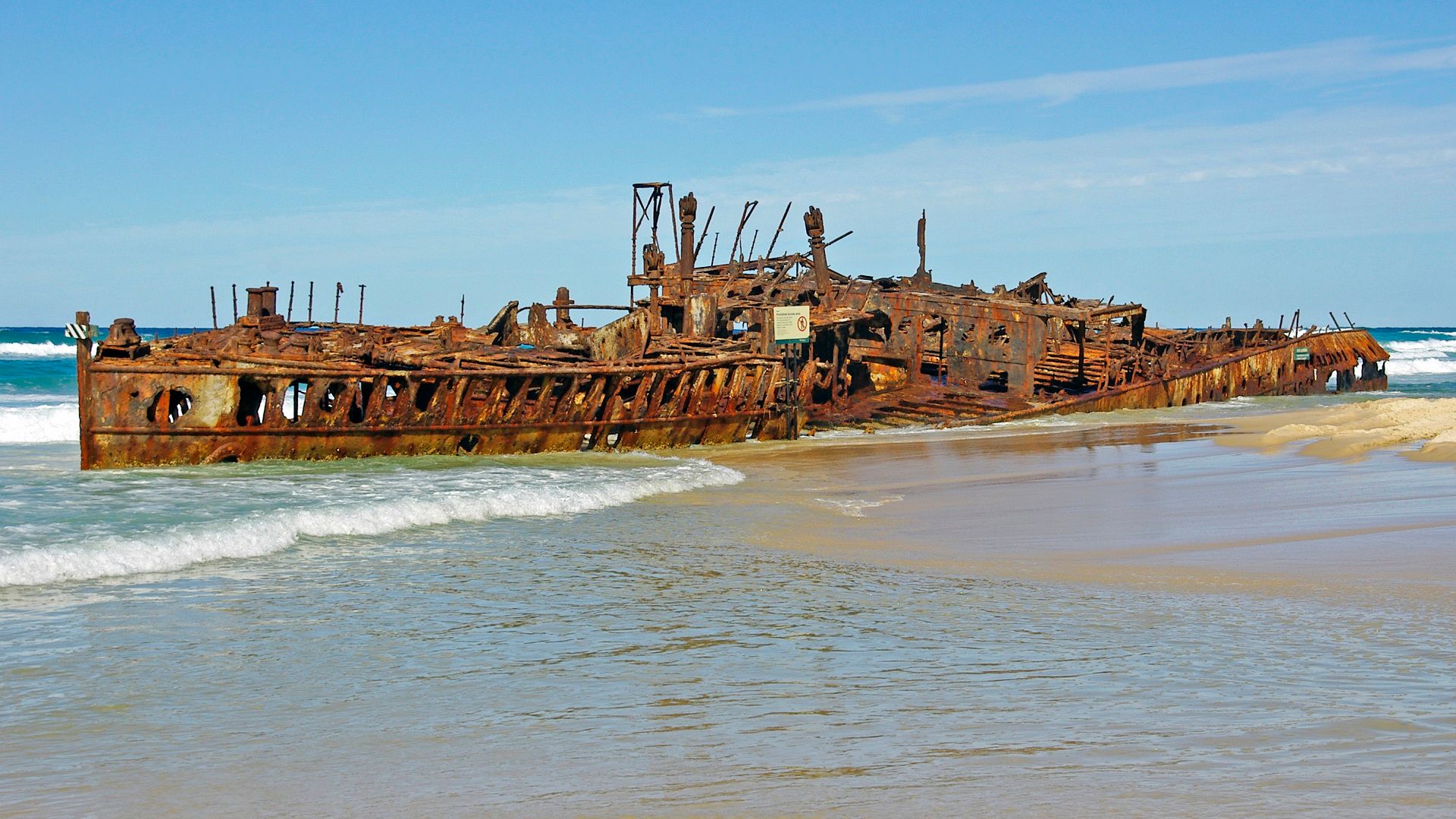
The SS Maheno , once known as a technological marvel and a paragon of fine engineering, met its tragic fate in 1935. This one-of-its-kind ship was then destroyed in a cyclone while on its ill-fated journey from Australia to Japan.
This rusted structure at Fraser Island, which was a proud hospital ship during World War I, was constructed in 1905. It also served as a luxury cruise liner prior to the war.
Australia’s Fraser Island may be a popular tourist spot, but it is also known to be a shore that has witnessed many shipwrecks, including SS Maheno, which could never reach Japan .
How to reach: The Hervey Bay Airport (HVB) is located approximately 64 km from Fraser Island. You can easily spot the shipwreck site from the main road along the 75-mile-long beach (about 120 km), which extends towards the island’s east.
MV Captayannis , Scotland
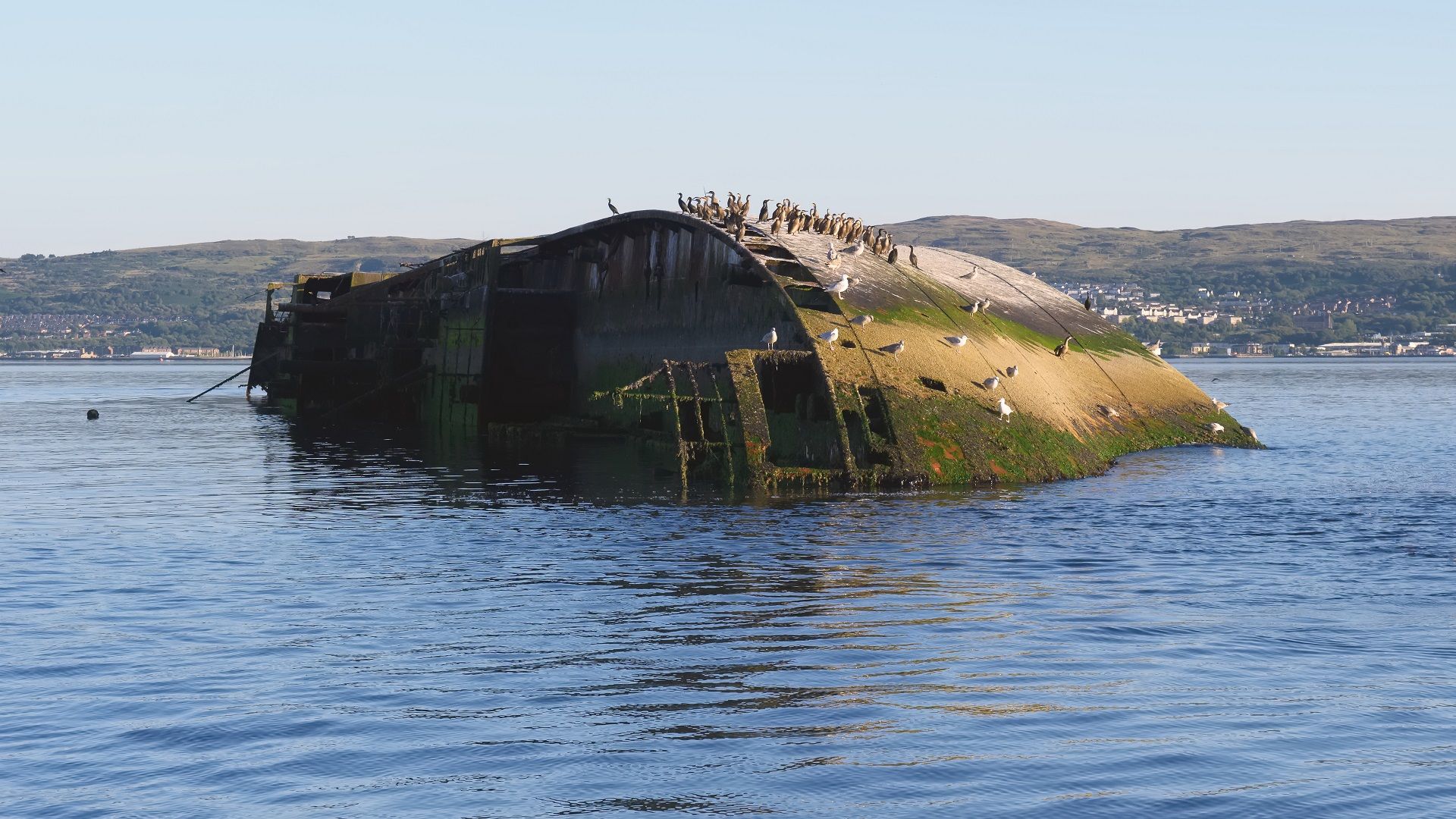
A shipwreck site that often attracts explorers, especially kayakers, MV Captayannis is a testament to the unfortunate cyclone that destroyed this vessel in 1974. It became the target of this natural calamity when it was stationed in Scotland for cargo unloading. A home for the fish and seabirds now, MV Captayannis is positioned on River Clyde in a way that anyone can reach it.
How to reach: The Glasgow Airport is approximately 61 km away from the site of MV Captayannis in Helensburgh. As you near Craigendoran and Greenock West, you can easily spot the shipwreck on River Clyde.
The Giannis D , Egypt

This one is for scuba diving enthusiasts who don’t mind diving into the deep Red Sea to witness this exquisite shipwreck site. Originally named Shoyo Maru in 1969 in Japan, and later renamed as Markus , the Giannis D embarked on its last journey from Rijeka, Yugoslavia, in 1983.
Now resting at the bottom of the Red Sea in three different sections of dilapidated structures in Abu Nuhas, approximately 10 metres from the surface, you may spot a school of fish emerging from its engine room as you explore its interiors.
It is believed that the ship sank due to a loss of focus and control by its captain, but fortunately, the crew was rescued in a timely manner.
How to reach: The best way to reach Abu Nuhas is by Red Sea liveaboard, which leaves from either Sharm El-Sheikh or Hurghada. The latter also has an international airport, the Hurghada International Airport.
Dimitrios, Greece

Originally constructed as Klintholm in Denmark in 1950, this ship was later renamed Dimitrios . In 1980, it was moored in Gythio, Greece, but remained abandoned for over a year until 1981, when it was deemed dangerous. Due to turbulent weather, it broke free and drifted for over a month around the Laconian Gulf, until it came to rest at its current location.
According to rumours, it is believed that the ship was involved in the illegal smuggling of tobacco between Italy and Turkey, and it was set on fire to conceal any evidence.
How to reach: The Kalamata Airport is approximately 55 km away from Sparta in Laconia. You can easily reach the spot from there via Provincial Road Skalas-Githio.
Eduard Bohlen, Namibia
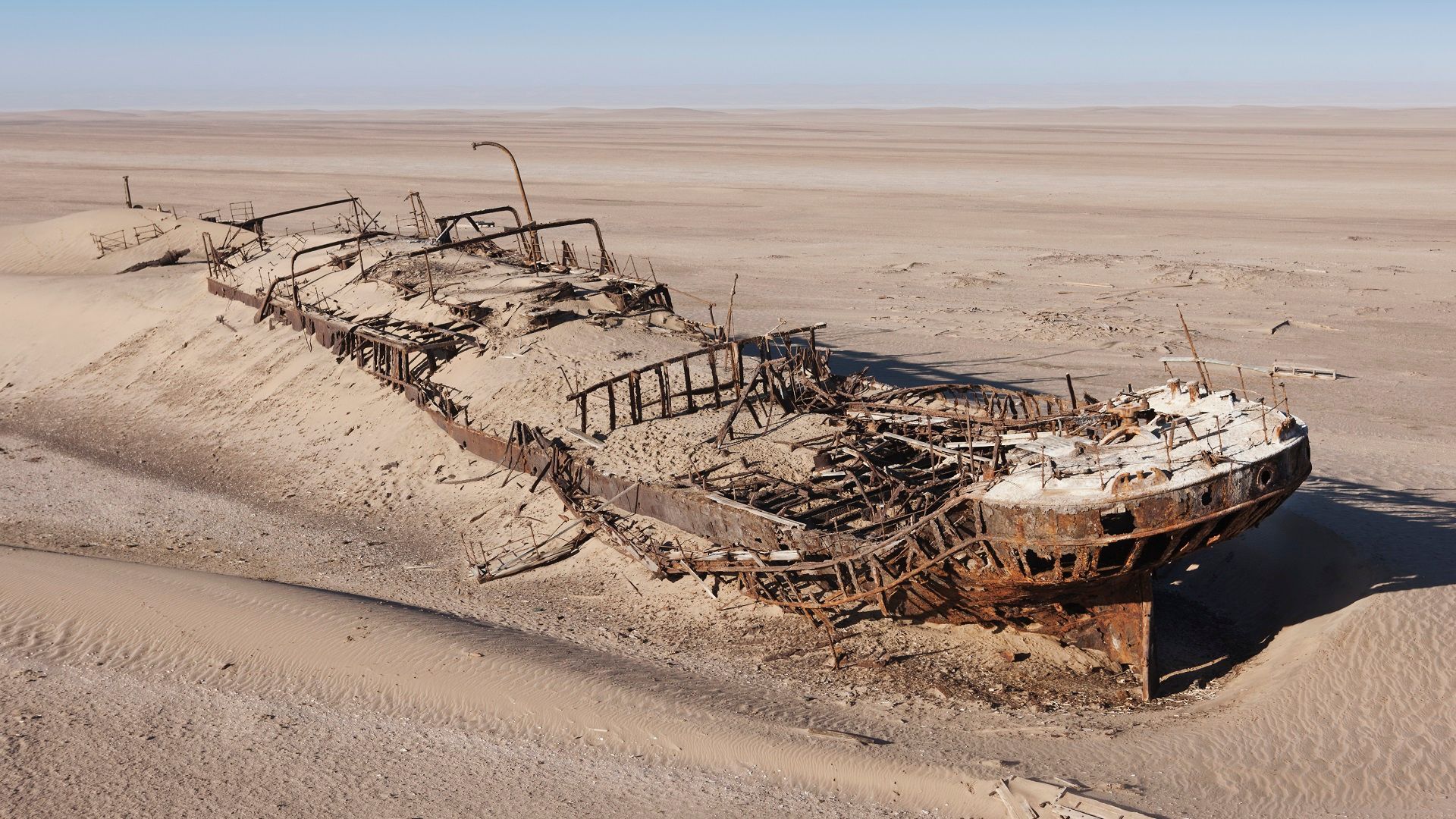
Looking nothing more than the skeletal remains of a once majestic ship, the Eduard Bohlen shipwreck lies along Namibia’s Skeleton Coast. This cargo ship met its fate while on a journey from Swakopmund to Table Bay in 1909, when it ran aground in thick fog.
Oddly enough, this shipwreck is around 1,000 feet away from the water, in the middle of a desert , which adds to its allure and beckons lovers of the offbeat. With Namibia’s Skeleton Coast named as the graveyard of wrecked ships, this one in particular is a favourite of photographers.
How to reach: Hosea Kutako International Airport is about 40 km from Windhoek, which is about 485 km from Skeleton Coast. This spot is difficult to access, and you need a proper licence and a vehicle with a guide. Some people directly fly to this location via charter flights.
Peter Iredale, Oregon

Popular among tourists visiting the coast of Oregon, this shipwreck site looks quite eerie as the sun sets. According to the Oregon History Project , “ The Peter Iredale was a four-masted steel bark built in Maryport, England, in 1890 and owned by British shipping firm Iredale & Porter.”
While on its journey from Salina Cruz, Mexico to the UK to pick up a cargo of wheat, it “ran aground at Clatsop Beach, hitting so hard that three of her masts snapped from the impact” even after surviving the heavy fog before.
The Oregon History Project quotes the ship’s captain H Lawrence as saying, “A heavy southeast wind blew and a strong current prevailed. Before the vessel could be veered around, she was in the breakers and all efforts to keep her off were unavailing.”
How to reach: The shipwreck site is located in Fort Stevens State Park, Oregon, which is an approximately 2-hour drive (92 km) from Portland.
The Nanhai No. 1 , China

Believed to have been built between 1127 and 1279 AD during the reign of the Song Dynasty in China, The Nanhai No. 1 was discovered in 1987 and preserved thereafter at the Guangdong Maritime Silk Road Museum. It was kept in a water tank filled with seawater and underwent rigorous excavation over the years. To date, over 200,000 culturally significant artefacts, including coins and vessels, have been recovered from the shipwreck.
Archaeologists raised the vessel in 2007 and moved it to Yangjiang. The area dedicated to the massive structure, which bears witness to its over 800-year-old history, was named ‘Crystal Palace’.
According to Global Times , underwater archaeologist Wang Zhixin explained, “The shipwreck was salvaged through an original approach too. A tailored metal caisson was built around it so it could be salvaged holistically along with the surrounding ocean bed. This approach used 16 years ago inspired future underwater projects at other places around the world.”
Other than getting glimpses of the vessel’s history through various artefacts on display, visitors can witness the ongoing excavation being carried out by archaeologists through glass windows around the Crystal Palace at the museum.
How to reach: The Yongjiang Heshan Airport is approximately 79 km from the Maritime Silk Road Museum. You can take a bus from Yongjiang Coach Station to Zhapo, followed by a cab to the museum, which is on the Silver Beach.
MS World Discoverer, Solomon Islands
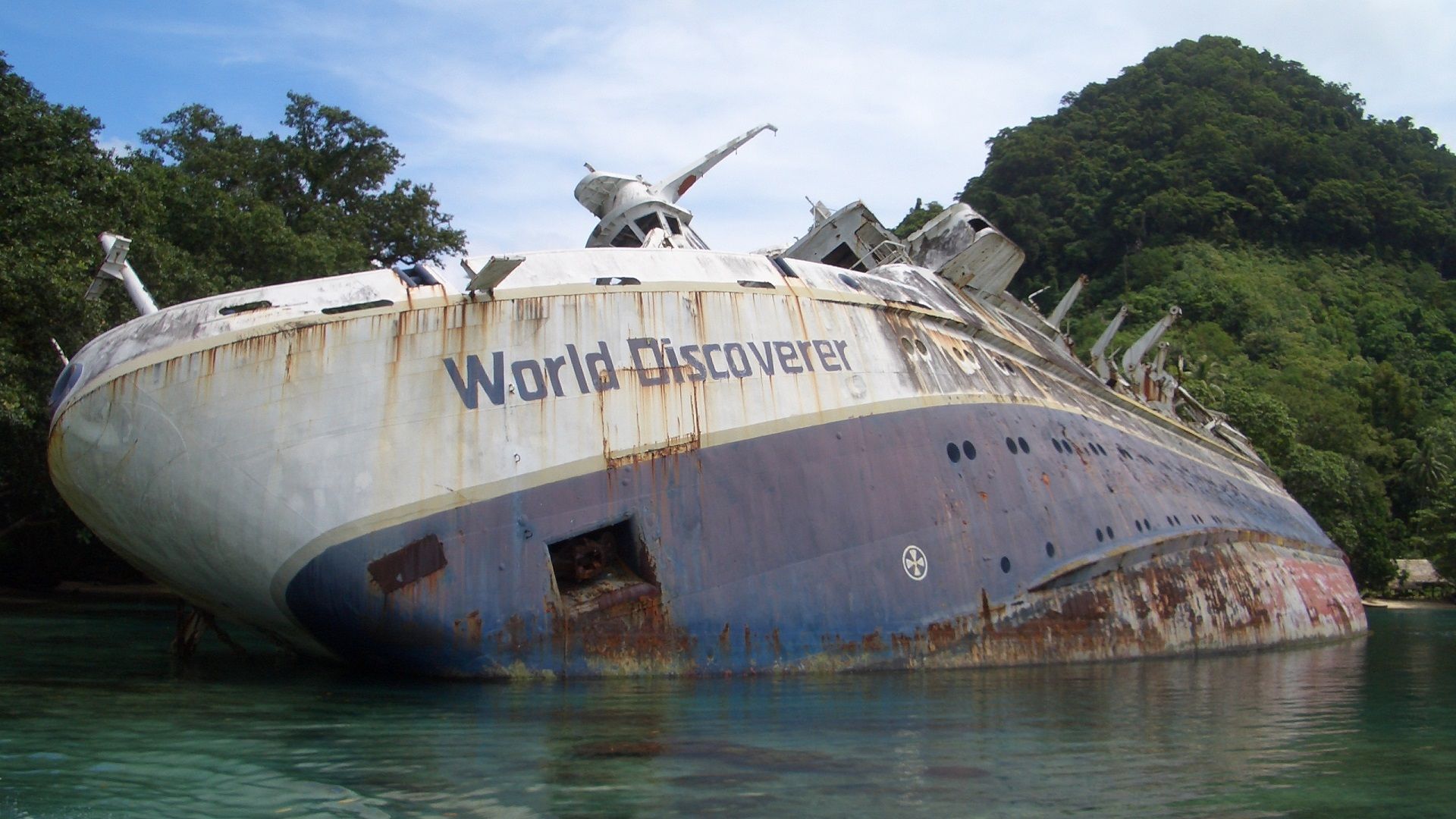
This half-sunken vessel has become one of Roderick Bay’s known tourist attractions since 2000. After having sailed thousands of nautical miles and serving several owners, MS World Discoverer , which was built in 1974, collided with an uncharted reef and got stranded along the coast of the Solomon Islands. Fortunately, everyone onboard was safely rescued.
According to various reports, some salvage companies initially showed interest in the ship but later found out that it had been completely plundered during the civil war of the Solomon Islands between 1998 and 2003.
How to reach: The wreck site is located at Sandfly Passage, Roderick Bay, located approximately 8 km away from the Honiara Airport.
(Hero and featured image credit: Jordi Ramisa/Getty Images)
Related: 10 Of The Most Picturesque Secret Beaches Best Reached By Yacht
FAQs Why do ships sink and become shipwrecks? Ships often sink due to various reasons, including catastrophes, natural disasters or collisions with rocks or land while being stuck in fog.
Are shipwrecks valuable? Yes, many shipwrecks are valuable. According to various reports, many jewellery pieces, liquor and other exquisite artefacts have been discovered from shipwrecks.
Are shipwrecks protected? Yes, some shipwrecks with historical importance are protected or preserved, such as The Vasa in Sweden.
Can shipwrecks be explored or visited? Yes, many shipwreck spots can be easily visited, while for some you need to put in extra effort such as scuba diving.
How to book a visit to shipwrecks? You can find out about the shipwrecks close to your destination and make your bookings accordingly based on the services offered by tour operators who arrange such visits.
- Shipwreck Adventure
- Shipwreck Spots

Pyusha Chatterjee
A journalist, Pyusha has previously worked with media organisations including The New Indian Express and Hindustan Times. A solo traveller by choice, she loves exploring life more than anything else, after food of course. When she isn't gardening, writing, reading, cooking or singing out loud, you can spot her watching films and series, debating with .. Read More friends or organising things unnecessarily. Read Less
Related Stories
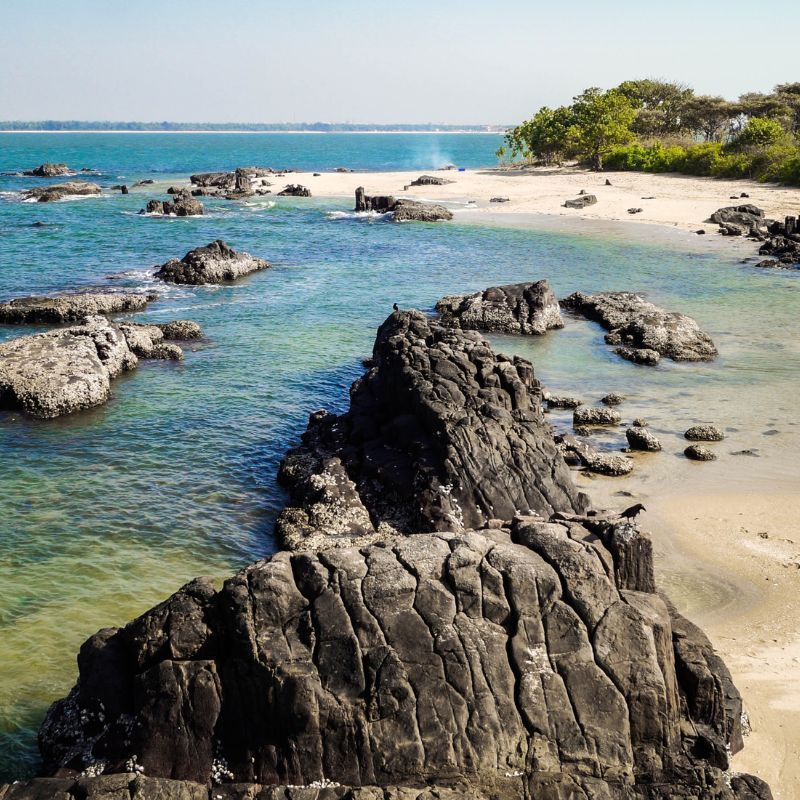
Beaches & Islands
São Jacinto And 5 Other Scenic Hidden Islands In India That Are Worth Exploring
By Ayushi Anand
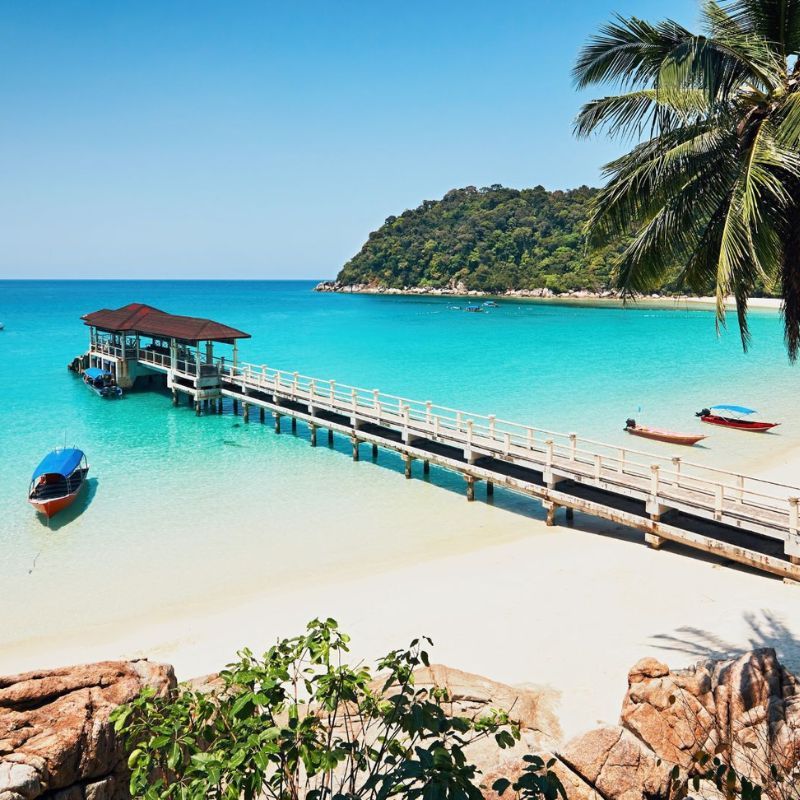
In Pictures: The Most Breathtaking Beaches And Islands In Malaysia
By Ruchit Rastogi
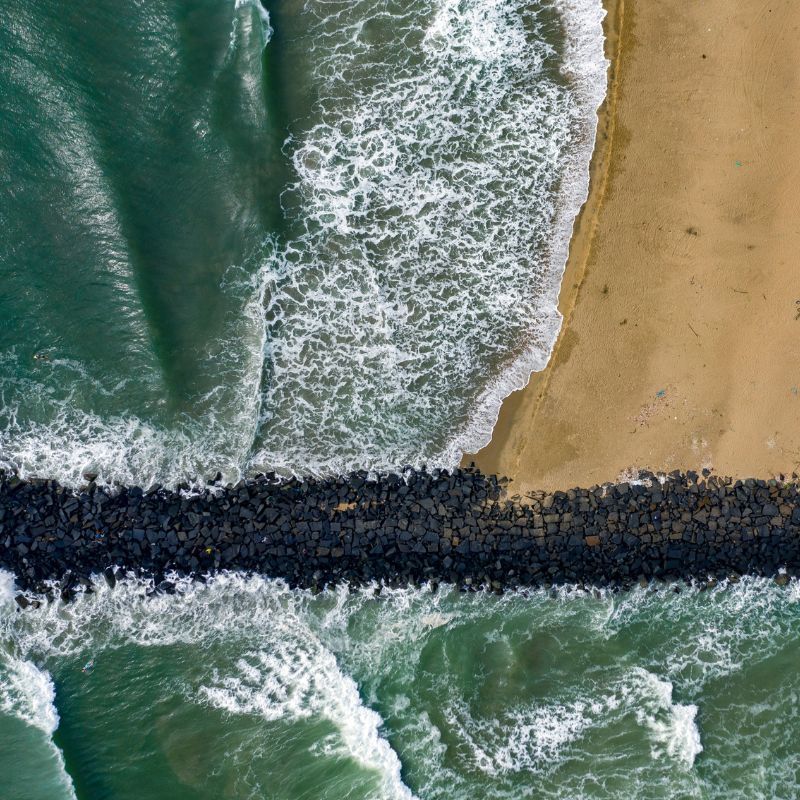
Spend An Idyllic Weekend At These Beaches Near Bangalore

12 Best Beaches In Kauai For Sunsets, Snorkelling, And Swimming
By Vanessa Wilkins

This Resort Is a Maldivian Fun Factory Where the Surprises Never Stop Coming
By Vincent Vichit-Vadakan

Sumba Island Is the Wild Indonesian Escape You’ve Been Dreaming Of
By Jenny Hewett

This Fresh-Faced Five-Star Is Another New Reason to Hit the Beach in Mui Ne
By Marissa Carruthers
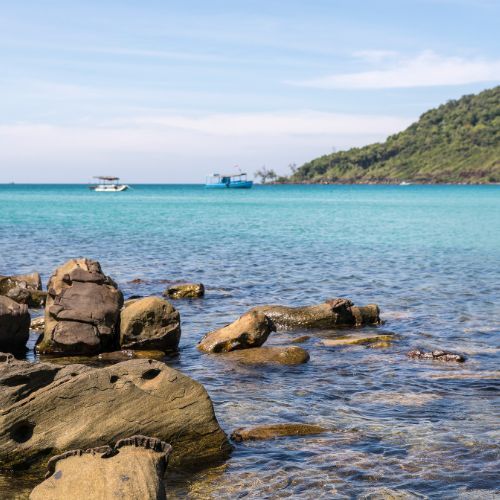
This Island in Cambodia Is the Roadless Reset You Need Right Now
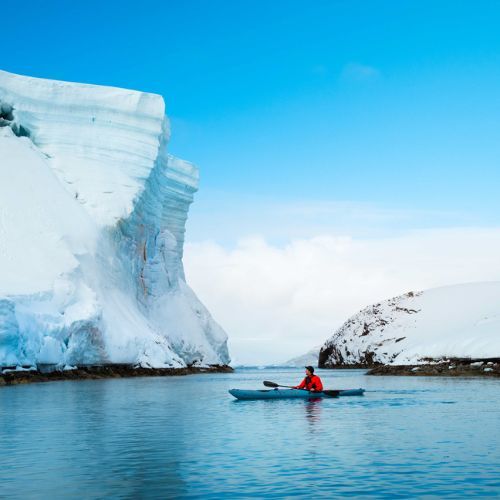
VIDEO: Antarctica, the Swimsuit Edition
Subscribe to our newsletter to get the latest on travel, stay & dining.
You’re all set
Thank you for your subscription.
- Share full article
Advertisement
Supported by
It’s a Golden Age for Shipwreck Discoveries. Why?
More lost shipwrecks are being found because of new technology, climate change and more vessels scanning the ocean floor for science or commerce.

By Michael Levenson
Some were fabled vessels that have fascinated people for generations, like Endurance , Ernest Shackleton’s ship that sank in the Antarctic in 1915. Some were common workhorses that faded into the depths, like the Ironton , a barge that was carrying 1,000 tons of grain when it sank in Lake Huron in 1894.
No matter their place in history, more shipwrecks are being found these days than ever before, according to those who work in the rarefied world of deep-sea exploration.
“More are being found, and I also think more people are paying attention,” said James P. Delgado, an underwater archaeologist based in Washington, D.C. He added: “We’re in a transitional phase where the true period of deep-sea and ocean exploration in general is truly beginning.”
So what’s behind the increase?
Experts point to a number of factors. Technology, they say, has made it easier and less expensive to scan the ocean floor, opening up the hunt to amateurs and professionals alike. More people are surveying the ocean for research and commercial ventures. Shipwreck hunters are also looking for wrecks for their historical value, rather than for sunken treasure. And climate change has intensified storms and beach erosion, exposing shipwrecks in shallow water.
Underwater robots and new imaging are helping.
Experts agreed that new technology has revolutionized deep-sea exploration.
Free-swimming robots, known as autonomous underwater vehicles, are much more commonplace than they were 20 years ago, and can scan large tracts of the ocean floor without having to be tethered to a research vessel, according to J. Carl Hartsfield, the director and senior program manager of the Oceanographic Systems Laboratory at the Woods Hole Oceanographic Institution in Massachusetts.
Remotely operated vehicles can travel 25 miles under the ice sheet in polar regions, he said. And satellite imagery can detect shipwrecks from plumes of sediment moving around them that are visible from space.
“The technology is more capable and more portable and built on scientists’ budgets,” Mr. Hartsfield said, adding: “You can sample larger and larger areas of the ocean per dollar.”
Jeremy Weirich, director of Ocean Exploration at the National Oceanic and Atmospheric Administration, said the expanded use of telepresence systems , which stream images of the ocean floor to anyone with an internet connection, has allowed more people to explore and discover shipwrecks in real time.
And the digitization of archives has made it easier to find and consult historical documents, said David L. Means, a marine scientist and shipwreck explorer.
Even so, it is still easier to organize a mission to find a famous wreck than an obscure one, Mr. Hartsfield said.
“You can get investors to find out what happened to Amelia Earhart , but not to find cargo freighters,” he said. “It’s all about the compelling story.”
Climate change is a factor.
Climate change is playing a role, experts said, by producing more frequent and powerful storms that have eroded shorelines and churned up sunken vessels.
In late January, for example, several months after Hurricane Fiona battered Canada, a 19th-century shipwreck washed ashore in the remote Cape Ray section of Newfoundland, causing a stir in the small community of about 250 people.
In 2020, a couple walking along a beach in St. Augustine, Fla., noticed wooden timbers and bolts sticking out of the sand. Archaeologists said the pieces were most likely remnants of the Caroline Eddy , a ship built during the Civil War that sank in 1880. They were probably exposed, experts said, because of coastal erosion caused by a tropical storm named Eta and by Hurricane Matthew in 2016 and Hurricane Irma in 2017.
Those kinds of coastal discoveries may become more commonplace, Dr. Delgado said. “As the ocean rises,” he said, “it’s digging things out that have been buried or hidden for more than a century.”
Treasure hunting isn’t what it used to be.
Private treasure hunters still search for shipwrecks, hoping to find sunken gold, coins or jewels. But their discoveries often become mired in legal battles, and rarely are their claims ever realized, said Deborah N. Carlson, the president of the Institute of Nautical Archaeology, a nonprofit research organization.
She pointed out that the underwater archaeologist Peter Throckmorton once called ocean treasure hunting “ the world’s worst investment ,” and found that it “only benefits promoters and lawyers.”
Private claims to a sunken ship can be contested by nations or insurers. Spain, for example, successfully defended its claim that it maintained ownership of a Spanish frigate that was sunk by the British in 1804 after an American treasure-hunting company found the shipwreck off Portugal in 2007 and took its trove of gold and silver coins to a Florida warehouse.
The UNESCO Convention on the Protection of the Underwater Cultural Heritage, adopted in 2001 , sought to protect shipwrecks from looters and said countries should preserve them and other undersea relics “for the benefit of humanity.”
Mr. Hartsfield said that if the goal is “to observe and not disturb” a shipwreck, the cost goes down because it doesn’t require anyone to lower a submersible on a winch to pluck items off the ocean floor. Scientists, he said, can just use a video camera to record the artifacts they find.
“Now, your gold coin is a 4K picture,” Mr. Hartsfield said, referring to a type of high-definition video. “If your sensors are better, you don’t have to necessarily recover an object to investigate it.”
More are joining in and exploring the ocean depths.
While treasure hunters still ply their trade, they have been joined by more commercial and research ventures that have expanded the realm of deep-sea exploration.
Mr. Weirich said that more shipwrecks have been found over the years in large part because of private companies surveying for oil and gas leases, cables and pipelines.
Phil Hartmeyer, a marine archaeologist at NOAA Ocean Exploration, said that more private research groups are also scanning the ocean floor and helping to move scientists around the world closer toward a goal of mapping the entire seabed by 2030 .
NOAA, for example, works with the Schmidt Ocean Institute , a nonprofit research group founded by Eric Schmidt, the former chief executive of Google, and his wife, Wendy Schmidt; the Ocean Exploration Trust , a nonprofit founded by Robert Ballard , who led the expedition that found the Titanic in 1985; and OceanX , an ocean exploration company founded by the billionaire investor Ray Dalio and his son, Mark.
Dr. Carlson said that the field of underwater archaeology has also “expanded significantly,” with more graduate programs producing archaeologists interested in excavating sunken ships for their historical value.
“There are a lot more people in this discipline than there were 50 years ago,” Dr. Carlson said, “and a lot more people are looking for shipwrecks and finding them.”
Michael Levenson joined The Times in December 2019. He was previously a reporter at The Boston Globe, where he covered local, state and national politics and news. More about Michael Levenson
S3:060 Job 15
- Podcast Episode
Add a plot in your language
User reviews
- March 22, 2024 (United Kingdom)
- See more company credits at IMDbPro
Technical specs
- Runtime 8 minutes
Related news
Contribute to this page.
- IMDb Answers: Help fill gaps in our data
- Learn more about contributing
More to explore

Recently viewed
Entertainment
Actor Xu Bin 'shocked' he didn't make Star Awards Top 10 Most Popular Artiste nominee list, says he will work harder
Advertisement.
The 35-year-old star found out he didn't make shortlist because his drama series didn't qualify for this year's Star Awards due to when it aired.
This audio is AI-generated.
Ainslyn Lim
You’ve probably heard by now that there are a total of 94 nominees vying to be one of the Top 10 Most Popular Male and Top 10 Most Popular Female Artistes at this year’s Star Awards . Yet, a few familiar faces were left out of the running before the race even started due to the competition’s eligibility criteria.
NoonTalk Media actor, Xu Bin, 35, is one of the unfortunate few.
The star was involved in only one local drama last year, crime mystery series, Kill Sera Sera , which aired this January.
For an artiste to qualify for the Star Awards, their work needs to have aired within the qualifying period of Jan 1 to Dec 31, 2023.
8days.sg hopped onto a phone call with Xu Bin on Mar 20, where he revealed that he only recently came to find out that Kill Sera Sera did not make the cut-off date.
When we pointed out that many were surprised about his omission from the popularity nominations, he admitted: “I was shocked myself, like 'Huh, there’s such a thing?'. (But) there’s nothing we can do about it, we can only follow (the rules).”
“To me, being an actor, it’s a more 'reactive' job. You’re always the one being chosen, like when a director chooses a specific actor for a role,” he said.
Xu Bin had been on a roll. He made the Top 10 honour roll at both the 2022 and 2023 Star Awards, and he now has five Top 10 Most Popular Male Artistes trophies.

When we asked if he was anticipating his sixth award this year, he said: “I think the award is something that anyone in the industry would hope to receive, myself included. I got my fifth award last year, and it wasn’t easy to get to the halfway mark. It’s been a long and slow journey.”
He laughed before adding: “I don’t know when I will get to the end. This year, I was immediately disqualified.”
He continued: “I definitely do feel quite disappointed. I feel like there are a lot of people who had expectations of me, including my friends, fans and clients. I feel like I owe them an explanation and I know these people who support me are disappointed (too).”
He said he told his supporters that "it's alright”, and they would simply have to try again next year.
He then chuckled before adding: “I have to work harder, and maybe not just appear in one or two dramas that land outside the time frame.”
While he was clearly sad about how things turned out, Xu Bin remained cheery during our conversation. He said apart from working on Kill Sera Sera last year, he was kept busy attending NoonTalk events and activities, for example going live on the agency’s TikTok channel every Thursday evening.
He also took a short break, spending half a month in China visiting his parents with his wife and their kids, five-year-old Ethan and three-year-old Elyse.
However, he’s now back to the grind.
“I’ve recently started filming again, and I play a big role (in this upcoming drama). I’m in 90 per cent of the scenes, together with (Zong) Zijie. I'm busy the entire day – I only got home after 3am last night."
He revealed that the working title of the 15-episode drama is Zai Jian Ming Tian (or Goodbye Tomorrow, in English), and he’ll be busy working on it until June or July.
When we asked about the drama’s slated premiere date, Xu Bin let out a huge chuckle.
“This is very important now right?” he said. “I think it will air sometime during the end of the year, but if that’s the case, it’ll be like Kill Sera Sera and air into the next year. So for this year, I might just have Kill Sera Sera.”
As for who he thinks should have made the nominee list , Xu Bin said: “I feel as long as people can name them off the top of their heads, they should be nominated. Everyone knows them, and the audience (is) familiar with seeing their faces on screen.”
For now, Xu Bin will work hard to get his 10th Most Popular trophy and ascend to the ranks of All-Time Favourite Artistes.
With a sigh, he said: “As long I’m still active in the industry, it’s something I want to accomplish. After all, it really wasn’t easy getting to the halfway mark.”
In the meantime, you can show Xu Bin some support by catching in Kill Sera Sera on mewatch .
You can now cast your vote for both performance and popularity awards here .
Catch the Backstage LIVE event of Star Awards 2024 from 3.30pm - 10.30pm on mewatch or Mediacorp Entertainment YouTube Channel on Apr 21 (Sunday).
The Walk Of Fame will be from 5pm - 6.30pm, on mewatch , Ch 8, Ch U, and Mediacorp Entertainment YouTube Channel on the same day.
It will be followed by the Star Awards 2024 Live Show from 7pm - 10pm on mewatch , Ch 8, Ch U, and Mediacorp Entertainment YouTube Channel .
The repeat telecast for the Walk of Fame and Award Ceremony will air on Ch 8 from 2pm - 6.30pm on Apr 28 (Sunday).
This story was originally published in 8Days.
For more 8Days stories, visit https://www.8days.sg/
Related Topics
Recommended, recent searches, trending topics, this browser is no longer supported.
We know it's a hassle to switch browsers but we want your experience with CNA to be fast, secure and the best it can possibly be.
To continue, upgrade to a supported browser or, for the finest experience, download the mobile app.
Upgraded but still having issues? Contact us

IMAGES
VIDEO
COMMENTS
A journey to visit the world's most famous shipwreck sounds like something from science fiction. But for the first time ever, a group of curious adventurers ...
Dozens of men, women, and children began jumping from the ship. Stockholm's waters became peppered with helpless, flailing bodies. Sailors clambered up the ship's sinking masts. Within minutes ...
His journey is also chronicled in a new book, "Return to Titanic: A New Look at the World's Most Famous Lost Ship." Ballard was invited on the "Today" show to talk about the book and his ...
For the most part, the only people who've ever seen the Titanic since the night of April 15, 1912, when it sunk beneath the North Atlantic, have been scientists. Until now. Stockton Rush is CEO of ...
Humans 09 March 2022. By Griffin Shea, AFP. (Falklands Maritime Heritage Trust) Explorers have found one of the most famous shipwrecks in history, Ernest Shackleton's Endurance, deep in the icy sea off Antarctica more than a century after it sank, they announced Wednesday. Endurance was discovered at a depth of 3,008 meters (9,869 feet) in the ...
Here are the most famous shipwrecks to have ever been found. 1. Endurance (1915) For over a century, the explorer Sir Ernest Shackleton's ship Endurance was lost beneath the ice floes of the Weddell Sea in the Antarctic. The Imperial Trans-Antarctic Expedition had set out in 1914 to cross the Antarctic continent via the South Pole.
Prepare to embark on an underwater journey as we explore the deadliest and most famous shipwrecks and their historical treasures. ... It was known for holding the Blue Riband for the fastest Atlantic crossing in 1908 and was briefly the world's largest passenger ship. It was torpedoed and sank by a German U-boat on May 7, 1915, en route from ...
Dozens of men, women, and children began jumping from the ship. Stockholm's waters became peppered with helpless, flailing bodies. Sailors clambered up the ship's sinking masts. Within minutes, the Vasa was underwater and 30 people were dead. The world's meanest warship had been felled by a gentle gust of wind.
Located on the north-west shore of the Ionian island of Zakynthos (also known as Zante), Navagio Beach, previously known as Agios Giorgos, became an impromptu ship graveyard when the MV Panayiotis washed up on its shores in October 1980. Many theories and speculations arose and while the date is often wrong (some sources state that the event ...
7. RMS Titanic, Atlantic Ocean. No list of notable shipwrecks would be complete without history's most famous example, the Titanic. The largest cruise ship ever built at the time, 1911, the Titanic set sail on its maiden voyage from Southampton, England, to New York, United States, on 10 April 1912, carrying over 2,200 people as passengers ...
The sinking of Titanic is today one of the most well-known maritime disasters in the world. This is thanks in part to James Cameron's Oscar-winning 1997 film of the same name, but also because the event was - and remains to this day - one of the deadliest peacetime sinkings in history. The tragedy claimed more than 1,500 lives, although ...
After consulting dozens of historical articles on shipwrecks and their discoveries from a variety of sources, 24/7 Tempo has compiled a list of 35 of the most famous shipwrecks ever found, from ancient Roman trading vessels to WWII battleships - and including the most famous shipwreck of all, the Titanic. (Here are 57 fascinating facts about ...
The oldest shipwrecks in history. 3. RMS Lusitania. RMS Lusitania was a British ocean liner launched in 1906, and made a total of 202 trans-Atlantic crossings before it was torpedoed and sunk by a German U-boat on 7 May 1915. Of the 1,962 passengers and crew aboard, 1,191 lost their lives.
Many people are familiar with the Titanic, as it is amongst the most famous shipwrecks around the world.. Deemed to be "unsinkable" and luxurious, the world's largest passenger ship, and indeed largest cruise ship, set sail for its maiden voyage to New York City, but hit an iceberg on April 14, 1912, while trying to cross the North Atlantic ocean.
The Titanic is undoubtedly the most famous shipwreck in history. The ship was built in Ireland and was considered to be "unsinkable.". It sank in the North Atlantic Ocean during its maiden voyage from Southampton to New York City on April 14th, 1912. 1,517 people lost their lives.
SS Waratah: The SS Waratah is known as "Australia's Titanic." A passenger cargo ship built to travel between Europe and Australia, it disappeared shortly after steaming off from the city of Durban ...
Though some of the most famous shipwrecks happened in modern times — like the sinking of the RMS Titanic or the explosion of the USS Maine — shipwrecks have a long, varied, and fascinating history. These are the true stories behind some of the most intriguing shipwrecks around the world, from the "miracle" sinking of the Kublai Khan ...
The ocean has engulfed not only shipwrecks in it but also the mysteries and stories of those wrecks! A long fascination has been there throughout history wit...
The sinking of the Lusitania is still remembered as a tragic and major event in both World War I and maritime disaster history. 3. Andrea Doria (1956) The Andrea Doria was an Italian luxury liner that sank on July 25, 1956, off the coast of Massachusetts after colliding with the Swedish ship Stockholm.
Here are the 10 most incredible and famous shipwrecks in the world, Famous Shipwrecks 1.MS WORLD DISCOVERER. One of the famous Shipwrecks, the MS World Discoverer was a Danish voyage send made in 1974. While conveying travellers on a journey in 2000 it struck a stone at the Solomon Islands, bringing about the ship dying down.
The loss of their cargo, believed to now be worth $450 million, was a severe blow to Spain's economy. Discovered by U.S. treasure hunter Mel Fisher in 1985 after over 15 years of searching, the ...
The 20 times bigger Queen Mary rammed into Curacoa's metal plating and sliced it in half before it sank in no time. Out of 430 men onboard, only 99 seamen and 2 officers survived. 4. The fleet of Kublai Khan. Kublai Khan's lost fleet is one of the most famous shipwrecks of old times.
Image credit: The Vasa Museum. Deemed to be one of the shortest maiden voyages in history, The Vasa's journey ended at just 1300 metres after it set sail in 1628.Believed to be the most powerful ship at the time, The Vasa, which has its own dedicated museum now, witnessed an untimely end and sank. It was in 1961 that The Vasa was salvaged after spending 333 years underwater.
Archaeologists said the pieces were most likely remnants of the Caroline Eddy, a ship built during the Civil War that sank in 1880. They were probably exposed, experts said, because of coastal ...
Popular Korean barbecue chain Seoul Garden now has ready-to-eat buffets at their outlets in the West. Exclusive to its Clementi Mall and Jurong Point outlets, the buffet offers up to 27 items ...
IMDb is the world's most popular and authoritative source for movie, TV and celebrity content. Find ratings and reviews for the newest movie and TV shows. Get personalized recommendations, and learn where to watch across hundreds of streaming providers.
You've probably heard by now that there are a total of 94 nominees vying to be one of the Top 10 Most Popular Male and Top 10 Most Popular Female Artistes at this year's Star Awards.Yet, a few familiar faces were left out of the running before the race even started due to the competition's eligibility criteria.. NoonTalk Media actor, Xu Bin, 35, is one of the unfortunate few.